

"THIS COMMUNITY EFFORT HAS GOT TO BE RECEIVED BY THE COMMUNITY, AND ULTIMATELY, CARRIED OUT BY THE COMMUNITY.”
~ DARLA HARDING, MAYOR OF SPRUCE PINE
SPRUCE
Overmountain Victory Trail Association

Mitchell County, NC McDowell County, NC McDowell County Tourism Development Authority
Town of Spruce Pine Rotary Club of Spruce Pine Rotary Club of Marion Toe River Valley Watch Burke County, NC
PRODUCED FOR PRODUCED BY
Destination by Design Planning, LLC | 136 Furman Road, Suite 6 | Boone, North Carolina 28607 | 828.386.1866 | www.DbDplanning.com
@destination_by_design @dbdplanning
PINE >> LAKE JAMES US National Park Service @dbdplanning
FACEBOOK YOUTUBE INSTAGRAM
ACKNOWLEDGMENTS
NATIONAL PARK SERVICE
John Slaughter, Group Superintendent, Southern Campaign of the American Revolution Parks Group
PROJECT OVERSIGHT COMMITTEE
Dr. Daniel Barron, Vice President, Toe River Valley Watch
Amber Westall Briggs, Regional Director, AMY Regional Library System
Richard Canipe, Town Manager, Town of Spruce Pine
Mickey Duvall, Executive Director, Mitchell County Economic Development Commission
Jonathan Hartsell, Executive Director, Blue Ridge RC&D
Eric Hiegl, Director of Land Protection and Stewardship, Blue Ridge Conservancy
Tom Kenney, Land Protection Director, Foothills Conservancy
Jay Leutze, Trustee, Southern Appalachian Highlands Conservancy
Starli McDowell, Vice President, Blue Ridge Resource Conservation and Development
Ben Richardson, Chief of Planning and Partnerships, Southern Campaign of the American Revolution Parks Group
OVERMOUNTAIN VICTORY TRAIL ASSOCIATION
David Down, President
RG Absher, Vice President
Tom Vaughan, Treasurer
Leigh Anne Hunter Surber, Secretary
Mark Anthony, Board Member
Donna Atkins, Board Member
Joe Epley, Board Member
John Garrou, Board Member
Don Hopping, Board Member
Garrett Jackson, Board Member
Brad Knight, Board Member
Ronnie Lail, Board Member
Blair Melton, McDowell County Planning Department
Todd Mickleborough, Lands and Mines Manager, The Quartz Corp
Rusty Painter, Land Protection Director, Conservation Trust of NC
Steve Pierce, President, McDowell Trails Association
Carol B. Price, Executive Director, McDowell County Tourism Development Authority
Michelle Pugliese, Land Protection Director, Southern Appalachian Highlands Conservancy
Tom Vaughan, Treasurer, Overmountain Victory Trail Association
Britney Watkins, Special Projects Coordinator, Foothills Conservancy
Steve Wilson, Environmental Supervisor, Sibelco
Eric and Stephanie Wiseman, Landowners
Ashley Wooten, County Manager, McDowell County
Joella Johnson Barbour, Board Member
Chivous Bradley, Board Member
Camille Chidiac, Board Member
Tony DeVault, Board Member
TOWN OF SPRUCE PINE
Darla Harding, Mayor
Richard Canipe, Town Manager
Rocky Buchanan, Council Member
MITCHELL COUNTY, NC
Kathy Young, County Manager
Danny Burleson, Chair
Vern Grindstaff, Vice-Chair
MCDOWELL COUNTY, NC
David N. Walker, Commissioner
Tony G. Brown, Commissioner
Barry McPeters, Commissioner
BURKE COUNTY, NC
Johnnie Carswell, Chairman
Scott Mulwee, Vice Chairman
Maynard M. Taylor, Commissioner
Bryant Lindsey, Board Member
Carson Sailor, Board Member
Mel McKay, Board Member
TOE RIVER VALLEY WATCH
Jim Carroll, President
Dr. Daniel Barron, Vice President
MCDOWELL TRAILS ASSOCIATION
Steve Pierce, President
Richard Berlick, Vice President
RoAnn Bishop, Secretary
Todd Bell, Treasurer
Chuck Abernathy
David Blackelder
Mark Burton Buz Buzogany
Starli McDowell, Secretary
James Acuff, Council Member
Larry McKinney, Council Member Jackie Rensink, Council Member
Jeff Harding, Commissioner
Steve Pitman, Commissioner Jacob Willis, Commissioner
Pat Cook
Penny Cross
Greg Daniels
Kim Effler
Matt Eldridge
Fred Elliot
Steve Hunter
Molly Sandfoss Gordon Warburton
Art Webster
Patrick Young
MCDOWELL COUNTY TOURISM DEVELOPMENT AUTHORITY
Carol Price, Executive Director
ROTARY CLUB OF SPRUCE
ROTARY CLUB OF MARION
PINE
Brenda M. Vaughn, Commissioner Lynn Greene, Commissioner
LANDOWNER OUTREACH VIDEO INTERVIEWEES
Senator Jim Broyhill
Group Superintendent John Slaughter, National Park Service
Starli McDowell, Secretary, Toe River Valley Watch
Dr. Arch Woodard, MD, Community Member
Eric Wiseman, Landowner
Wayne F. Abele, Sr., Comissioner
Jeffrey C. Brittain, Commissioner
John Silver, The Quartz Corp
Joe Hopson, Sibelco
Chuck Abernathy, Executive Director, McDowell Economic Development Association
Darla Harding, Mayor of Spruce Pine
TABLE OF CONTENTS
INTRODUCTION 1
Background 2 Plan Goals 3 Planning Process 4 Plan Organization 5
CHAPTER
1: EXISTING CONDITIONS, ANALYSIS, AND PRELIMINARY ALIGNMENTS
Study Area Description 8 The Natural Environment 10 The Built Environment 14
Map And Photo Series: Preliminary Trail Route Alternatives 19
CHAPTER 2:
LANDOWNER ENGAGEMENT
27
Identifying the Landowners 28 Landowner Communications 29 Landowner Workshop 30 Trail Route Re-Evaluation 32
CHAPTER 3: TRAIL CHARACTER & DESIGN GUIDELINES
7
CHAPTER 4:
RECOMMENDATIONS
39
Planning Sections Overview 40 Trail Section Recommendations 42
CHAPTER 5:
IMPLEMENTATION
67
Implementation Details by Planning Section 68 Implementation Focus Areas 69 Trail Support Spectrum 72 Economic Impact Analysis 73
APPENDIX 75

(A1) Budget 76 (A2) Landowner Invitation 78 (A3) Landowner Interest Survey 78 (A4) Funding Sources 79 (A5) The National Trail System Act 80 (A6) NC S.L. 2019-20 HB 532 The National Trail System Act 99
33
Trail Types 34
Signage and Wayfinding 36
Social Media: The New Word of Mouth 38
vii
LIST OF MAPS LIST OF EXHIBITS
Map 1: OVNHT Planning Areas 2
Map 2: Study Area 8
Map 3: Study Area 1 Site Analysis 20
Map 4: Study Area 2 Site Analysis 22
Map 5: Study Area 3 Site Analysis 24
Map 6: Landowner Map Sample 28
Map 7: Landowner Sentiment 32

Map 8: Planning Sections 40
Map 9: Planning Section 1 43
Map 10: Memorial Cemetery to Grassy Creek Greenway 44
Map 11: Planning Section 2 47
Map 12: Planning Section 3 51
Map 13: State Trail Connections 52
Map 14: MST to FFST Connector 53
Map 15: Planning Section 4 57
Map 16: Planning Section 5 59
Map 17: Planning Section 6 63
Map 18: Implementation Focus Areas 69
Map 19: Economic Impact Market 73
Exhibit 1: Natural Resources Abound 13
Exhibit 2: Social Media: The New Word of Mouth 38
Exhibit 3: Grassy Creek Trailhead Site Plan 45
Exhibit 4: Marching on from the Minerals Museum 48
Exhibit 5: Little Switzerland Trailhead @ Lynn Gap 49
Exhibit 6: Black Bear & Beyond 54
Exhibit 7: State Trail Coalignment @ Black Bear. 55
Exhibit 8: Heffner Gap to Hwy 221 60
Exhibit 9: Heffner Gap Trailhead 61
Exhibit 10: Triple Trail Junction @ Old 105 64
Exhibit 11: Making the Connection @ Lake James State Park 65
Exhibit 12: Planning Section Implementation Matrix 68
Exhibit 13: Focus Area Implementation Matrix 69
Exhibit 14: Elevation Profile 70
Exhibit 15: Trail Support Spectrum 72
Exhibit 16: Economic Impact Analysis 73
ix
INTRODUCTION

The Overmountain Victory National Historic Trail is APPROXIMATELY 270 miles in length and is located in portions of Virginia, Tennessee, North Carolina, and South Carolina. The Trail commemorates the significance of the patriot militia that marched from the Appalachian Mountains and their foothills to defeat the British-led loyalist army at the Battle of Kings Mountain on October 7, 1780.
This Trail Master Plan serves as a road map for establishing a section of the Overmountain Victory National Historic Trail (OVNHT) From Spruce Pine, NC to Lake James.
BACKGROUND


This project is part of ongoing efforts by the National Park Service (NPS) to develop regional trail master plans in order to strengthen multi-jurisdictional partnerships and engage landowners to expand and connect the growing network of certified Overmountain Victory National Historic Trail (OVNHT) segments throughout Virginia, Tennessee, and North and South Carolina.
In 2019, the National Park Service, Mitchell County, McDowell County, McDowell County Tourism Development Authority, Town of Spruce Pine, Rotary Club of Spruce Pine, Rotary Club of Marion, and the Toe River Valley Watch partnered to fund a comprehensive master plan for the OVNHT from Spruce Pine to Lake James. This master plan dovetails with significant ongoing conservation and recreation development efforts led by partners including the Blue Ridge Resource Conservation and Development Council, Southern Appalachian Highlands Conservancy, Blue Ridge Conservancy, Conservation Trust of North Carolina, Foothills Conservancy, and McDowell Trails Association.

























It is expected that trails developed along recommended routes within the plan study area will be eligible for certification by the NPS as part of the official OVNHT non-motorized route.
STATE TRAIL DESIGNATION
In June of 2019, NC Governor Roy Cooper signed S.L. 2019-20 into law, authorizing the Overmountain Victory Trail as a designated State Trail within the NC State Parks system. The North Carolina Trails System Act (GS 143B135.90) defines a State Trail as a linear corridor on land or water, separated from vehicular traffic, providing public access for non-motorized recreation or transportation.
As units of the NC State Parks system, State Trails are distinguished from other regional and local trails, by offering opportunities for regional connectivity and public access.
While a State Park is operated and managed by the NC Division of Parks and Recreation (NCDPR), a State Trail is comprised of multiple trail sections that are sponsored by state or federal agencies, local governments, non-profit organizaitons, and landowners. NCDPR provides guidance, coordination, and assistance for the section sponsors. The sponsors build, maintain, and manage their section of the trail deciding on location, design, surface, permitted uses, and amenities.
THIS PLAN'S STUDY AREA
This plan's study area examines Section 3 of the OVNHT and incorporates 43
THE SISTER PLAN
This trail plan was developed in conjunction with another Overmountain Victory National Historic Trail master plan that extends from Rutherfordton, NC to Chesnee, SC (Section 9).
COMPLETED MASTER PLANS
This trail plan was developed in the same spirit as five other OVNHT Master Plans completed from 2015 - 2018: Abingdon to Elizabethton (Section 1); Lake James to Morganton (Section 4); Elkin to W. Kerr Scott Reservoir (Section 5); Lenoir to Morganton (Section 7); and Chesnee to Kings Mountain (Section 10). The NPS is working to develop similar plans for all areas included within the congressionally-designated OVNHT corridor.
2
SC NC VA TN N RUTHERFORDTON TO CHESNEE MORGANTON TO RUTHERFORDTON ELIZABETHTON TO SPRUCE PINE ABINGDON TO ELIZABETHTON W KERR SCOTT RESERVOIR TO LENOIR LENOIR TO MORGANTON SPRUCE PINE TO LAKE JAMES CHESNEE TO KINGS MOUNTAIN ELKIN TO W KERR SCOTT RESERVOIR LAKE JAMES TO MORGANTON 40 Spruce Pine Morganton Lenoir Chesnee Elizabethton Abingdon Elkin 77 85 26 Rutherfordton 40 77 26 W Kerr Scott Reservoir Lake James Kings Mountain National Military Park 1 2 3 4 7 8 9 10 6 5 MAP 1: OVNHT PLANNING AREAS
to Lake James.
miles of trail corridor from Spruce Pine, NC
PLAN GOALS LANDOWNER OUTREACH IS


Specific Trail Routes. Identify a specific and feasible trail route within or near the known historic corridor of the Overmountain Victory Trail as determined by NPS.
Landowner Outreach. Make a direct appeal to landowners identified during the analysis phase and record their sentiments for providing a trail easement.
Visual Plan. Create a visual plan that provides renderings and schematics to demonstrate trail character.
Support Other
Community Goals. To the extent possible, identify opportunities to leverage the trail to further other community goals, including economic development, historic preservation, public health, and environmental stewardship.
Social Media. Incorporate modern social media marketing tools within the trail and signage infrastructure to promote the development of “user generated” marketing content.
INTRODUCTION 3
3
1
5 2 4
A
COMPONENT OF THE OVNHT PLANNING PROCESS.
CRITICAL
Research | May-August 2019









Landowner Outreach | August-September 2019
Landowners with property along an identified feasible trail route were invited to a special meeting to learn more about the trail project. After receiving comments from landowners, the preferred trail route was revised accordingly.




Plan Development | October-December
2019
The consultant team worked in tandem with local leaders to develop a preferred trail alignment. Renderings and schematics were provided to visually support the trail recommendations.
Final

Plan
Preparation
| December 2019-March 2020
The final plan is published for review by stakeholders, elected officials, and the public.
4 MAY ‘19MAY- AUG. ‘19AUG. - SEPT. ‘19OCT. - DEC. ’19 • Kick Off • Facilitating Planning Oversight Committee DIRECTION SETTING & PROJECT LAUNCH • Physical Inventory • Physiographic Analysis • Natural Inventory • Points of Interest & Structures • Environmental • Infrastructure & Utilities • Video Development • Public Meeting & Engagement • Landowner Outreach Workshops • Design Alternatives • Wayfinding & Structural Elements • Branding • Opinion of Probable Cost • Route Feasibility • Landowner Follow-up RESEARCH AND PRELIMINARY ANALYSIS PUBLIC ENGAGEMENT & LANDOWNER OUTREACH DRAFT PLAN, DESIGN CONCEPTS, COSTS DEC. ‘19 - MARCH ’20 • Finalize Routes • Funding • Implementation FINAL DRAFT DEVELOPMENT project timeline Crystal Stafford Woods Ettas Chapel Fairway Rogers Broad Berry Swofford Greenlee Dover River Brown Riverside Savanna HiddenCliff Breezy Almalene Cline Wallace Rocky Ridge Willis Oakdale Horizon ScottHollow Boone Muscadine Brittany Dogwood Laurel Kaywilla Maple Pinehaven WindyHill Lentz Woody Vaughn RIVER HARRIS ROCKHOUSECREEK GRAVEYARD COUNTY COUNTY SPRUCE PINE PLANNING PROCESS
Direction Setting and Project Launch | May 2019
environmental
trail connectivity.
The consultant team met with local trail and government leaders to generally discuss
constraints and opportunities for
The consultant team conducted a thorough site analysis of the study area and determined feasible trail route options. With the trail routes identified, a landowner contact list was developed.
1.
2. 4. 5. 3.
Chapter I.
Existing Conditions, Analysis, and Preliminary Alignments
PLAN ORGANIZATION
Chapter II.
Landowner Engagement
Chapter III.
Trail character & Design guidelines

This chapter provides a comprehensive overview and analysis of the opportunities and constraints found throughout the study area. The analysis begins with a brief description of the study area followed by a comprehensive discussion of the natural and built environments and their implications for trail suitability, permitting, and costs. This chapter concludes with a map and photographic series that highlights a host of preliminary trail route alternatives.





































Chapter IV.

Recommendations




Significant efforts were made to reach out to landowners where the preliminary analysis (results from chapter I) indicate that the trail is most suitable. This chapter outlines the process and results of landowner outreach, including a map illustrating landowner sentiment.
The fourth chapter breaks the study area into six (6) planning sections. Each planning section includes a map that displays a preferred alignment. Each planning section further incorporates the analysis and design elements from the previous chapters along with a host of supporting renderings and design schematics.

Implementation Chapter V.
This chapter is dedicated to visually defining the various trail types to be used throughout the corridor. Also, design concepts are provided for all types of trail user orientation signage, mile markers, historic markers, and other trail support facilities.
CRUSHED
SECTION 1
This chapter provides a summary of implementation priorities organized by planning section and focus area. Chapter 5 concludes with an economic impact analysis.
5
VICINITY MAP
%% 7 8 Pond Harris McHone Greenwood Alpine Smith SwissPineLake Spring RichKnob Honeysuckle Bailey SunriseRidge Doc Howell Bell CreedPitman Dogwood Jakes Rock Hidden Springs Watson Blands Knob HighRidge HiddenCli Terrace Lucerne Strasse Meadowlark Horizon Lawson Robie Sonshine Conasoga BlueRidgeEstates Simmons Ridge Pinehaven White Oak Hemlock Blue Ridge Bailey Woodland Boone GRASSYCREEK NORTHTOERIVER HONEYCUTT CREEK ROSES CREEK PEPPER CREEK ROCKHOUSE CREEK CATHIS CREEK SMITH BRANCH 221 19E MITCHELL COUNTY DCM O WELLCOUNTY GREENLEE PRIMARY SCHOOL HALLTOWN RD TRAILHEAD GRASSY CREEK TRAIL ALIGNMENTS GRASSY CREEK TRAILHEAD PISGAH GAMELANDS EXISTING ROSE CREEK TRAILHEAD PRIVATE CONSERVATION HEFFNER GAP TRAILHEAD EXISTING RIVERSIDE PARK TRAILHEAD JACKSON KNOB COVE TUNNEL CROSSING LB U E RIDGE PARKWAY MUSEUM OF NC MINERALS TRAILHEAD
RIVERSIDE PARK BLUE RIDGE PARKWAY 0 0.5

6
CHAPTER 1
EXISTING CONDITIONS, ANALYSIS, AND PRELIMINARY ALIGNMENTS

this chapter features An OVERVIEW AND ANALYSIS OF THE OPPORTUNITIES AND CONSTRAINTS FOUND throughout THE STUDY AREA.
The analysis begins with a brief description of the study area followed by a comprehensive discussion of the natural and built environments and their implications for trail suitability, trail design features, permitting, and costs. This chapter concludes with a map and photographic series that highlights a host of preliminary trail route alternatives.
IN THIS CHAPTER
A. Study Area Description
B. Natural Environment Analysis
C. Human/Built Environment Analysis
D. Map and Photo Series: Preliminary Trail Route Alternatives
STUDY AREA
GENERAL STUDY AREA DESCRIPTION:























in accordance with the ovnht comprehensive management plan , the spruce pine to lake james study area is anchored by the one - mile wide historic corridor . the corridor spans a half mile on either side of what is known to be the historic route of the overmountain men . this planning corridor was determined to allow for changes in the historic route based on prevailing research as well as to allow for a continuous adjusted route in response to constraints of the modern built environment .
the study area extends approximately 43 miles along two corridors from its northern terminus at riverside park in spruce pine to its southern terminus at the canal bridge at lake james . the western corridor extends south from spruce pine toward grassy creek and little switzerland and enters lake james north of nebo . the eastern corridor extends south from spruce pine toward north cove and enters lake james north of nebo . both corridors traverse a mix of large undeveloped parcels throughout , as well as smaller , developed parcels near spruce pine and along hwy 226 a and hwy 221. steep , mountainous topography and discontiguous waterways are found throughout both planning corridors . the study area includes approximately 13.4 miles of existing ovnht located at the pisgah gamelands ( at little rose creek and north of lake james ), lake james ( lake james state park and the 1780 community north of lake james ), along the mountains - to - sea trail , and at the museum of north carolina minerals along the blue ridge parkway .
The 43-mile study area begins at Riverside Park in Spruce Pine, NC and ends at the canal bridge at lake james.
8 N MARION SPRUCE PINE LAKE JAMES N O R TH FORK C A T A WBA C ATAWBA RIVER CANOE CREEK IRISH CREEK LINVILLE RIVER UPPERCREEK CATAWBARIV E R PISGAH NATIONAL FOREST LINVILLE GORGE WILDERNESS LAKE JAMES STATE PARK CANAL BRIDGE PISGAH GAMELAND RESERVE PISGAH GAMELAND RESERVE RIVERSIDE PARK 226 226 221 19E 19E 221 105 105 126 183 181 blue ridgeparkway m ou n tains to sea trail HANKINSRD MOUNTAIN INSTITUTERD LAKE JAMESRD NORTH TOE RIVER O V N HT HISTORIC CORRIDOR 0 1 2
AREA
MAP 2: GENERAL STUDY
ANALYSIS WORKFLOW
ANALYSIS


CHAPTER 1 9
ALTERNATE TRAIL ROUTES WERE DETERMINED BASED ON AN ANALYSIS OF THE NATURAL AND BUILT ENVIRONMENTS.
THE NATURAL ENVIRONMENT
The opportunities and constraints found within the natural environment are critical for determining suitable trail locations and feasibility, ideal user experiences, construction costs, and necessary permits.

This section explores the implications of the study area’s natural environment for establishing the Overmountain Victory National Historic Trail from Spruce Pine to Lake James and includes five (5) parts: 1) Floodplains; 2) Wetlands and Hydric Soils; 3) Rivers, Streams, and Lakes; 4) Steep Slopes; and 5) Rare Flora and Fauna.

10
FLOODPLAINS

Floodplain areas provide both an opportunity and constraint for trail development. Since traditional development is not suitable within floodplain areas, private landowners are often more willing to provide access for public trails within these locations. Also, these scenic areas often attract wildlife, which creates an engaging trail experience. Within the study area, much of the floodplain areas along the North Toe River, Grassy Creek, Catawba River, and Paddy Creek corridors are ideal for trail development.
Although development is regulated within the floodplain, greenways and trails are allowed and can be permitted. Sound trail engineering techniques are necessary to ensure trails can sustain flooding. To the extent possible, greenway alignments should be avoided within the floodway
Avoid disturbance in the floodway. Avoid placement of structures or disturbance within the floodway. Floodways are regulated locally and by the Federal Emergency Management Agency (FEMA). Fill, structures (walls, kiosks, etc), and impervious surfaces are discouraged. Any structures located within the floodway require a no-impact/no-rise certification through FEMA. These studies can vary on cost but can range from $2,500-$15,000 depending on complexity.
WETLANDS AND HYDRIC SOILS
The study area includes several wetland areas as identified on the National Wetland Inventory (NWI). According to NWI, there are likely smaller wetland areas within the study corridor that are not indicated within their inventory that could impact final trail alignments2. Hydric soils in combination with wetland plant species and wetland hydrology are considered indicators of a wetland, which require costly permitting if impacted.
2 If wetlands are unavoidable, utilize elevated boardwalk systems. Boardwalks allow for travel over flat, poorly draining soils, standing water, and wetland features and have significantly less impact than other options. A section 404 (Clean Water Act) Permit may be required if the wetland is considered jurisdictional by the USACE. This means that the wetland is not isolated and part of broader lake or water system. A small boardwalk for a non-isolated wetland with limited fill or dredging may qualify for a programmatic Nationwide Permit. Nationwide Permits are designed to streamline the permitting process for actions with limited disturbances. In addition to permitting, disturbances exceeding tenth (0.1) of an acre would require mitigation which can increase project costs. Impacts under a tenth (0.1) of an acre do not trigger mitigation fees.
STREAMS, LAKES, AND PONDS
The County, State3, and Federal4 governments regulate the many water bodies found throughout the study area. Lake James, the North Toe River, and Catawba River and their tributaries including Grassy Creek and Paddy Creek are some of the most important waterways found within the study area; there are permitting implications for crossing and bridging these water bodies.
Maintain a 50-foot buffer from all NC waterways, particularly those regulated under the Catawba River Buffer Rules. The state of North Carolina requires a 50-footbuffer along the shorelines of Catawba River and associated lakes. Streams within the study area are identified by the State of North Carolina as having poor water quality and maintaining or improving an adequate vegetated buffer is crucial to improving the quality. Zone of this buffer includes an undisturbed 30-foot buffer from top of bank in which trails are discouraged. Zone is an additional 20-foot buffer. This zone allows for managed vegetation and trails and greenways. While trails are an allowable use within Zone 2, the NC Division of Water Quality requires permit (through DWQ ordesignated local government). The applicant must show that disturbance has been minimized and no other alternatives exist.
Plan for permits related to waterway Impacts. Federal 401/404 Certifications will likely be required in cases where any stream or waterway alterations occur. These alterations would be most likely in conjunction with bridge improvements or addition of structures near waterways. Triggers for the permit include disturbance to the stream bed, banks, damming of the waterway, or placement of material within the waterway (i.e. culverts/pipes).

CHAPTER 1 11
“Portions of floodplain areas along the North Toe River, Grassy Creek, Catawba River, and Paddy Creek are ideal for TRAIL development.”
STEEP SLOPES
Topography of the study area is characterized by the steep slopes of the southern Blue Ridge Mountains throughout Mitchell, McDowell, and Burke Counties. Steep slopes give way to rolling foothills surrounding Lake James. Steepest slopes are located along the Blue Ridge escarpment between the Blue Ridge Parkway and US Highway 221. Trail type and design will transition with the varying terrain. Where possible, the trail should provide for grades under 5 percent. Natural surface trails can vary up to a 10 percent slope. Proposed trail alignments may require a wider trail corridor to ensure that a more gradual trail grade can be achieved through switchbacks.
RARE FLORA AND FAUNA
The North Carolina Natural Heritage Program provides data identifying the state’s most sensitive environmental areas. Rare flora and fauna species can also exist outside of these designated areas, which can alter final trail alignments prior to construction.
Species identified by the North Carolina Natural Heritage Program within this study area as of July 2019 include:
1. Seagreen Darter

2. Carolina Foothills Crayfish
3. Purple Coneflower
4. Virginia Stickseed

5. Dwarf-flowered Heartleaf
Coordination with the North Carolina Natural Heritage Program and the U.S. Fish and Wildlife Service (USFWS) is an important aspect of the design process. Involving USFWS early on in the process can help avoid potential planning obstacles related to federally protected species. Additionally, permits like Section 401 and 404 (described previously in the Wetland and Streams sections) will initiate the review of the State Natural Heritage Program database. If species are found within the project area, State or Federal requirements may dictate avoidance or mitigation.
12
SEAGREEN DARTER | IMAGE BY BRIAN WULKER
NATURAL RESOURCES ABOUND

The study area features several significant natural resources, including the North Toe River, Pisgah National Forest, and Lake James. Each natural resource provides for recreational use and serves as key connectivity nodes along the historic corridor.

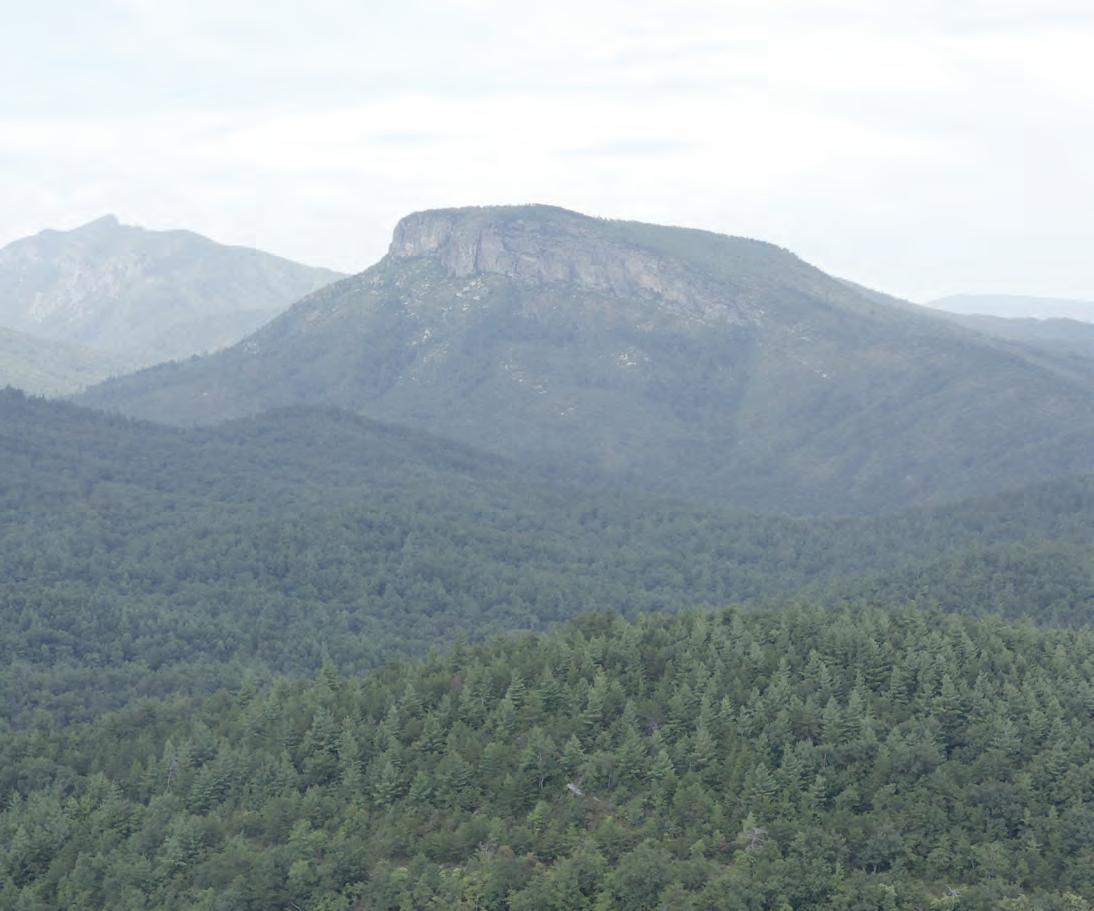
The North Toe River is located in Avery, Mitchell, and Yancey counties. The river extends for 4.5 miles within the study area and connects to Riverside Park in downtown Spruce Pine.
The Grandfather Ranger District of the Pisgah National Forest spans over 192,000 acres in McDowell, Burke, and Caldwell counties. Pisgah provides for several recreation uses including backpacking, mountain biking, road biking, fishing, rock climbing, and hiking.
Lake James is a 6,812-acre lake located in Burke and McDowell Counties. North Carolina State Parks manages Lake James State Park, which includes 25 miles of trails, 20 walk-in campsites, 33 drive-to campsites, and boat access.
CHAPTER 1 13
EXHIBIT 1: NATURAL RESOURCES ABOUND
THE BUILT ENVIRONMENT
The opportunities and constraints found within the built and human environment are critical for determining suitable and feasible trail locations, ideal user experiences, construction costs, and necessary permits.

This section highlights five (5) built environmental features and their implications for developing the OVNHT from Spruce Pine to Lake James, including: 1) Land Use; 2) Existing Trails and Parks; 3) Utilities; 4) Transportation; and 5) Historic Resources.

14
LAND USE SNAPSHOT
Blue Ridge Parkway

The Blue Ridge Parkway is a 469-mile national parkway stretching through North Carolina and Virginia that is managed by the National Park Service. The Parkway is a significant historical, preservation, recreation, and tourism resource that provides scenic views of the Blue Ridge Mountain Range. The plan study area crosses the Parkway in two different areas, including near the community of Little Switzerland and the National Park Service’s Museum of North Carolina Minerals.
Museum of North Carolina Minerals
The Museum of North Carolina Minerals features interactive exhibits and information that detail western North Carolina’s rich mineral resources and mining history. A segment of certified OVNHT intersects the museum property. The museum is located at Milepost 331 along the Blue Ridge Parkway and is open to visitors year-round.


Town of Spruce Pine
The Town of Spruce Pine (pop. 2,175) was founded in 1907 with the construction of the Clinchfield Railroad and rise of the regional coal mining industry. With the regional decline of the coal mining industry in the late 20th century, the Town has shifted to a tourism-focused economy. The Town is strategically located along the Blue Ridge Parkway and North Toe River and serves as the northern terminus of this plan’s study area.


Fonta Flora Brewery
The Fonta Flora Brewery at Whippoorwill Farm occupies nine acres of the historic dairy farm property while the remaining 40 acres have been conserved in perpetuity through a partnership between Foothills Land Conservancy and the NC Divison of Parks and Recreation. The pastureland that surrounds the brewery will eventually be transformed into a working and educational farm with annual gardens and fruit groves.
CHAPTER 1 15
“The town of spruce pine, the blue ridge parkway, and lake james State Park serve as significant anchor points for trail development within the study area's built environment.”
Photo by Others
Photo by Others
Pisgah Game Lands


The Rose Creek (536 acres) and Black Bear (893 acres) Pisgah Game Lands both lie within the study area corridor. These Game Lands are managed by the North Carolina Wildlife Resources Commission. Both game land tracts contain designated sections of the Overmountain Victory National Historic Trail. SOME
HISTORIC CORRIDOR
The Grandfather Ranger District of the Pisgah National Forest spans over 192,000 acres between the McDowell/Buncombe county line on Black Mountain to US 321 between Lenoir and Blowing Rock. The district is bounded on the north by the Blue Ridge Parkway. The National Forest is managed by the U.S. Forest Service, under the Department of Agriculture and provides for several recreation uses including backpacking, mountain biking, road biking, fishing, rock climbing, and hiking.
Riverside Park, Spruce Pine
Riverside Park, a 6-acre park located along the North Toe River in Spruce Pine, is the northern terminus of the planning section. The park features a 0.5-mile riverside walking trail, an amphitheater, baseball field, playground, and pedestrian bridge. Though the park is located outside of the 1-mile trail corridor, it serves as an anchor point to connect the OVNHT into Historic Downtown Spruce Pine. National Forest. Where feasible, existing MST infrastructure should be leveraged for OVNHT trail development






















Fonta Flora State Trail

The Fonta Flora State Trail (FFST) is a North Carolina State Trail that, upon completion, will connect Asheville to Morganton. Currently, 20 miles of the trail have been constructed around Lake James. Existing and planned FFST infrastructure surrounding Lake James should be leveraged for OVNHT development.

16
OF THESE MAJOR ASSETS INCLUDE:
THE STUDY AREA boasts a collection of parks, trails, and recreation destinations that are ideal connections for the ovnht.
N MARION
LAKE
N O R TH FORK C A T A WBA C ATAWBA
SPRUCE PINE
JAMES
RIVER
CANOE CREEK
LINVILLE RIVER CATAWBARIV E
LAKE
CANAL
PISGAH GAMELAND
PISGAH
RIVERSIDE PARK 226 226 221 19E 19E 221 105 105 126 blue ridgeparkway m ou n tains to sea trail HANKINSRD MOUNTAIN
LAKE
O V N HT
IRISH CREEK
R PISGAH NATIONAL FOREST LINVILLE GORGE WILDERNESS
JAMES STATE PARK
BRIDGE
RESERVE
GAMELAND RESERVE
INSTITUTERD
JAMESRD
0 1 2
Pisgah National Forest: Grandfather Ranger District
Lake James State Park

Lake James State Park is a 3,480-acre North Carolina State Park located along the shoreline of Lake James. The Park offers opportunities for hiking, mountain biking, picnicking, nature observation, swimming, and canoeing. The Park’s western edge lies within the OVNHT study corridor, providing a connection opportunity to this recreation resource.
UTILITIES
TRANSPORTATION



The incorporated towns located within the study area maintain a complex matrix of water and sewer infrastructure which, in many instances, are held in fee simple ownership by a public agency or have easements that can be modified to provide for trail development.
The analysis of the study area includes a review of public infrastructure and associated easements.

The analysis of the study area includes a review of the North Carolina and County Departments of Transportation (DOT) right-of-way (ROW), DOT plans, local bicycle and pedestrian infrastructure and plans, and railways.
DOT right-of-way was analyzed to determine where there could be opportunities for developing OVNHT side paths. These areas are shown on the Site Analysis Maps with corresponding opportunities and constraints notes.
CHAPTER 1 17
RAILROAD CROSSING AT NORTH COVE SCHOOL ROAD
Photo by Others
RESOURCES


LINK, PRESERVE,
The Overmountain Victory National Historic Trail Route and Corridor
The Overmountain Victory National Historic Trail route was identified by a National Park Service research team. The team relied on the 1881 account of the march, which has been amended by local historians, descendants of battle participants, and other sources. As part of this congressionally-designated trail, officially designated portions of the OVNHT must lie within or very near the one-mile corridor (half-mile on either side) of the historic route.
Historic Sites and Landscape
and interpreted as part of this study and subsequent trail development. Historical assets within the study area include the Downtown Spruce Pine Historic District and Gunter Building, both of which are highlighted on the subsequent map series.

18
The North Carolina State Historic Preservation Office (SHPO) oversees a large database of historic sites and resources. Many resources, including those related to the OVNHT, are included within the subsequent analysis map series. These resources include information from SHPO as well as sites related to the National Register of Historic Places (which the National Park Service oversees, but is managed by individual States). The most critical sites include those listed on the National Register (NR) or determined eligible (DOE) as they have further protection under Section 106 of the National Historic Preservation Act. The National Park Service has emphasized that historic/cultural resources should be linked, preserved, Sensitive Cultural Resources and Permitting: Any construction funded or permitted by the federal government will trigger project review by SHPO of any resources covered under Section 106 (National Historic Preservation Act). These resources could include human remains, burial sites, archeology sites, and historic sites. If it is found that the action of trail construction could potentially adversely affect cultural resources, the SHPO will work with the related Federal Agency to eliminate or minimize the effect. Historic Sites and Permitting: In general, a greenway would have complimentary relationship or no effect to preservation of these sites, but may require SHPO coordination in circumstances like alterations to historic bridges or whole properties. If federal funds or permitting is required, the SHPO will review this database and analyze for any adverse impacts.
HISTORIC
INTERPRET HISTORIC AND CULTURAL
“THE OVNHT SHOULD
AND
SITES ALONG ITS ROUTE.”
HISTORICAL ASSETS WITHIN THE STUDY AREA INCLUDE THE DOWNTOWN SPRUCE PINE HISTORIC DISTRICT AND THE GUNTER BUILDING (PICTURED ABOVE).
Photo by Others
MAP AND PHOTO SERIES: PRELIMINARY TRAIL ROUTE ALTERNATIVES















































































































The map and photographic series, which spatially in corporates the natural and built environment analysis, highlights a host of preliminary trail route alternatives. These routes were further refined by local leaders to identify and engage landowners. This information will serve as an ongoing reference guide as alternative routes may need to be developed due to unforeseen barriers.

CHAPTER 1 19
H W i N 6 ks Lentz C Amelia Jr L ew Mag ol B con Ridge W n Yan y La Cl D ep Wo d s H C m ycamo apt in Do ks d igG m ad C pp on rk bs V ew en z Ramsey Fork R ve Bar t Chariot Sailview Firestone vi e Nature Walk Willis Flynn Great Hill Lake Club LAKE JAMES STATE PARK PADDYCREEK NORTH FORK CATAWBA BEAR CREEK BAILEYCREEK SHOOKS CREEK JOHNS CREEK MCGEGERS BRANCH SANDY BRANCH OVNHTH STOR C CORRIDO plannedfontaflora OVNHTHISTOR C C RR DO 10 11 12 13 12 10 11 Dula Honeycutt D le S Huskin Doc How N 226 F EFarm Still Dover Carpenter D la ARMSTRONG CREEK DALESCREEK LIMEKILNCREEK RAGCREEK YELLOWFORK BLACK FORK PADDYCREEK THREEMILECREEK CANEY BRANCH TOMS CREEK HONEYCUTT CREEK CONLEY BRANCH ROARING FORK BRIDGE BRANCH ODEARCREEK LONONBRANCH STILLHOUSEBRANCH BUCHANAN CREEK MACE BRANCH LONGBRANCH BARTLETT CREEK MARTIN BRANCH SHOOKS CREEK P SGAH NAT ONAL FOREST MITCHELL COUNTY MCDOWELL COUNTY MCDOWELL COUNTY BURKE COUNTY LINVILLE GORGE 221 OVNHTHISTORIC CORR DOR OVNHT HISTORIC CORRIDOR BLUERIDGEPARKWAY CHURCH OF THE RESURRECTION NORTH CAROLINA CONSERVATION TRUST 2 4 7 2 10 12 13 14 B u R d e D Dul At p ss Ha lto n Oa Ro dge O h r d e pp rsC k V u gh C n k on w Ap L l Hum b M Po d Ho ey tt Ha s B ge a c o Elm G woo Hen ed Pla C 2 Sum D v o a Nc 226 Wppre h Crystal C ge B v C eek mp Mo t F a in T w n G rland T l r O am H e Ho y Da e Jims Sta ord La k R k H u C ek F r tFsh r B a Cub S th o k d g Woods Oveloo S ssPn L idd Ettas C ed P Chapel R nR ge Am P n m F n E m ey Fairway Rogers Wal Broad R K b H nn Berry Still Woodland Ca n S B an h Swo ord Alp ne Greenlee ax Honeys k Hall Store Doc Howell Pitt ar h W M y M m l i Pe H ti W m a e a h Pend e Jo Fox en Dover n h B D Mou ta n Be J k o ToeRiver H fi Ellis Ly W t B igh s Le Wya k gh P nd osa Brown Laurel Riverside Minpro ko yH Savanna Hidden Cli Breezy A pa C ch God Almalene Cline Wallace Rocky Ridge Willis Oakdale Allen Stonewood Di-Carve Horizon Lawson Faith ScottHollow Boone Muscadine o ge M Knn y Brittany Mary Ann Dogwood F e ma Laurel Hill Cardinal Kaywilla Maple Patty Gregg Pinehaven WindyHill Lentz Woody Dan Phillips D a D l Vaughn B ue R g Pon Dale 221 NORTHTOERIVER GRASSY ROSES CREEK HARRISCREEK PEPPER ROCKHOUSECREEK CATHIS CREEK LITTLE ROSE CREEK GRAVEYARDCREEK 19E MITCHELL COUNTY MCDOWELL COUNTY AVERY COUNTY NORTH CAROLINA CONSERVATION TRUST/ PISGAH GAMELAND NC DEQ DIVISION OF MITIGATION SERVICES EASEMENT THIS PORTION OF HISTORIC CORRIDOR OUTSIDE STUDY AREA NC FOOTHILLS CONSERVANCY NORTH CAROLINA CONSERVATION TRUST PISGAH GAMELAND PISGAH NATIONAL FOREST BLUE RIDGE PARKWAY TOM SWEENEY PROPERTY GUNTER BUILDING TIM SWEENEY PROPERTY TOE RIVER VALLEY PARTNERSHIP PROPERTY GREENLEE PRIMARY MITCHELL COUNTY OPEN SPACE SPRUCE PINE ovnht his oric corrdor 3 8 12 13 14 15 10 11

























































20 Blu e R i d g e Dale Dula AltapassHalltown Oak Ro an R i dge Orchar d P e ppersCreek Vau ghn C abin Jackson Town Appl e Linville Hum pback Mo u ntain Pon d Honeycutt Harris Biggersta McHone Elm G reenwood Henredon Plant C 226 Sum mit Davenport M ica Nc 226 S Wipprecht Crystal C a dge Beaver Creek Tempie Mountain Franklin Tow n Garland Telle r Ol is am Hefner Holly Dale Jims Sta ord Larkin Ro c k H ouse Creek ForrestFisher Bear Cub S m ith Rock l edge Woods Overlook SwissPine Lake iddix Ettas Creed P Chapel Pine Run Ridge Amit y P a r k Va n ce Farm Fun EFarm ey Fairway Rogers Walter Broad Ri chKnob Hannah Berry Still Woodland Carp enter Sullins Branch Swo ord Alp ne Greenlee ax Honeysuckle Hall Store Doc Howell Pitt Martha WsMoody Memorial Six Pence Hattie Williams Jakes Branch Pendley Jol Fox Den Dover B r a nch Bear Den Mountain Bell Jakes Rock ToeRiver Hollifield Ellis Lynn Watson Brights Lee Wyatt R o c ky H igh Ponderosa Brown Laurel Riverside Minpro Hicko ryHill Savanna Hidden Cli Breezy A tapass ChurchofGod Almalene Cline Wallace Rocky Ridge Willis Oakdale Allen Stonewood Di-Carve Horizon Lawson Faith ScottHollow Boone Muscadine G eorge McKinney Brittany Mary Ann Dogwood Freeman Laurel Hill Cardinal Kaywilla Maple Patty Gregg Pinehaven WindyHill Lentz Woody Dan Phillips Dale Dale Dula Vaughn Blue Ridge Ponder o s a Dale 221 NORTHTOERIVER GRASSY CREEK ROSES CREEK HARRISCREEK PEPPER CREEK ROCKHOUSECREEK CATHIS CREEK LITTLE ROSE CREEK SMITH BRANCH GRAVEYARDCREEK 19E MITCHELL COUNTY MCDOWELL COUNTY AVERY COUNTY NORTH CAROLINA CONSERVATION TRUST/ PISGAH GAMELAND NC DEQ DIVISION OF MITIGATION SERVICES EASEMENT THIS PORTION OF HISTORIC CORRIDOR OUTSIDE STUDY AREA NC FOOTHILLS CONSERVANCY NORTH CAROLINA CONSERVATION TRUST PISGAH GAMELAND PISGAH NATIONAL FOREST BLUE RIDGE PARKWAY TOM SWEENEY PROPERTY GUNTER BUILDING TIM SWEENEY PROPERTY TOE RIVER VALLEY PARTNERSHIP PROPERTY GREENLEE PRIMARY MITCHELL COUNTY OPEN SPACE SPRUCE PINE ovnht historic corridor 1 2 6 7 8 9 1 2 3 4 6 8 9 12 13 14 15 7 10 11 MAP 3: STUDY AREA 1 SITE ANALYSIS OVNHT and other Recreation Federal; State; Local Government Historic Landmark Site Managed Lands Hydrography Floodzone OVNHT 1 Mile Historic Corridor Existing Trail Constraint Opportunity LEGEND STUDY AREA 1 SITE ANALYSIS
STUDY AREA 1 OPPORTUNITIES & CONSTRAINTS
OPPORTUNITIES
Conservation property
Existing river crossing at Riverside Park

Existing paved greenway path extends south from Riverside Park

Cooperative or willing landowners

Existing river realignment project at Grassy Creek

Toe River Valley Partnership-owned property next to Grassy Creek with existing trail



Existing OVNHT through Pisgah Gameland
Connection opportunity to Greenlee Primary School
Low traffic road with room for sidepath
Blue Ridge Parkway and parkway overlook connec tion at Heffner Gap
Large tracts of property managed by the Conservation Trust of North Carolina.
Existing stormwater basin and clearing around back side of Walmart
Existing social path connecting parcels along 226 to back corner of Walmart
Open space and undeveloped properties for sale
Road corridor along Swafford Rd. wide enough for sidepath
CONSTRAINTS
Narrow road corridor and steep topography
Tight parcelization and steep topography
Narrow road through industrial use parcels
Narrow road corridor and private properties
Tight private parcelization
Narrow road corridor and steep topography
Tight parcelization and steep topography connecting Greenlee Primary School and Old 226
Blue Ridge Parkway road crossing
Railroad crossing necessary
CHAPTER 1 21
1 1 2 2 3 3 4 4 5 5 6 6 7 7 8 8 9 9 10 11 12 13 14 15
Narrow road corridor leaving town on Altapass HWY; passes through industrial use area
Narrow road corridor and steep topography sandwiched between dense parcels and railroad on 226/Roan Rd. Tight parcelization and steep topography connecting Greenlee Primary School
and Old 226
Rotary Club owned property next to Grassy Creek with existing trail
Blue Ridge Parkway and parkway overlook connection at Heffner
Gap
3 1 7 6 10 2
Existing North Toe River crossing at Riverside Park



































22 Dula Honeycutt Dale Swaffo rd Huskin Doc Howell Nc 226 Fun EFarm Still Dover Carpenter Dula COX CREEK ARMSTRONG CREEK DALESCREEK LIMEKILNCREEK RAG CREEK YELLOWFORK BLACK FORK PADDY CREEK THREEMILECREEK CANEY BRANCH TOMS CREEK HONEYCUTT CREEK CONLEY BRANCH ROARING FORK BRIDGE BRANCH ODEARCREEK LONONBRANCH STILLHOUSEBRANCH BUCHANAN CREEK MACE BRANCH LONGBRANCH SYCAMORE BRANCH BARTLETT CREEK MARTIN BRANCH SHOOKS CREEK PISGAH NATIONAL FOREST MITCHELL COUNTY MCDOWELL COUNTY MCDOWELL COUNTY BURKE COUNTY LINVILLE GORGE 221 OVNHTHISTORIC CORRIDOR OVNHT HISTORIC CORRIDOR BLUERIDGEPARKWAY CHURCH OF THE RESURRECTION NORTH CAROLINA CONSERVATION TRUST 1 2 3 4 7 5 1 5 9 7 8 6 2 3 4 10 12 9 13 14 MAP 4: STUDY AREA 2 SITE ANALYSIS OVNHT and other Recreation Federal; State; Local Government Historic Landmark Site Managed Lands Hydrography Floodzone OVNHT 1 Mile Historic Corridor Existing Trail Constraint Opportunity LEGEND STUDY AREA 2 SITE ANALYSIS
STUDY AREA 2 OPPORTUNITIES & CONSTRAINTS
OPPORTUNITIES
Existing OVNHT trail and opportunity for trailhead development at the Museum of NC Minerals
Large mostly undeveloped parcels
U.S. National Forest land

Large undeveloped tract
Large undeveloped parcels
Existing road bed leading into National Forest near the end of Good Rd.
Mountains to Sea Trail connection
Existing river and railroad crossing on Mountains to Sea trail
Large mostly undeveloped parcel
Existing trail extends south to Mountains to Sea trail


NC Foothills conservancy property
Mountains to Sea Trail connection
Old forest roads/gravel roads near Old HWY 105
CONSTRAINTS
Large undeveloped tract adjacent to US National Forest land is outside historic corridor
HWY 221 crossing options limited (4 lanes)
Bridge too low for HWY 221 underpass
Tight parcelization along Good Rd.

Railroad crossing
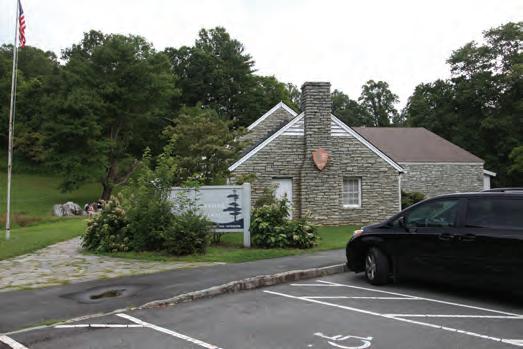
US Highway 221 crossing
Railroad crossing
Narrow road corridor; tight private parcelization; and numerous driveway cuts
Private property and no trespassing sign at trail entrance
Existing
Bridge too low for HWY 221 underpass
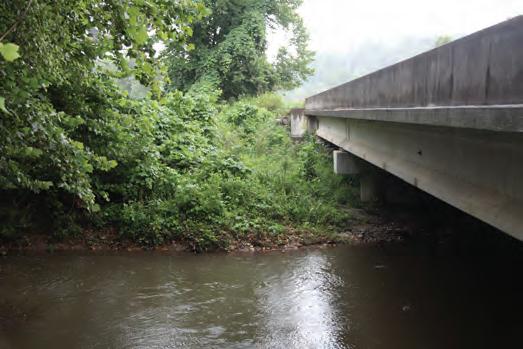
CHAPTER 1 23
1 1 2 2 3 3 4 4 5 5 6
7 7 8 8 9 10 11 12 13
6
Railroad crossing cannot be avoided
Private property and no trespassing sign at trail entrance along Old Linville Rd.
Existing road bed leading into National Forest near the end of Good Rd.
trail and opportunity for trailhead at mineral museum 3 7 9 6 1 9































24 Hankins W i l dlife Nc 1 26 a rks Lentz Club Amelia Jr Lakeview Magnolia Beacon Ridge Waterg lyn Yancey LakeClub Deep Wood s HighCamp s SycamoreCaptains Dockside BigGame ad Cappezion rk obsonView LentzLanding Ramsey Fork River Bartlett Chariot Sailview Firestone Rivervi ew Nature Walk Willis Flynn Great Hill Lake Club LAKE JAMES STATE PARK PADDYCREEK DALES CREEK NORTH FORK CATAWBA RIVER BEAR CREEK BAILEYCREEK SHOOKS CREEK JOHNS CREEK MCGEGERS BRANCH SANDY BRANCH LIMEKILNCREEK ARMSTRONG CREEK BURKE COUNTY MCDOWELL COUNTY OVNHT HISTORIC CORRIDOR mountainsto sea trail plannedfonta flora OVNHT HISTORIC CORRI DOR 221 1 3 2 5 4 10 7 6 9 11 12 1 4 3 5 7 6 13 12 10 11 8 9 2 MAP 5: STUDY AREA 3 SITE ANALYSIS OVNHT and other Recreation Federal; State; Local Government Historic Landmark Site Managed Lands Hydrography Floodzone OVNHT 1 Mile Historic Corridor Existing Trail Constraint Opportunity LEGEND STUDY AREA 3 SITE ANALYSIS
STUDY AREA 3 OPPORTUNITIES & CONSTRAINTS
OPPORTUNITIES
Pisgah Gameland and existing trail
Planned Fonta Flora Trail alignments
Black Bear Campground connectivity


Bear Creek Marina connectivity
Connection to public land (Pisgah National Forest)
Large tracts of land
Potential willing landowners
Potential lakeside trail
Potential willing subdivision

Willing landowner at Campbells Trace

Existing Fonta Flora Brewery and shared OVNHT/ Fonta Flora trailhead
Existing OVNHT connection that connects to Fonta Flora Brewery
Large tracts
CONSTRAINTS
Federal land connection to Pisgah Gameland leads trail outside corridor



Marina/campground access lacks pedestrian and cyclist infrastructure
Narrow bridge shoulder over Bailey Creek
Narrow bridge shoulder over Bear Creek
Private subdivisions
Route diverges from lakeshore
Small lakeside parcels
Existing trail in poor condition
Tight parcelization and mulitple road crossings
Narrow road shoulder
Tight parcelization and narrow road corridor
Gravel road ends and paved road begins
CHAPTER 1 25
1 1 2 2 3 3 4 4 5 5 6 6 7 7 8 8 9 9 10 10 11 11 12 13
Private residential development presents a significant barrier to a trail alignment along the lake shore
Old
5 8 12 11 4 12
10
Existing OVNHT at Campbell’s Trace requires improvements
NC 105 gravel road ends and a paved road through private properties begins Connection to Fonta Flora Brewery and shared Fonta Flora/OVNHT shared trailhead Trail connectivity to Bear Creek Marina is possible.
Positive landowner at Campbell’s Trace

26
CHAPTER 2
LANDOWNER ENGAGEMENT
LANDOWNER
OUTREACH AND ENGAGEMENT Are KEY Components OF THE OVNHT PLANNING PROCESS.
The environmental analysis (Chapter 1) was critical for determining physically feasible areas for trail development. However, significant portions of these routes impact private property and require landowner outreach to fully assess trail feasibility. This chapter highlights a good-faith effort to engage landowners throughout the planning process.



THE ENGAGEMENT PROCESS
Identifying the Landowners


Landowner Communications
Landowner Workshop
Trail Route Re-evaluationnd constraints found within the natural environment are




28 68 76 76 81 81 81 77 78 63 69 73 79 79 79 75 80 82 82 74 74 74 74 74 74 74 59 72 53 53 45 45 45 55 49 CWMTF Eas CTNC Eas Blue Ridge Parkway CTNC Pr Blue Ri dge Pkwy Eas A rmstrong F H Blu e R dge Dul a Pe p p e r s C r e e k Alpine Dale American Thread Armstro ng C r e e k Ollis Good S w affo d DC Johnson Lynn Gap La u e Nc Doc Ho we l Ce Goo d e Glory Bearwallow Y ellow M o u n ai n Stockton Fun EF Chestn u t G ove Fox Run M a tin Branch Augtusta High Ridge Waites Ho f e d Cox Triple S prings H o if eld Miracle Ep Boyd Afternoon LookingRock Cobra Blands Knob VelvisHollifield Valley Farm Ponder o s a Limek l View Dob son Knob Coxes CreekChurch Luga noStrass Devil Face Luce n e Strasse Farm Hill Bluebird Ginseng Ba e te Taylor-Made TripleJ Park Eastridge Leather wood D u bose Greenlee M G ac e Green e e Hidden Forest Reid Queen V alley Moonlight M w Maces P a rk Scrub Grass Hidden Look Out Pos t Office Red Fox Grand Oaks Callaway Blue Ri dge Du la Orchard 221 SR226 SR1566 SR1559 SR110 6 SR 1 1 11 SR1558 SR1 1 0 0 S SR1446 SR1420 S R1561 SR1564 SR1279 SR1112 SR1573 SR1441 SR226 MITCHELL COUNTY Cox Creek ArmstrongCreek Creek Limekiln Creek Rag Creek Grassy Three Mile Creek CaneyBranch Conley Branch Lonon Branch Roaring Fork ODear Creek Buchanan Creek Van Noy Branch Mace Branch LongBranch Sycamore Branch Martin Branch BartlettCreek OVNHT: Spruce Pine to Lake James Landowner Parcels Railroad Town Boundaries Federal Ownership State Ownership Legend: MILE-WIDE HISTORIC CORRIDOR IDENTIFY THE L ANDOWNERS MAP 6: LANDOWNER MAP SAMPLE Feasibility Analysis. Trail alternatives were developed based
an environmental feasibility analysis. Landowner
mailing database was
that
property owners
trail alignment(s). STEP 1: DETERMINE WHERE THE TRAIL IS FEASIBLE (CHAPTER 1) STEP 2: START A CONVERSATION WITH LANDOWNERS.
upon
Database. A
created
included all
within the preliminary
LANDOWNER COMMUNICATIONS

Video Production. A custom video, specifically produced for landowners, highlighted the story of the Overmountain Victory National Historic Trail and made an appeal for landowner participation.






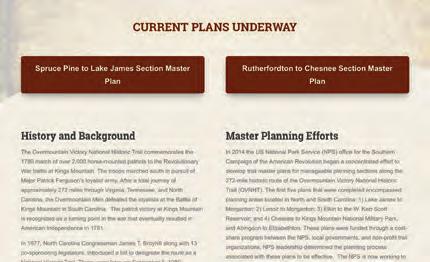

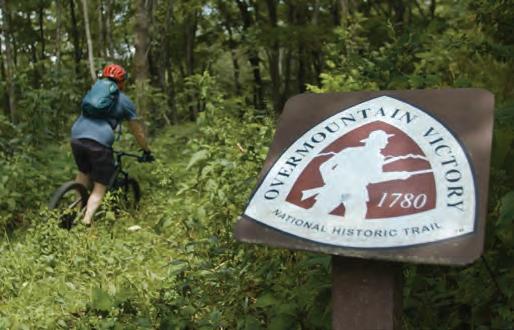
Web Portal. The project website, www.OVTplan.com, provides information about the planning process and features the landowner outreach video.
Landowner Invitation. Formal invitations were sent to all landowners included in the landowner database directing them to the website and requesting their attendance at a special meeting.
LANDOWNER INVITATON
WEB PORTAL
VIDEO PRODUCTION

being located within or near the historic Overmountain corridor where the trail could potentially be created as shown on the enclosed map.
We are inviting you to discuss the possibility of your willingness to consider working with us to make this trail a reality. Please be assured that any and all involvement on your part will be totally on volunteer basis. If you wish to participate, we will love to have you. Or you may choose not to at this time, but we sure would like for you to see the benefits to your family and our area before you make any decision.
Please visit the project website, www.OVTplan.com to learn more and view the project video.
Please join us and representatives from the National Park Service at this special meeting: September 26th at pm Cross Street Commerce Center 31 Cross Street Spruce Pine, NC 28777

If you plan to attend the meeting or if you would like additional information, please contact us at info@OVTplan.com or 828.386.1866 Sincerely,
Overmountain Victory Trail Planning Committee

CHAPTER 2 29
PO Box 782, Spruce Pine, NC 28777 828.284.9818 hartselljonathan@gmail.com Dear Mitchell County Neighbor, The Overmountain Victory Trail Association has partnered with the National Park Service and local Mitchell County and Spruce Pine government leaders to create a unique historical, educational, and recreational project for Mitchell County. Among other exciting possibilities, it will include a public walking and biking trail that will connect Spruce Pine to Lake James. This trai will celebrate the march of the Overmountain Men who won major Revolutionary War battle in 1780 at Kings Mountain, South Carolina. The patriot victory is considered a turning point in the war that resulted in American independence. The proposed trail will help preserve this history, expand health and recreational benefits for residents, and expand economic development for all of Mitchell County. The project planning team has identified areas where the trail would be feasible and meet the requirements of the Overmountain Trail development. After months of analysis, your property has been identified as
LANDOWNER WORKSHOP


Video Screening. After signing in, the landowner workshop began with a viewing of the custom video.
Focus Groups. Various focus groups were set up around the room in which landowners could ask questions about their specific property and the associated trail alignment.
Sentiment Card.
Before landowners left, they were encouraged to fill out a landowner sentiment card describing their level of interest for providing for the trail.

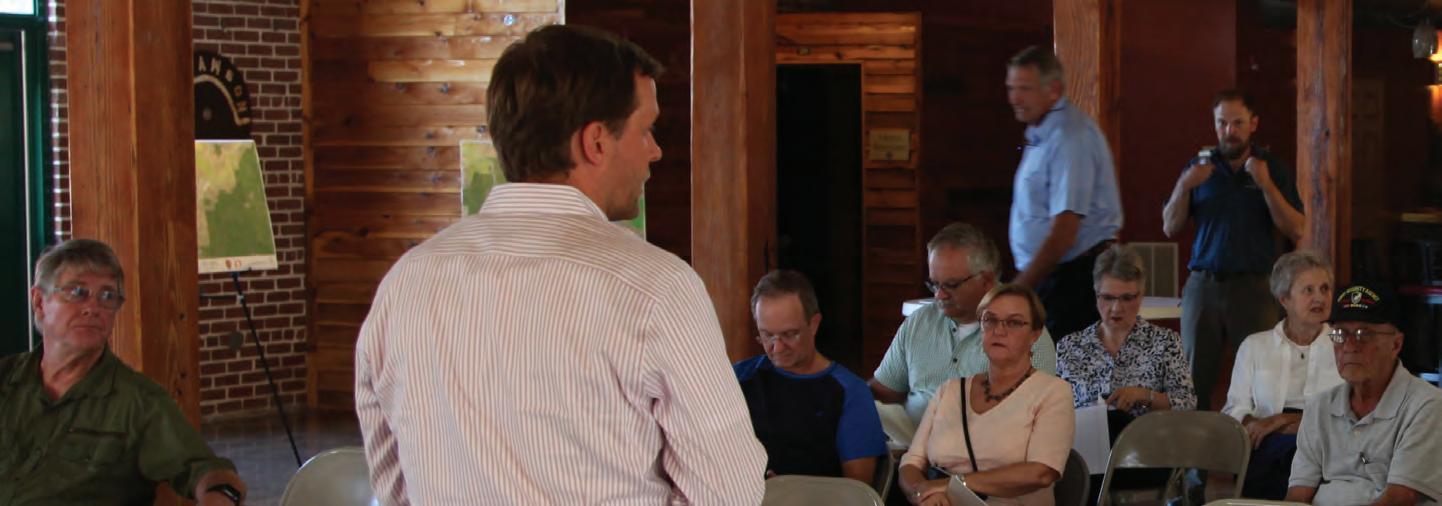


Follow up Contact. DbD staff continued to follow-up with landowners throughout development of the plan document, and adjusted plan recommendations accordingly.

30
Outreach efforts included engaging approximately 20 landowners by phone, email, or in person at the September 26th and 30th LANDOWNER WORKSHOPS HELD AT the Cross Street Community Center in Spruce Pine and the Mcdowell county administration building.




CHAPTER 2 31















32
MCDOWELLCOUNTY
BURKE COUNTY
MITCHELLCOUNTY
MCDOWELL COUNTY
221 221 LAKE JAMES lu e ridgeparkway LINVILLE RIVER NORTHTOERIVER LINVILLE GORGE WILDERNESS AREA FONTA FLORA BREWERY CANAL BRIDGE mile-wide historic corridor TRAIL
Revise Trail Alignments.
was helpful in determining the preferred alignment and is included as a
the
series
MAP 7: LANDOWNER SENTIMENT A COMBINATION OF FACTORS INCLUDING THE NATURAL ENVIRONMENT, THE BUILT ENVIRONMENT, AND LANDOWNER SENTIMENT WERE USED TO DETERMINE THE PREFERRED TRAIL ALIGNMENT (CHAPTER
SPRUCE PINE
ROUTE RE-EV ALUATION
“Landowner Sentiment”
component of
final map
(Chapter 4).
4).
CHAPTER 3
TRAIL CHARACTER & DESIGN GUIDELINES

THIS CHAPTER PROVIDES
DESIGN DETAILS FOR VARIOUS TRAIL TYPES and SIGNAGE, AND ALSO OFFERS INSIGHTS FOR INCORPORATING SOCIAL MEDIA.
Between Spruce Pine and Lake James exist a diverse natural and built environment. Specific trail types must be applied throughout the corridor to ensure minimal maintenance and the best user experience.
This Chapter defines five trail types and describes their tread features and general specifications for construction.
A specific theme is presented for signage, wayfinding, and trail support facilities. Previous OVNHT Master Plans recommend identical trail branding to provide uniformity and recognition throughout the trail corridor.
IN THIS CHAPTER
A. Trail Types
B. Signage and Wayfinding
C. Social Media Marketing
TRAIL TYPES
Five trail types are proposed along the preferred alignment. A specific trail type is proposed according to its surrounding environment, location in a rural or urban area, and the opportunity to create a meaningful user experience.
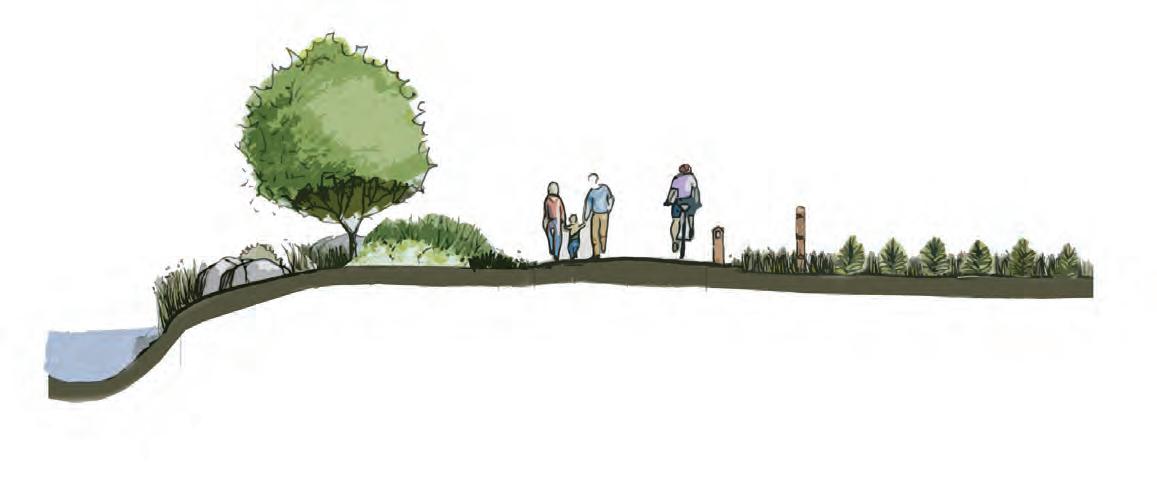
DOT SIDE PATH

8’ PAVED ASPHALT
User Group: Multi-use
Material: Paved Asphalt
Preferred Width: 8’
Average Construction Cost: $120/ln. ft.
Preferred Easement Width: 25’
Minimum Easement Width: 25’
*Note: Trail to be approved in accordance with NCDOT or County DOT encroachment agreement.
TOWN SIDEPATH
10' CONCRETE
User Group: Multi-use
Material: Concrete
Preferred Width: 10'
Average Construction Cost: $90-$100/ln. ft.

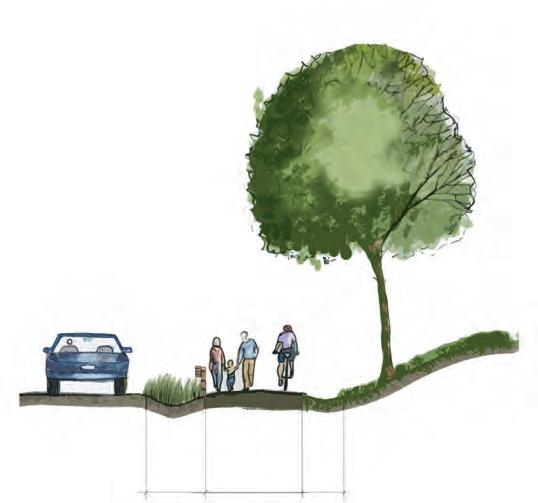
Preferred Easement Width: 25' or within public right-of-way
Minimum Easement Width: 25' or within public right-of-way

TYPICAL GREENWAY
10’ PAVED ASPHALT
User Group: Multi-use
Material: Paved Asphalt
Preferred Width: 10’
Average Construction Cost: $90/ln. ft.
Preferred Easement Width: 50’
Minimum Easement Width: 20’
34
30’ PREFERRED BUFFER TO RIVER TO PROTECT WATER QUALITY 10’ PAVED ASPHALT MILE MARKER FENCING TO MARK PRIVATE PROPERTY BOUNDARY
DUAL-USE PATH
8’
CRUSHED GRAVEL FINES
User Group: Hikers and Cyclists
Material: Crushed Gravel Fines
Preferred Width: 8’
Average Construction Cost: $60/ln. ft.
Preferred Easement Width: 50’
Minimum Easement Width: 10’
NATURAL SURFACE
3-6’ NATURAL TREAD
User Group: Hikers and Mountain Bikers
Material: Native Soil

Preferred Width: 3’ - 6'
Average Construction Cost: $10/ln. ft.
Preferred Easement Width: 25’






Minimum Easement Width: 10’
Due to the rural location of the trail between Spruce Pine and Lake James, a natural surface trail type is proposed along many sections. This trail type will provide users with a more natural experience in these undeveloped areas and provide trail connections at a lower overall cost.

CHAPTER 3 35 SURFACE
CRUSHED GRAVEL FINES
6
3
SIGNAGE AND WAYFINDING
The OVNHT signage family provides for a modern-rustic theme and incorporates materials consisting of metal, rock, and concrete. The signage family serves as a template and can be altered and refined depending on local preferences and specific site needs. Signage marking the physical trail is required to include the official OVNHT logo of the NPS.


36
Monument Sign
Trailhead IDBreak-away sign for use along DOT roads

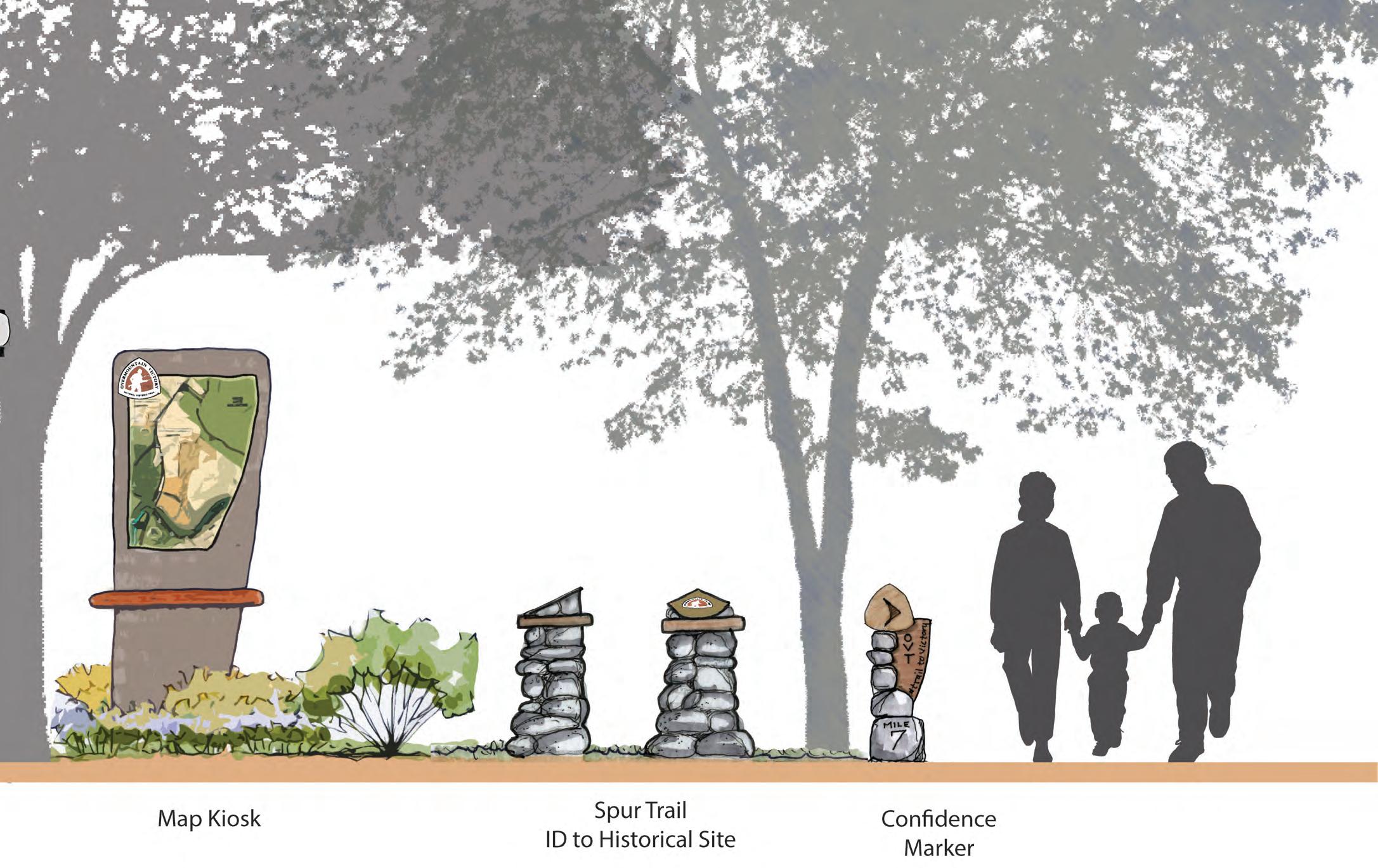
CHAPTER 3 37
SOCIAL MEDIA: THE NEW WORD OF MOUTH







Trail users should be encouraged to utilize social media to share their experiences with their friends and “followers”. Special signage along the trail will signal users to consider posting pictures of themselves or their friend groups as they walk or ride bikes along the trail. In addition, special photo opportunities and features should be developed during the final design phase. After all, who better to market this destination-quality trail than the users themselves? Take advantage of social media – the new word of mouth.
#TRAIL2VICTORY
The proposed official hashtag for the OVNHT is #trail2victory. The use of this hashtag will allow local tourism leaders to curate local photography and content that can be shared on websites and re-posted through other social media platforms.

#FINDYOURPARK
“Find your park” is the official centennial campaign of the National Park Service. The NPS is encouraging national park enthusiasts to use the hashtag #findyourpark when posting to social media. The OVNHT can help continue this campaign for years to come by encouraging the use of this hashtag at unique locations along the trail.
“FIND YOUR PARK” IS THE OFFICIAL CENTENNIAL CAMPAIGN OF THE NATIONAL PARK SERVICE. THE NPS IS ENCOURAGING NATIONAL PARK ENTHUSIASTS TO USE THE HASHTAG #FINDYOURPARK WHEN POSTING TO SOCIAL MEDIA.
38
TRAIL USERS SHOULD BE ENCOURAGED TO UTILIZE SOCIAL MEDIA TO SHARE THEIR EXPERIENCES WITH THEIR FRIENDS AND “FOLLOWERS”.
101
dbdplanning great
county #wnc
Spruce Pine, NC
likes
day on the #trail2victory at the NC Minerals Museum # ndyourpark #mitchell
2: SOCIAL MEDIA THE NEW WORD OF MOUTH
EXHIBIT
CHAPTER 4
IN THIS CHAPTER

RECOMMENDATIONS THIS CHAPTER SERVES AS THE HEART OF THE SPRUCE PINE TO LAKE JAMES OVNHT MASTER PLAN.
A. Overview of Planning Section Maps B. Planning Section Descriptions
PLANNING SECTIONS












The 43-mile study area from Spruce Pine to Lake James is divided into six (6) planning sections. The geographic extent of each section includes a beginning and ending terminus that features a key asset or significant connectivity point for the trail. Each planning section includes project areas that can be developed independently over time, providing a logical method for implementation as landowner willingness, funding, and other opportunities arise.

40
SPRUCE
221 221 LAKE JAMES blu e ridgeparkway LINVILLE RIVER NORTHTOERIVER LINVILLE GORGE WILDERNESS AREA FONTA FLORA BREWERY CANAL BRIDGE mile-wide historic corridor 1 2 3 4 6 5
BURKE COUNTY MCDOWELLCOUNTY MITCHELLCOUNTY MCDOWELL COUNTY
PINE
PLANNING
MAP 8: PLANNING SECTIONS The study area from SPRUCE PINE to LAKE JAMES is divided into SIX (6) planning sections; this chapter is organized accordingly.
SECTIONS
ABOUT THE PLANNING SECTION MAPS








Each planning section is anchored by a map that highlights proposed trail routes, existing designated trail, trail features, and landowner sentiment. The proposed routes are identified as either preferred historic, alternate, or existing local. These trail alignments are the result of extensive analysis, including environmental feasibility, landowner willingness, and insights provided by the National Park Service, local government and local trail-development leaders.

The National Trails System Act states that “a designated trail should generally accurately follow the historic route, but may deviate somewhat on occasion of necessity to avoid difficult routing through subsequent development, or to provide route variations offering a more pleasurable recreational experience.”5 In accordance with this directive, the trail is planned as close as possible and practicable within the one-mile Historic Corridor. Where trail construction is not feasible within the Historic Corridor, the NPS may recognize routes outside the corridor as preferred alignments. Such routes are planned for the greatest public benefit and enjoyment, as well as to promote tourism, economic development and rural prosperity.
The NPS refers to routes outside the Historic Corridor as alternate routes to the historic route. In some locations, the preferred routes identified in this chapter are located outside of the Historic Corridor. Such routes can be marked and signed the same as routes within the Historic Corridor, but must provide on-site interpretation that indicates the known historic trail location and provides justification for construction of the































trail outside of the Historic Corridor.
Noted trail features include the physical infrastructure and facilities that support the proposed trail. These features are highlighted along the preferred routes and provide critical information for developing an estimate of probable cost for each section. These features include trailheads and crossings associated with either a road or water feature. Trailheads will provide for parking and trail user orientation. Road crossings indicate the need to provide for traffic calming measures and appropriate signage for both trail users and motorists. Major bridges indicate a significant stream or river crossing that requires a bridge greater than 20 feet in length. A minor bridge/ culvert demonstrates the need to cross a relatively small stream; at this broad level of planning, it remains uncertain whether a small bridge or culvert is necessary.
QUICK FACTS
Each planning section begins with a “quick facts” exhibit. This information includes the existing and proposed trail distances, trail type, and key features and assets associated with each section. Also, an estimate of probable cost is noted; see the appendix for further details. Reported numbers for length and cost include preferred routes in the planning section.
CHAPTER 4 41
%% 7 8 Pond Harris McHone Greenwood Alpine Smith SwissPineLake Spring RichKnob Honeysuckle Bailey SunriseRidge Doc Howell Bell CreedPitman Dogwood Jakes Rock Hidden Springs Watson Blands Knob HighRidge HiddenCli Terrace Lucerne Strasse Meadowlark Horizon Lawson Robie Sonshine Conasoga BlueRidgeEstates Simmons Ridge Pinehaven White Oak Hemlock Blue Ridge Bailey Woodland Boone GRASSYCREEK NORTHTOERIVER HONEYCUTT CREEK ROSES CREEK PEPPER CREEK ROCKHOUSE CREEK CATHIS CREEK SMITH BRANCH 221 19E MITCHELL COUNTY DCM O WELLCOUNTY GREENLEE PRIMARY SCHOOL HALLTOWN RD TRAILHEAD GRASSY CREEK TRAIL ALIGNMENTS GRASSY CREEK TRAILHEAD PISGAH GAMELANDS EXISTING ROSE CREEK TRAILHEAD PRIVATE CONSERVATION HEFFNER GAP TRAILHEAD EXISTING RIVERSIDE PARK TRAILHEAD JACKSON KNOB COVE TUNNEL CROSSING LB U E RIDGE PARKWAY MUSEUM OF NC MINERALS TRAILHEAD SECTION
RIVERSIDE PARK BLUE RIDGE PARKWAY 0 0.5 1
1
EACH PLANNING SECTION IS ANCHORED BY A MAP THAT HIGHLIGHTS PROPOSED TRAIL ROUTES, TRAIL FEATURES, AND LANDOWNER SENTIMENT. i BY THE NUMBERS SPRUCE PINE >> LAKE JAMES EXISTING TRAIL: 2.5 MILES PROPOSED TRAIL: 9.6 MILES TRAIL TYPE: DOT SIDEPATH TYPICAL GREENWAY NATURAL SURFACE DUAL USE PATH ESTIMATED COST: $ 2,787,820 POINTS OF INTEREST: DOWNTOWN SPRUCE PINE RIVERSIDE PARK GRASSY CREEK GREENWAY COUNTY MCDOWELLCOUNTY MITCHELLCOUNTY COUNTY SPRUCE PINE LINVILLE RIVER NORTHTOERIVER 1 2 4 6 5 VICINITY MAP SPRUCE PINE BLUE RIDGE PARKWAY 5National Trails System Act, Section 5(b), Part 11(a). The NTSA provides regulations for the management of National Historic Trails. 13.4 >> EXISTING TRAIL MILES 42.9 >> PROPOSED TRAIL MILES 17 >> TRAILHEADS 29 >> ROAD CROSSINGS 3 >> MAJOR BRIDGES 20 >> MINOR BRIDGES/CULVERTS $5.5 M >> APPROXIMA TE COST
SECTION 1 PROPOSED TRAILS














The preferred-historic route extends along two corridors from Riverside Park in Spruce Pine to the Blue Ridge Parkway.
The eastern corridor comprises approximately 4.8 miles. Exiting Riverside Park east via the Spruce Pine Footbridge, the trail briefly follows the existing sidewalk along Locust Street and Oak Avenue before turning south on Altapass Highway.
A town sidepath must be developed to safely accommodate trail users along this road. After crossing NC Highway 226, the trail continues along the CSX railroad corridor as a typical greenway before returning to Altapass Highway. At Carpenter Island Road, the trail transitions to a dual-use path that parallels the North Toe River before passing underneath the railroad. After crossing the River, the route continues east as a natural surface trail to Halltown Road and crosses the CSX railroad on Holman Hill Road where it enters the Pisgah Gamelands. The trail crosses Altapass Highway and follows a certified OVNHT segment that utilizes the Rose Creek Trail for 1.5 miles to its terminus on the Blue Ridge Parkway at Hefner Gap.
The western corridor extends approximately 4.1 miles. Exiting Riverside Park from its southern entrance, the preferred route extends south as a typical greenway along Riverside Drive and transitions to an overland trail connecting to Summit Avenue. The trail continues as a DOT side path parallel to Summit Avenue until it connects with Spruce Pine Memorial Cemetery. It briefly changes to a dual-use path through town owned property and transitions to a natural surface trail as it descends to the Grassy Creek Trailhead. After crossing Carters Ridge Road, a dual use trail continues south along Grassy Creek to connect to Greenlee Primary School. The trail transitions to natural surface as it travels south and east over mostly undeveloped parcels before it connects to the existing Orchard Trail section of the designated OVNHT. Due to significant parcelization within the historic corridor between Greenlee Primary School and the Blue Ridge Parkway and to utilize existing certified OVNHT, the preferred historic route leaves the corridor briefly. The existing Orchard Trail remains on the north side of the Blue Ridge Parkway and extends
approximately one mile to the Museum of NC Minerals.
TRAIL FEATURES

This planning section includes four (4) trailheads, two (2) major bridges, four (4) minor bridges, and sixteen (16) road crossings.
TRAILHEADS
The northern terminus of this planning section is at Riverside Park in Spruce Pine. While the park is located outside the historic corridor, it provides an existing trailhead, walking trail, and restroom facilities. Trail access and a small parking area are also proposed on Halltown Road. Another small trailhead currently exists on Altapass Highway and provides access to a certified section of the OVNHT across NCWRC gamelands.
The Grassy Creek Trailhead on Carters Ridge Road, the only trailhead proposed within the western corridor, will provide access to two existing segments of trail (Improvements shown in site plan on p. 45).
CROSSINGS
This planning section includes two (2) major bridges. One bridge crosses the North Toe River in the eastern corridor and the other crosses Grassy Creek in the western corridor. Four (4) minor bridges are located throughout the planning section at natural drainages and small creeks including Smith Branch and Little Rose Creek.
There are sixteen (16) road crossings identified within this section. Along the western route, crossings #1 and #4 are located at Carters Ridge Road. Crossings #2, 3, 5, and 6 are at-grade rural road crossings on Grassy Creek Drive, Ray Wiseman, Halltown, and Swafford Roads. The route crosses NC Hwy 226 and the entrance road to the Minerals Museum at Gillespie Gap. The eastern route crosses Altapass Highway three times. Crossing #13 is at Halltown Road, and crossing #14 is located at a CSX railroad crossing on Holman Hill Road. The trail also crosses the Blue Ridge Parkway as it transitions to the next planning section.
42
BURKE COUNTY MCDOWELLCOUNTY MITCHELLCOUNTY MCDOWELL COUNTY SPRUCE PINE 221 221 LAKE JAMES r ge a kw LINVILLE RIVER NORTHTOERIVER LINVILLE GORGE FONTA FLORA BREWERY 1 2 3 4 6 5 VICINITY MAP SPRUCE PINE BLUE RIDGE PARKWAY EXISTING TRAIL: 2.5 MILES PROPOSED TRAIL: 9.6 MILES TRAIL TYPE: TOWN SIDEPATH DOT SIDEPATH DUAL-USE PATH TYPICAL GREENWAY NATURAL SURFACE ESTIMATED COST: $2,787,820 POINTS OF INTEREST: DOWNTOWN SPRUCE PINE RIVERSIDE PARK GRASSY CREEK GREENWAY BLUE RIDGE PARKWAY PISGAH GAMEL ANDS


































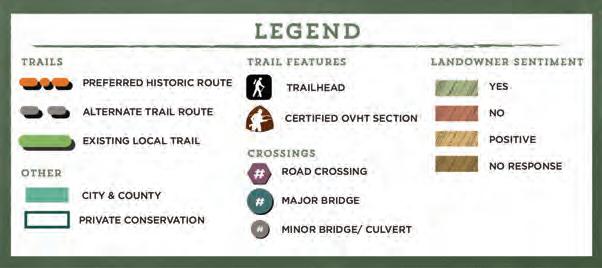




CHAPTER 4 43 %% 7 8 Pond Harris McHone Greenwood Alpine Smith SwissPineLake Spring RichKnob Bailey SunriseRidge Doc Howell Bell CreedPitman Jakes Rock Hidden Springs Watson Blands Knob HighRidge HiddenCli Terrace Lucerne Strasse Meadowlark Horizon Lawson Robie Sonshine Conasoga BlueRidgeEstates Simmons Ridge Pinehaven White Oak Hemlock Blue Ridge Bailey Woodland Boone GRASSYCREEK NORTHTOERIVER HONEYCUTT CREEK ROSES CREEK PEPPER CREEK ROCKHOUSE CREEK CATHIS CREEK SMITH BRANCH 221 19E MITCHELL COUNTY DCM O WELLCOUNTY GREENLEE PRIMARY SCHOOL HALLTOWN RD TRAILHEAD GRASSY CREEK TRAIL ALIGNMENTS GRASSY CREEK TRAILHEAD PISGAH GAMELANDS EXISTING ROSE CREEK TRAILHEAD PRIVATE CONSERVATION HEFFNER GAP TRAILHEAD EXISTING RIVERSIDE PARK TRAILHEAD JACKSON KNOB COVE TUNNEL CROSSING LB U E RIDGE PARKWAY MUSEUM OF NC MINERALS TRAILHEAD SECTION 1 RIVERSIDE PARK BLUE RIDGE PARKWAY 0 0.5 1 MAP 9: PLANNING SECTION 1
GRASSY CREEK GREENWAY



















The Grassy Creek Greenway will offer trail users two different options depending on the trail experience they are seeking. A level dual use path will head south from the Grassy Creek Trailhead as it parallels Grassy Creek. A natural surface trail will lead north crossing Grassy Creek and climbing to Spruce Pine Memorial Cemetery. At the time of this master planning effort, approximately 2,100 linear feet of this trail was being constructed.
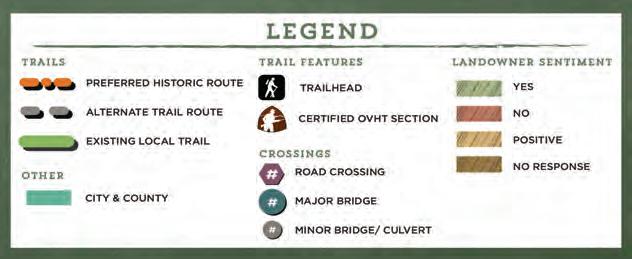
44 McHone Mica SwissPineLake Woods Rockledge Fairway Rogers Barry Martha SunriseRidge Greene Altapass Jakes Rock Pe Laurel Ellis GrassyCreek RayWiseman C 226 Woodland Dogwood Lakeview Berry PE Greenway Wildflower Flint Pine Grove Pine Tree BlueSky Mountain Stream PineValley Andrea Chestnut Hill CoralReefer Swiss Pine Country Club Woods UlyssesYoung Wintergreen Azalea PE GRASSY CREEK GRASSY CREEK NORTHTOE RIVER GRAVEYARD CREEK SWISS PINE LAKE 226 226 FOCUS
MEMORIAL CEMETERY GRASSY CREEK GREENWAY SPRUCE PINE MEMORIAL CEMETARY GRASSY CREEK TRAILHEAD SIBELCO QUARTZ CORPORATION EXISTING GRASSY CREEK GREENWAY N MILES 0 0.25 0.5
AREA
MAP 10: MEMORIAL CEMETERY TO GRASSY CREEK GREENWAY



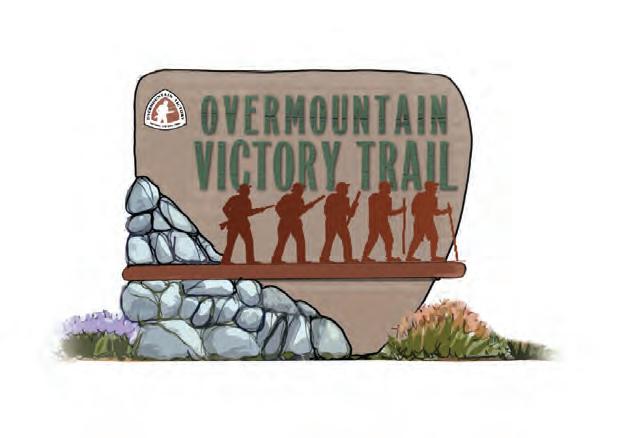
CHAPTER 4 45 PUMP STATION TRAIL ENTRANCE SERVICE AREA and TURN AROUND (GRAVEL) PARKING (ASPHALT) ENTRANCE N BIKE PARKING TRAILHEAD SIGN SPLIT RAIL FENCING KIOSK GRASSY CREEK CARTERS RIDGE ROAD EXHIBIT 3: GRASSY CREEK TRAILHEAD SITE PLAN GRASSY CREEK TRAILHEAD Grassy Creek Trailhead will provide a small parking area, kiosk, bike rack, and trailhead signage. While the trailhead will provide direct access to the natural surface trail that travels downstream, it will also provide parking for trail users traveling upstream on the Grassy Creek Greenway.
PROPOSED TRAILS

The preferred route in Section 2 comprises 10.8 total miles of trail, extending from the Museum of NC Minerals at Gillespie Gap on the Blue Ridge Parkway to US Highway 221 near Grace Greenlee Road. Beginning at the Museum, the route continues 1.8 miles to follow an existing certified OVNHT segment located on the northern side of the Blue Ridge Parkway. The existing natural surface trail parallels the BRP until it terminates at Lynn Gap. The route follows a gravel road underneath the Parkway via the existing underpass and along NC Highway 226A for a short distance before it steeply descends as a natural surface trail alongside Sycamore Branch and Armstrong Creek to NC Hwy 226 for 3.3 miles. The trail continues as a natural surface trail parallel to Cox Creek and NC Hwy 226 until its intersection with US Hwy 221.
An alternate route is proposed utilizing old woods roads to access the existing Woods Mountain Loop Trail located on US Forest Service property. This natural surface trail allows hiking, mountain biking, and equestrian use and eventually connects with the Mountains to Sea Trail near US Hwy 221 at the USFS Woodlawn Work Center. While this route deviates from the historic corridor, it would take advantage of established trails located on public lands.

TRAIL FEATURES

This planning section includes four (4) trailheads, one (1) minor bridge, and four (4) road crossings.
TRAILHEADS
A proposed trailhead at the NC Minerals Museum will provide access to an existing designated section of the OVNHT that parallels the BRP to the east and west (Improvements shown on p. 50). The proposed Little Switzerland trailhead would be located at Lynn Gap and acts as the western terminus of a certified section of the OVNHT before the trail turns south towards Lake James (Improvements shown on p. 48).














A small trail access and parking area is proposed where the trail crosses US Forest Service property along NC Hwy 226A. This trailhead would also serve as an additional access to the existing Woods Mountain Loop Trail which is identified as an alternate route for the OVNHT. The US Hwy 221 trailhead is proposed at this planning section’s terminus at the intersection of NC Hwy 226 and US Hwy 221.
CROSSINGS
This planning section includes one (1) minor bridge located on a drainage into Sycamore Branch.
There are four (4) road crossings identified with this section. Crossing #1 utilizes an existing bridge underpass of the Blue Ridge Parkway. Crossings #2 and #3 are located on NC Hwy 226A. The trail also crosses US Hwy 221 as it transitions to the next planning section.
PHOTOS: (1) Existing underpass at Lynn Gap. (2) A proposed trailhead at the NC Minerals Museum will provide access to an existing section of OVNHT.
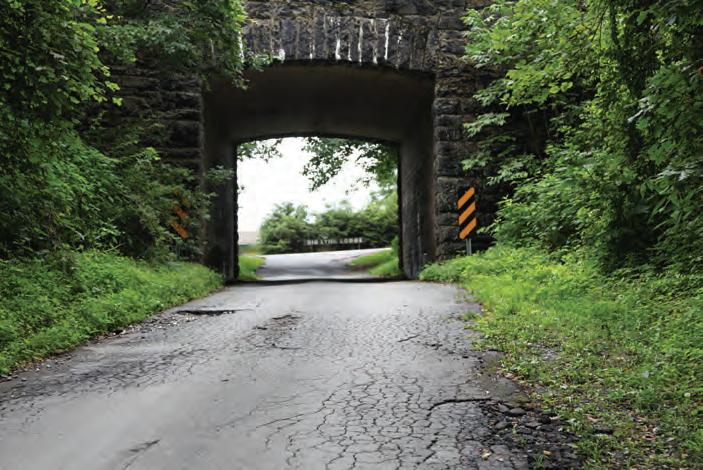
46
01
HWY 221 BLUE RIDGE PARKWAY VICINITY MAP SECTION
EXISTING TRAIL: 1.8 MILES PROPOSED TRAIL: 9 MILES TRAIL TYPE: NATURAL SURFACE ESTIMATED COST: $552,200 POINTS OF INTEREST: BLUE RIDGE PARKWAY NC MINERALS MUSEUM LIT TLE SWITZERLAND PISGAH NATIONAL FOREST
2
BURKE COUNTY MCDOWELLCOUNTY MITCHELLCOUNTY MCDOWELL COUNTY SPRUCE PINE 221 221 LAKE JAMES l p r way LINVILLE RIVER NORTHTOERIVER WILDERNESS AREA BREWERY CANAL BRIDGE 1 2 3 4 6 5
02





















CHAPTER 4 47 Linville Peppers Creek Otter Martin Branch DobsonKnob Devil Face PittsStation COXCREEK ARMSTRONGCREEK RAG CREEK ROSES CREEK PEPPER CREEK ODEAR CREEK THREEMILECREEK PUPSBRANCH CANEY BRANCH NORTH FORK CATAWBA RIVER BUCHANAN CREEK VAN NOY BRANCH MACE BRANCH BARTLETT CREEK LONG BRANCH SYCAMORE BRANCH SOUTHFORKROSESCREEK LIMEKILNCREEK BLUE RIDGE PARKWAY MUSEUM OF NC MINERALS TRAILHEAD LITTLE SWITZERLAND TRAILHEAD ARMSTRONG CREEK TRAILHEAD HWY 221 TRAILHEAD SECTION 2 BLUE RIDGE PARKWAY HWY 221 221 0 0.5 1 MAP 11: PLANNING SECTION 2
MARCHING ON FROM THE MINERALS MUSEUM


Creating a trailhead at the Museum of North Carolina Minerals allows access to a section of certified OVNHT along the Blue Ridge Parkway. The parking area, enhanced by a trailhead kiosk and OVNHT trail markers, will provide clear identification and wayfinding.

48
EXISTING EXHIBIT 4: MARCHING ON FROM THE MINERALS MUSEUM
LITTLE SWITZERLAND TRAILHEAD @ LYNN GAP
At the terminus of the existing section of OVNHT to the west of the Museum of NC Minerals, there is an opportunity to create a trailhead that would act as an anchor point delineating the certified section of trail between the trailheads and root continued trail growth to the south. The trailhead here could accommodate a small parking area, kiosk, and clear OVNHT identification.



49
EXISTING
EXHIBIT 5: LITTLE SWITZERLAND TRAILHEAD @ LYNN GAP
PROPOSED TRAILS


The preferred historic route extends for 7 miles from US Hwy 221 to Black Bear Campground. From US Hwy 221, a natural surface trail parallels old Hwy 221 to its intersection with American Thread Road. The route continues south and parallels Good Road and the North Fork of the Catawba River until entering Pisgah National Forest. The trail continues along an old roadbed before briefly joining with the NC Mountainsto-Sea Trail (MST). The OVNHT will use an existing footbridge across the North Fork of the Catawba River and an at grade crossing of the CSX railroad before leaving the MST to the south. The preferred route continues for 2.1 miles within the Pisgah National Forest and briefly exits the historic corridor to continue utilizing public parcels. The trail rejoins the historic corridor within the Black Bear Pisgah Gamelands along Bear Creek, and follows a certified OVNHT segment to connect to Black Bear Campground.


The alternate route that ended at the intersection of US Hwy 221 and the MST, crosses US Hwy 221 and continues along the existing MST then rejoins with the preferred route at this existing footbridge in Section 3.
TRAIL FEATURES
This planning section includes two (2) trailheads, two (2) minor bridges, and one (1) road crossing.
Trailheads


A small trail access and parking area is proposed at the end of Good Road. This trailhead could also serve as an additional access for the Mountains-to-Sea Trail.












Utilizing the Fonta Flora State Trail as a spur trail to the Black Bear Boat Access would establish this access area as the second trailhead in this planning section.
Crossings
This planning section includes two (2) minor bridges located at natural drainages into the North Fork of the Catawba River.
There is one (1) crossing at American Thread Road that has been identified within this section.
50
BLACK BEAR CAMPGROUND HWY 221 VICINITY MAP SECTION 3 EXISTING TRAIL: 2.3 MILES PROPOSED TRAIL: 7 MILES TRAIL TYPE: NATURAL SURFACE ESTIMATED COST: $467,600 POINTS OF INTEREST: PISGAH NATIONAL FOREST MOUNTAINS-TO-SEA TRAIL PISGAH GAMEL ANDS BL ACK BEAR CAMPGROUND FONTA FLORA STATE TRAIL BURKE COUNTY MCDOWELLCOUNTY MITCHELLCOUNTY MCDOWELL COUNTY SPRUCE PINE 221 221 LAKE JAMES l d p r way LINVILLE RIVER NORTHTOERIVER WILDERNESS AREA BREWERY CANAL BRIDGE 1 2 3 4 6 5
01 02
PHOTO: (1) Utilizing the Fonta Flora State Trail as a spur trail will connect to the OVNHT to Black Bear Campground and Boat Access. (2) The NCWRC Pisgah Game Lands includes an existing section of certified OVT.
































CHAPTER 4 51 1 Cannon Bald Mountain Ollis Good Linville Toms Creek Marina Ce Goode Lost Cove Idlewood Gouge Bearcliff MountainIvy NewMannaCamp CarlDenny BlackForest Grace Greenlee ArborView Mountain Point DemiJohn DALES CREEK TOMS CREEK NORTH FORK CATAWBA RIVER LIMEKILNCREEK BEAR CREEK BAILEYCREEK MCGEGERS BRANCH HARRISCREEK MCDOWELLBURKECOUNTY COUNTY 221 LAKE JAMES PISGAH NATIONAL FOREST WOODS MOUNTAIN LOOP MOUNTAINSTOSEATRAIL PLANNEDFONTAFLORA STATE TRAIL BLACK BEAR/ DUKE ENERGY GOOD RD TRAILHEAD HWY 221 TRAILHEAD EXISTING WOODLAWN WORK CENTER TRAILHEAD BLACK BEAR BOAT ACCESS & TRAILHEAD BEAR CREEK TRAILHEAD SECTION 3 HWY 221 BLACK BEAR CAMPGROUND PISGAH GAMELANDS 0 0.5 1 MAP 12: PLANNING SECTION 3
STATE TRAIL CONNECTIONS
















North Carolina’s eight State Trails provide regional and statewide connectivity. Two State Trails connect with the OVNHT within this study area. The Mountains to Sea and Fonta Flora State Trails will provide connections from the OVNHT to Asheville, Raleigh, the Outer Banks and beyond.

52 BURKECOUNTY MITCHELLMCDOWELLCOUNTY
MCDOWELL COUNTY
221 221 LAKE JAMES mountainstoseatrail mountains to sea trail fonta flora state trail blu e ridge parkway LINVILLE GORGE WILDERNESS AREA FONTA FLORA BREWERY WOODS MOUNTAIN TRAIL LOOP mile-wide historic corridor LEGEND OVNHT PREFERRED HISTORIC ROUTE FONTA FLORA STATE TRAIL MOUNTAINS TO SEA TRAIL TRAILS CERTIFIED OVHT SECTION
COUNTY
SPRUCE PINE
MAP 13: STATE TRAIL CONNECTIONS
















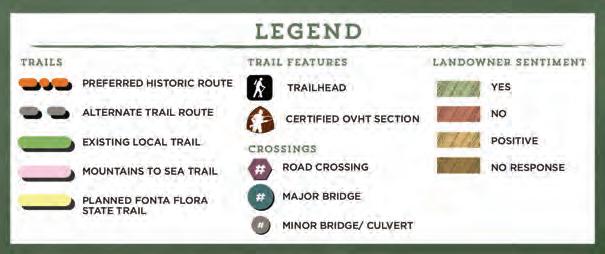


CHAPTER 4 53 0 0.5 1 LakeJames Marina Cannon New Manna Camp Bearcliff Lake Crest Bear Cliff MountainIvy BearcliffVillage 1552 1553 MOUNTAINS TO SEA TRAIL PLANNEDFONTAFLORASTATETRAIL LAKE JAMES MST TO FFST CONNECTION VIA ~3.3 MILE OVNHT SEGMENT BEAR CREEK TRAILHEAD BLACK BEAR BOAT ACCESS & TRAILHEAD FOCUS AREA MOUNTAINS TO SEA TRAIL FONTA FLORA STATE TRAIL N EXHIBIT 6: SEEING DOUBLE THREE MILES FOR THREE STATE TRAILS
MAP 14: MST TO FFST CONNECTOR
An opportunity exists to make a direct connection across publically managed properties between the existing Mountains-to-Sea and proposed Fonta Flora State Trails. The natural surface trail would extend south from the MST after crossing the existing footbridge and railroad and connect with existing certified OVNHT on the Pisgah Game Lands. This segment of the OVNHT connects and co-aligns with the proposed Fonta Flora State Trail.
CONNECTION TO PLANNED TRAIL
/OVT TRAILHEAD /OVT TRAILHEAD

BLACK BEAR & BEYOND
Duke Energy has several new site amenities planned for completion in the next three years at the Black Bear boat access property. Planned improvements include a dayuse area with picnic sites overlooking Lake James, ADA-accessible fishing pier, and 37 campsites with fire rings, and bathhouse. The FFST will utilize a planned internal trail system that links these amenities and also serve as a spur trail to the OVNHT.
FONTA FLORA STATE TRAIL
CONNECTION

1.Roads designed in accordance
Standards for Secondary and Subdivision Roads (Minimum Construction Standards), 2010.

NCDOT
2.Accessibility designed in accordance with 2010 ADA Standards Accessible Design in accordance with the Americans with Disabilities Act (ADA), 1990.

3.If there is a discrepancy with the quantities for program elements, consult Landscape Architect for clarification. Otherwise, use whichever quantity is greater.
Construction Notes for the General Contractor
1.Burning is not permitted.
2.Edge of Water at Time of Survey shown - Actual water elevation may vary.
3.Contractor shall be responsible for providing all applicable building permits, labor, materials, and equipment required to perform the specified work.
4.All aspects of work shall be performed in accordance with all applicable local, state, and federal regulations pertaining to worker safety.
5.All paving materials and workmanship shall be in accordance with the latest edition of the State's DOT "Standard Specifications for Roads and Structures."
6.Ground surface shall be shaped to provide positive drainage.
7.Contractor shall coordinate all site activities with Duke Energy's Project Manager or designated representative. Contractor shall be responsible for coordinating delivery, storage and handling of all materials required for the project.
8.All disturbed areas shall be stabilized within 30 working days following completion of land disturbing activities. If there is more stringent soil stabilization guidelines put in place by local, county, state or federal agencies or called for based on permit requirements then the more stringent guidelines shall
54 2 3 9 10 11 12 13 14 15 16 17 33 32 31 34 36 35 30 29 28 27 18 26 25 20 22 23 24 37 4 5 8 9 10 11 12 13 14 3 DAY USE AREA LAKEJAMESROAD EXISTING BLACK BEAR ACCESS AREA ROAD 2 ENTRANCE ROADA ROADB CAMPGROUND AREA GROUP CAMPSITE FUTURE MAINTENANCE YARD/ STORAGE AREA STREAM CROSSING BATH HOUSE VAULT TOILET ADA PARKING (4) DAY USE PICNIC SITE , TYP. NATURAL PATH PICNIC SHELTER ADA CAMPSITES VAULT TOILET, ADA PARKING, AND TRASH PAD EXISTING BOAT LAUNCH ADA TRAIL FISHING PIER (BY OTHERS) IMPROVE EXISTING TRAIL, TYP PARKING & TRAILHEAD DISTURBANCE BOUNDARY (11.3 ACRES) CONCRETE PATH STORMWATER TREATMENT PICNIC SHELTER POTENTIAL WELL LOCATION FUTURE CABIN LOCATION, TYP. FUTURE RANGER WELCOME OR INTERPRETATION STATION ENTRANCE INFORMATION AREA PLANTING ENHANCEMENT CAMPGROUND ROAD LOOP B ENTRANCE GATE CAMPGROUND ROAD LOOP A STORMWATER TREATMENT POTENTIAL DRAIN FIELD AREA DISTURBANCE BOUNDARY (11.3 ACRES) EXISTING PARKING (ASPHALT) SUBJECT PROPERTY LAKEVIEWDRN LAKEJAMESROAD NPEAKDR TO HWY-221 TOSR-126 LAKE JAMES PROGRAM VICINITY MAP Black Bear Access Area, Lake James 6514 Lake James Road Marion, NC 28752 Latitude: 35.746326° N Longitude: -81.970221° W FERC Project No. 2232 Approximately 164 acres
Design Standard Notes:
with
Design
LEGEND PROPOSED ROAD CAMP SITES PICNIC SITES FUTURE CABIN LOCATION EXISTING TRAIL ROADBED FUTURE TRAIL CONNECTION
CONTOURS (5' INT.)
TREE STREAM CENTERLINE LAKE WATER EDGE
EXISTING
EXISTING
TO PLANNED TRAIL CONNECTION TO OVNHT
EXHIBIT 6: BLACK BEAR & BEYOND
STATE TRAIL CO-ALIGNMENT @ BLACK BEAR


Atrailhead with new parking spaces designated for the OVNHT and FFST is proposed adjacent to the existing upper boat-trailer parking lot. The trailhead and route through the property are subject to approval by the Federal Energy Regulatory Commission which oversees site improvements and programming for Duke Energy property. Duke has expressed support for the OVNHT, FFST, and Black Bear trailhead.

55
EXISTING EXHIBIT 7: STATE TRAILCOALIGNMENT @ BLACK BEAR
VICINITY MAP
FONTA FLORA BREWERY BLACK BEAR CAMPGROUND
PROPOSED TRAILS
The preferred route in Section 4 totals 5.5 miles and extends from Black Bear Campground to Fonta Flora Brewery. Since the Overmountain Men traveled along the Catawba River corridor and Lake James was impounded in the early 1900s, the majority of trail within this section is located outside of the historic corridor. The preferred route aligns with the planned Fonta Flora State Trail.
The natural surface trail extends east from the proposed Bear Creek Trailhead at Black Bear Pisgah Gamelands, crossing Bailey Creek before continuing through Pisgah National Forest land for 1 mile. The route continues across privately owned undeveloped parcels to the McDowell/Burke County line and then parallels South Mountain Institute Road to the Enclave at Lake James. The trail will continue east through the Enclave community on easements secured by Burke County before connecting with the certified OVNHT dual use path in the 1780 community. This route stretches 1 mile from Campbells Trace Road to Fonta Flora Brewery.
TRAIL FEATURES


This planning section includes two (2) trailheads, seven (7) minor bridges, and four (4) road crossings.

Trailheads
The Bear Creek Trailhead is proposed at an existing gravel parking area for the NCWRC Black Bear Pisgah Gamelands.
The trailhead, located across from the entrance to Black Bear Boating Access Area, provides a small parking area adjacent to Bear Creek. Burke County has also secured easements for a trailhead near the entrance to the Enclave community.


Crossings












This planning section includes seven (7) minor bridges at natural drainages and small creeks including Bailey and Dales Creeks.
There are four (4) at-grade rural road crossings identified within this section. These are on Linville and Lake James Roads, Campbell’s Trace, and NC Highway 126.
56
BURKE COUNTY
MCDOWELL COUNTY SPRUCE PINE 221 221 LAKE JAMES pa w LINVILLE RIVER NORTHTOERIVER LINVILLE GORGE FONTA FLORA mile-wide historic corridor 1 2 3 4 6 5
MCDOWELLCOUNTY MITCHELLCOUNTY
EXISTING TRAIL: 1 MILES PROPOSED TRAIL: 4.5 MILES TRAIL TYPE: NATURAL SURFACE DUAL USE PATH ESTIMATED COST: $584,600 POINTS OF INTEREST: BL ACK BEAR CAMPGROUND FONTA FLORA STATE TRAIL FONTA FLORA BREWERY L AKE JAMES STATE PARK
SECTION 4
(1) Existing dual use
(2)
02 01
PHOTO:
path in the 1780 Community.
Fonta Flora Brewery























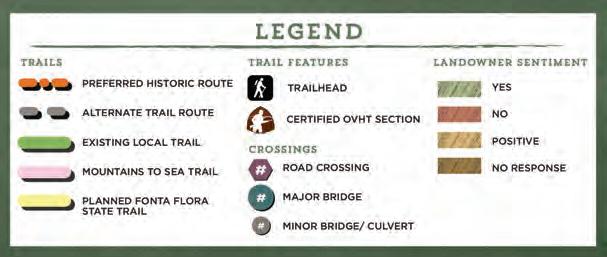








CHAPTER 4 57 6 Linville Wildlife Club Club Marina Obeth Mountain Institute Lakeview Hills BigTree C 105 Forest Lake Heights Sunset Point NeboBridge Dockside Turtle Head PisgahPreserve HuntCamp DobsonView FishCamp BigGame Game Land Bearcliff Yellowfork Magnolia LongRifleRidge New Manna Camp Waterglyn LakeClub Rusty Hook Rock Hill CedarRidge Catawba Bear Hollow HighLake Gobblers Neck Sailview B B Short Bud David DeerBerry Otter Waller Summertime CabinBluff OspreyRoost September Bowen Astoria Ravenwood MountainVista Lookout Point OtterCove Mountain Institute PADDY CREEK BAILEY CREEK DALES CREEK BEARCREEK BLACK BEAR/ DUKE ENERGY PISGAH NATIONAL FOREST LAKE JAMES FONTA FLORA BREWERY MCDOWELLBURKECOUNTY COUNTY PLANNEDFONTAFLORASTATETRAIL LAKE JAMES STATE PARK BLACK BEAR BOAT ACCESS & TRAILHEAD BEAR CREEK TRAILHEAD ENCLAVE TRAILHEAD SECTION 4 BLACK BEAR FONTA FLORA 0 0.5 1 MAP 12: PLANNING SECTION 4
VICINITY MAP

BLUE RIDGE PARKWAY

PROPOSED TRAILS
The preferred route in Section 5 extends for 9 miles from the Blue Ridge Parkway at Heffner Gap Overlook to the NC Mountains-to-Sea Trail. From the Blue Ridge Parkway, the preferred route continues for 2 miles as a natural surface trail across easements and parcels managed by the Conservation Trust of North Carolina to the CSX railroad. The route crosses large undeveloped parcels to Honeycutt Creek which it follows south to US Highway 221.
The trail crosses US Hwy 221 before entering the North Fork of the Catawba River floodplain. The route follows the river as a natural surface trail for 2.2 miles before crossing the CSX rail line again near the confluence of the North Fork of the Catawba River and Bridge Branch. The trail continues across Old Linville Road and two private parcels joining designated OVNHT before entering the Pisgah National Forest. This existing section of natural surface trail continues 2.0 miles to its intersection with the MST.

TRAIL FEATURES

This planning section includes two (2) trailheads, one (1) major bridge, three (3) minor bridges, and two (2) road crossings.
TRAILHEADS
While an informal trailhead exists at the Heffner Gap Overlook for the Rose Creek Trail on the north side of the Blue Ridge Parkway, the only indication is a small OVNHT sign. When the trail is completed on the south side of the Parkway, additional signage would help bring more attention to this existing certified section of the OVNHT (Improvements shown on p. 61).
The Honeycutt Creek trailhead is proposed at the intersection of Honeycutt Road and US 221.













CROSSINGS
This planning section includes one (1) major bridge across the North Fork of the Catawba River. Three (3) minor bridges are located within the planning section across small tributaries to Honeycutt Creek.
There are two (2) road crossings identified within this section. Crossing #1 is located on US Hwy 221. Crossing #2 is a rural road crossing of Old Linville Road.
58 MST
CONNECTION
EXISTING TRAIL: 2.0 MILES PROPOSED TRAIL: 7 MILES TRAIL TYPE: NATURAL SURFACE ESTIMATED COST: $610,600 POINTS OF INTEREST: BLUE RIDGE PARKWAY MOUNTAINS-TO-SEA TRAIL PISGAH NATIONAL FOREST BURKE COUNTY MCDOWELLCOUNTY MITCHELLCOUNTY MCDOWELL COUNTY SPRUCE PINE b ridg way LINVILLE RIVER NORTHTOERIVER LINVILLE GORGE FONTA FLORA mile-wide historic corridor 1 2 3 4 6 5
SECTION 5
02 01
PHOTO: (1) Heffner Gap currently provides access to a certified section of OVT on the Rose Creek Pisah Gamelands (2) Certified trail entrance off of Old Linville Road.


































CHAPTER 4 59 % Halltown Apple Swa ord Nc 226 DC Johnson Six Pence JoltWagon Fox Den Branch Ponderosa Eastridge Ethan Allen Foggy Hollar PEPPER CREEK NORTH FORK CATAWBA RIVER HONEYCUTT CREEK LINVILLE RIVER YELLOW FORK POND BRANCH BRIDGEBRANCH STILLHOUSE BRANCH MARTIN BRANCH DOGBACKSPRINGBRANCH SANDYBRANCH SMITH BRANCH 221 221 MITCHELLCOUNTYMCDOWELLCOUNTY MCDOWELLCOUNTYBURKECOUNTY LINVILLE GORGE WILDERNESS AREA NS TO SEA TRAIL PRIVATE CONSERVATION EXISTING ROSE CREEK TRAILHEAD HEFFNER GAP TRAILHEAD JACKSON KNOB COVE PISGAH GAMELANDS TUNNEL CROSSING HONEYCUTT CREEK TRAILHEAD SECTION 5 BLUE RIDGE PARKWAY MST CONNECTION N 0 0.5 1 MAP 16: PLANNING SECTION 5
HEFFNER GAP TO HWY 221

Multiple land conservancies such as the Conservation Trust of North Carolina (CTNC) and Foothills Conservancy are actively involved in landowner discussions about easements for the OVNHT. The CTNC has secured easements and properties just south of the Blue Ridge Parkway to the CSX railroad. Both conservancies are working with landowners between the railroad and Honeycutt Road. This section of trail descends the Blue Ridge escarpment with a significant elevation change of approximately 1,500 feet.
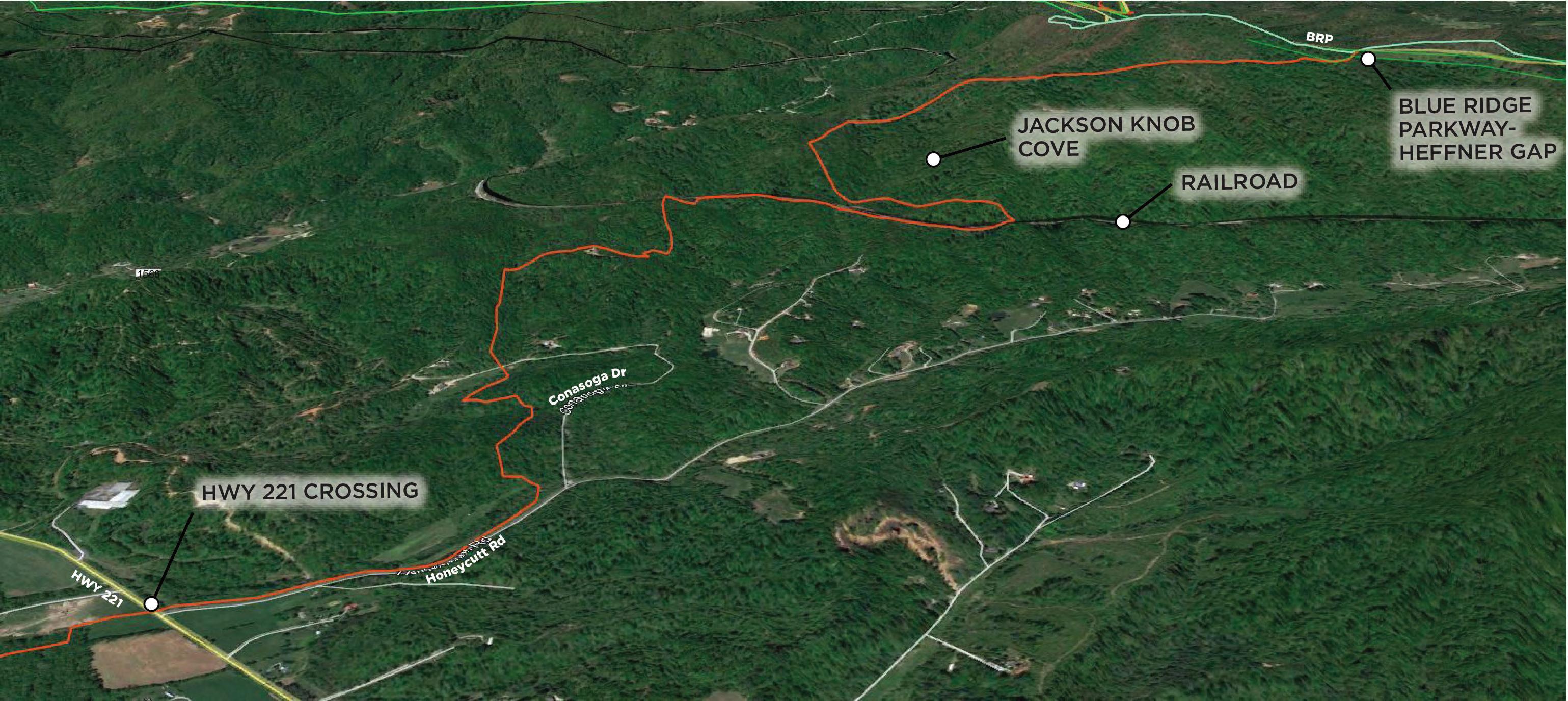
60
EXHIBIT 8: HEFFNER GAP TO HWY 221
Oand property are secured on the south side of the Blue Ridge Parkway and trail development is continued to the south, OVNHT trail markers would inform visitors of the trail’s presence along the parkway.



CHAPTER 4 61
EXISTING EXHIBIT 9: HEFFNER GAP TRAILHEAD
VICINITY MAP

CANAL BRIDGE MST CONNECTION














PROPOSED TRAILS
The preferred historic route extends for 9.6 miles from the NC Mountains-to-Sea Trail to Canal Bridge.

A certified OVNHT segment follows the existing natural surface MST from its intersection at Forest Service Road 106 to Old NC 105 for 1.75 miles. The route then exits the MST coalignment to continue south along Old NC 105 until it leaves the road to utilize more public land to the east and south for 1.3 miles. The trail continues across large private parcels to connect to the Paddy Creek corridor. The route then continues south to Lake James State Park and Fonta Flora Brewery and trailhead. Existing certified OVNHT within Lake James State Park parallels NC 126 until it ends at the planning section’s terminus at Canal Bridge.
TRAIL FEATURES
This planning section includes three (3) trailheads, three (3) minor bridges, and two (2) road crossings.
TRAILHEADS
The Old Hwy 105 Trailhead is proposed at an existing gravel parking area where the MST and OVNHT split. Additional signage and wayfinding would increase awareness of both State Trails as well as the Fonta Flora State Trail (Improvements shown on p. 64). The Fonta Flora Brewery and proposed trailhead located at the former Whippoorwill Farm provide
a trailhead where the eastern and western corridors join just outside of Lake James State Park. An existing trailhead is located within Lake James State Park where a certified OVNHT segment crosses the park entrance road.

CROSSINGS
This planning section includes three (3) minor bridges across small drainages and tributaries to Shooks and Paddy Creeks.
There are two (2) road crossings identified within this section. Crossing #1 is located on Old Highway 105 and crossing #2 is on NC Hwy 126.
62
EXISTING TRAIL: 3.8 MILES PROPOSED TRAIL: 5.8 MILES TRAIL TYPE: NATURAL SURFACE ESTIMATED COST: $457,240 POINTS OF INTEREST: MOUNTAINS-TO-SEA TRAIL FONTA FLORA STATE TRAIL FONTA FLORA BREWERY L AKE JAMES STATE PARK BURKE COUNTY MCDOWELLCOUNTY MITCHELLCOUNTY MCDOWELL COUNTY SPRUCE PINE 221 221 l p way LINVILLE RIVER NORTHTOERIVER WILDERNESS AREA BREWERY mile-wide historic corridor 1 2 3 4 6 5
SECTION 6
02 01
PHOTO: (1) The preferred route exits its coalignment with the MST at Old NC 105. (2) Canal Bridge serves as the easternmost terminus of this study area.






































CHAPTER 4 63 LakeJames RockHill Campbell's Pea Ridge Marina Dry Creek WildlifeClub Obeth YellowFork WildernessEdge Aragon BigTree Benfield Landing Powerhouse Riverside Graystone Bass Knollview NeboBridge Cornwallis HullyGully Turtle Head Holiday Shores Yellowfork Shore Browning View Hunt Camp Fonta Flora Sycamore Ten Whigs Ridge James Game Land Holly Ridgeway LongRifleRidge Lake Crest NewMannaCamp LakeviewHills Rusty Hook Explorer Linville Shores ForkRiver Southpointe Point CedarRidge Catawba Forest Lake Heights Bear Hollow Gobblers Neck Dockside BlackForest Wood Duck Whispering Wood Firestone DeerBerry Happy Hollow Drake Carson September BearcliffVillage Powerhouse LAKE JAMES PADDY CREEK DALES CREEK LINVILLERIVER BEAR CREEK SANDY BRANCH SHOOKS CREEK BLACKFORK YELLOW FORK MCDOWELLBURKECOUNTY COUNTY LINVILLE GORGE WILDERNESS AREA PISGAH NATIONAL FOREST LAKE JAMES STATE PARK & TRAILS AREA CANAL BRIDGE OLD HWY 105 TRAILHEAD PLANNEDFONTAFLORASTATETRAIL MOUNTAINSTO SEA TRAIL LAKE JAMES STATE PARK TRAILHEAD ENCLAVE TRAILHEAD FONTA FLORA BREWERY & TRAILHEAD BLACK BEAR BOAT ACCESS & TRAILHEAD BEAR CREEK TRAILHEAD N SECTION 6 MST CONNECTION CANAL BRIDGE 0 0.5 2 MAP 17: PLANNING SECTION 6

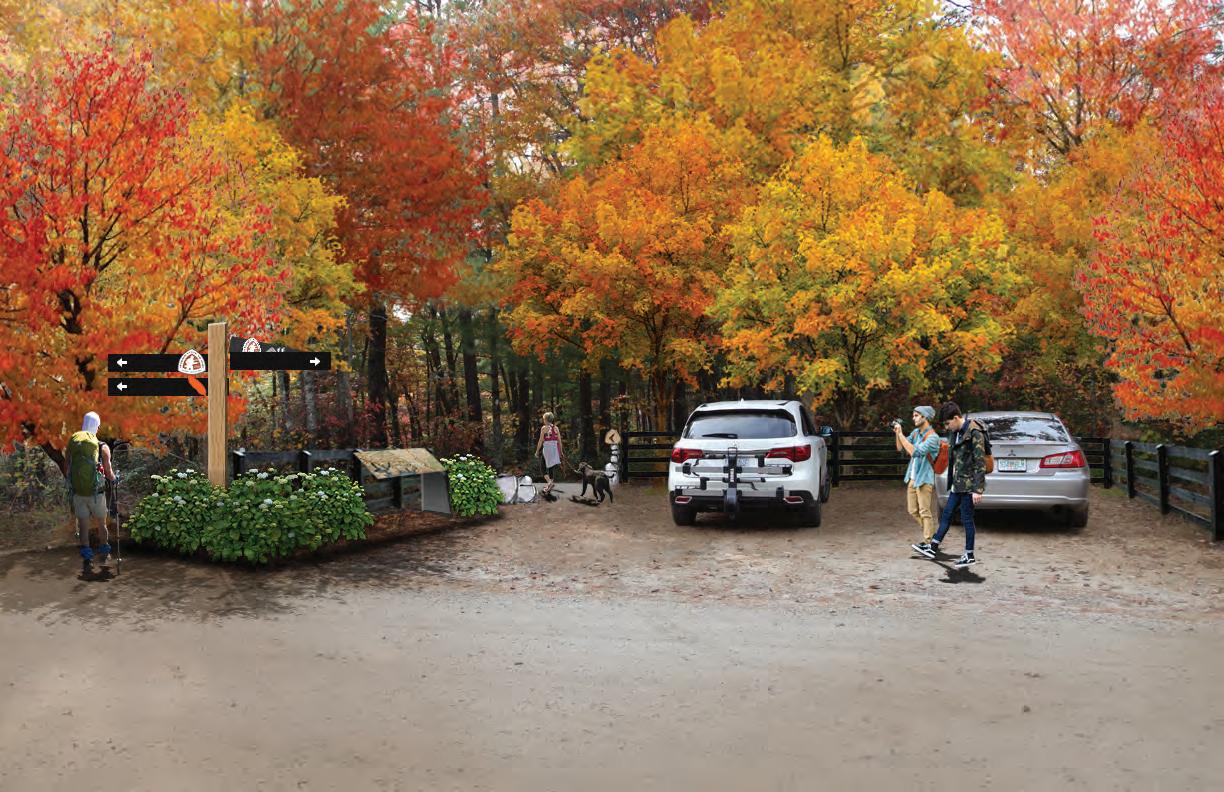

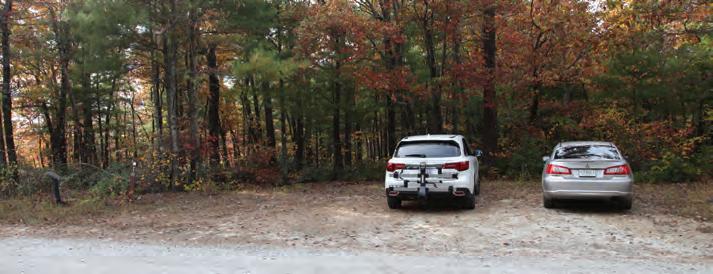
64
EXISTING EXHIBIT 10: TRIPLE TRAIL JUNCTION @ OLD 105
TLake James. This section also allows access to the Fonta Flora State Trail and therefore use of directional signs and an information kiosk would educate visitors to the network of convening trail systems.


CHAPTER 4 65 MAKING THE CONNECTION @ LAKE JAMES STATE PARK QUICK FACTS: Location: Burke and McDowell Counties, NC Size: 3,707 acres Miles of Certified OVNHT: 2 Number of Trailheads: 1 The North Carolina Division of Parks and Recreation manages Lake James State Park which encompasses over 3,707 acres and includes 25 miles of trails, 20 walk-in campsites, 33 drive-to campsites, and boat access. As a major recreation amenity, Lake James presents a significant opportunity for connectivity with the OVNHT. The lake serves as the southern terminus of this section of the OVNHT. Approximately 2 miles of certified OVNHT is located within the park's boundary. EXHIBIT 11: MAKING THE CONNECTION @ LAKE JAMES STATE PARK

66
CHAPTER 5 IMPLEMENTATION

CONSTRUCTION OF THE OVNHT
FROM Spruce Pine to Lake James WILL BE NO SMALL TASK. BUT WITH TIME, PERSEVERANCE, AND A LITTLE LUCK, THERE IS NO DOUBT THAT A DESTINATIONQUALITY TRAIL IS WITHIN GRASP.
This chapter summarizes details regarding each Planning Section and establishes responsibilities and implementation priorities by focus area. The chapter concludes with an economic impact analysis that evaluates potential benefits of completing the OVNHT from Spruce Pine to Lake James.
IN THIS CHAPTER
A. Implementation by Section and Responsibilities
B. Implementation Priorities by Focus Area
C. Trail Support Spectrum
D. Economic Impact Analysis
IMPLEMENTATION DETAILS BY PLANNING SECTION

The
SECTION
SECTION

68
Section Distance Key Opportunities Key Challenges Estimated Budget Implementing Partners
1 Spruce Pine to Blue Ridge Parkway 12.1 Extension of Grassy Creek Greenway and Trailhead Development; Connection with Greenlee Primary School; Extension of Certified OVNHT on NC Wildlife Game Lands Narrow Limited Corridors within Spruce Pine own Limits; Grassy Creek Bridge; Securing Landowner Trail Easements $2,787,820 Town of Spruce Pine; Mitchell County
table below provides an overall summary of key information associated with each planning section. Key opportunities provide valuable insight that may assist in determining priorities within each section. Key challenges include costly trail features or the need to acquire trail easements from private landowners. Most importantly, this table identifies key partners that must actively work in concert to fully implement plan recommendations.
2: Blue Ridge Parkway to
221 10.8 Existing Certified
along the
and
Development Securing
Trail
$552,200
Hwy
OVNHT
Blue Ridge Parkway
Trailhead
Landowner
Easements
McDowell County; McDowell County Trails Association
9.3 State
SECTION 3 Hwy 221 to Black Bear Campground
Trails Connection between Mountains-to-Sea and Fonta Flora State Trails on Public Lands; Existing MST Bridge Across the North Fork of the Catawba River and Railroad Crossing
Securing Landowner Trail Easements; US Hwy 221 Crossing $467,600 McDowell County; McDowell County Trails Association; NCWRC; US Forest Service
5.5
SECTION 4 Black Bear Campground to Fonta Flora Brewery
Co-alignment with Proposed Fonta Flora State Trail; Existing Easements within the Enclave Community; Proposed Trailhead at Fonta Flora Brewery
9.0
Mountains-to-Sea Trail
9.6 Existing
Old
ALL SECTIONS TOTAL 56.3 $5,460,060 EXHIBIT 12: PLANNING SECTION IMPLEMENTATION MATRIX IMPLEMENTATION DETAILS BY SECTON AND RESPONSIBILITY
Securing Landowner Trail Easements; Bailey Creek Bridge; Lake James Road Crossing $584,600 McDowell County; Burke County; USForest Service SECTION 5: Blue Ridge Parkway to Mountainsto-Sea Trail
Conserved Lands and Easements Between the Blue Ridge Parkway and CSX Railroad; Large Parcels Between the Railroad and US Hwy 221 Blue Ridge Parkway Crossing; CSX RailroadCrossing (2); US Hwy 221 Crossing; SecuringLandowner Trail Easements $610,600 McDowell County; McDowell County Trails; US Forest Service SECTION 6
to Canal Bridge
MST and OVNHT Co-alignment; Old Hwy 105 Corridor;
Hwy 105 Trailhead Development Securing Landowner Trail Easements $457,240 Burke County; US Forest Service
WHERE TO START:
IMPLEMENTATION PRIORITIES BY FOCUS AREA












This plan recommends 43 new trail miles, crosses three political jurisdictions, and requires participation from multiple land managers. For this reason, implementation partners must focus their limited capacity, including time and money, to begin advancing plan implementation. Three suggested focus areas are presented to help partners target their efforts. The Implementation Focus Areas Map illustrates recommended trail development focus areas within the broader context of the study corridor.

The implementation strategy promotes concentrating trail development efforts within three Focus Areas: 1) Memorial Cemetery to Grassy Creek Greenway; 2) NC Minerals Museum to Little Switzerland; and 3) Mountains-to-Sea Trail to Fonta Flora State Trail. The Focus Areas prioritize trail development that connects existing trail segments or is located on lands that are already managed by a public entity.
Each government entity must work in tandem and with partners to successfully realize the complete OVNHT. Trail implementation does not have to occur in a specific, linear order according to each planning section. In fact, the priority areas for implementation are merely suggestions and are in no way intended to limit creativity or work in "lower" priority areas. Trail implementation is an art and requires the acumen to recognize and seize opportunities, whether related to funding, landowner willingness, or politics.
CHAPTER 5 69 Focus Area 1: Grassy Creek Units Unit Cost Total Cost 4,266 LF $10 $ 42,660.00 1 $25,000 $ 25,000.00 $ 67,660.00 Focus Area 2: Blue Ridge Parkway Trailhead Enhancements Units Unit Cost Total Cost 1 $15,000 $ 15,000.00 Little Switzerland Trailhead 1 $15,000 $ 15,000.00 $ 30,000.00 Focus Area 3: State Trails Connector Units Unit Cost Total Cost 17,424 LF $10 $ 174,240.00 $ 174,240.00 Total Section Cost Total Section Cost Total Section Cost EXHIBIT 13: FOCUS AREA IMPLEMENTATION MATRIX BURKE COUNTY MCDOWELLCOUNTY MITCHELLCOUNTY MCDOWELL COUNTY SPRUCE PINE 221 221 LAKE JAMES LINVILLE RIVER NORTHTOERIVER LINVILLE GORGE WILDERNESS AREA FONTA FLORA BREWERY CANAL BRIDGE mile-wide historic corridor Focus area 2 Focus area 1 Focus area 3 MAP 18: IMPLEMENTATION FOCUS AREAS
ELEVATION & CONSERVED LANDS PROFILE

Existing conserved lands and State Trails within the study area provide significant opportunity for trail development. Approximately 21 miles or 38% of the study area is located within conserved lands. Additionally, the preferred route crosses 8 conserved land areas managed by 4 different entities, ranges in elevation from 1,500-ft. to over 3,000-ft., and aligns with the existing Mountainsto-Sea and proposed Fonta Flora State Trails for 9.5 miles.
EASTERN PREFERRED ALIGNMENT
The eastern preferred alignment extends approximately 35 miles from its northern terminus at Riverside Park to its southern terminus at Fonta Flora Brewery. Key features within this alignment include the Rose Creek NC Wildlife Gamelands, Heffner Gap, the Blue Ridge Parkway, Pisgah National Forest, Mountains-to-Sea Trail, Fonta Flora State Trail, and Lake James State Park.
Mountains-to-Sea Blue Ridge Parkway MATCH LINE
Heffner Gap Highway 221
WESTERN PREFERRED ALIGNMENT
The western preferred alignment extends for approximately 25 miles from its northern terminus at Riverside Park to its southern terminus at Canal Bridge. Key features within this alignment include the Museum of NC Minerals, Blue Ridge Parkway, Lynn Gap, Pisgah National Forest, Black Bear NC Wildlife Gamelands, Mountains-to-Sea Trail, Fonta Flora State Trail, and Lake James State Park.
70 2.5 mi 5 mi 7.5 mi 10 mi 12.5 mi 15 mi 17.5 Horizontal
(in Miles)
Elevation (in Feet Above Sea
2,000
Progression
Boone 1,500 2,500
Level)
3,000 Blue Ridge Parkway Lynn Gap Highway 221Mountains-to-Sea Museum of NC Minerals MATCH LINE
Horizontal Progression (in Miles) mi 2 mi 3 mi 4 mi 5 mi 6 mi 7 mi 8 mi 9 mi 10 mi 11 mi 12 mi 13 mi 14 mi 15 mi
2,500 Elevation (in Feet Above Sea Level)
3,000 Horizontal Progression
Boone 1,500
2,000
Pisgah NC Wildlife Gamelands


CHAPTER 5 71 15 mi 17.5 mi 20 mi 22.5 mi 25 mi 27.5 mi 30 mi Lake James State Park Pisgah National Forest NC Wildlife Gamelands Horizontal Progression (in Miles) Highway 221Mountains-to-Sea Trail Fonta Flora State Trail MATCH LINE mi 13 mi 14 mi 15 mi 16 mi 17 mi 18 mi 19 mi 20 mi 21 mi 22 mi 23 mi 24 mi 25 mi Horizontal Progression (in Miles) Lake James State Park Pisgah National Forest Mountains-to-Sea Trail Fonta Flora State Trail MATCH LINE EXHIBIT 14: ELEVATION PROFILE
Private Lands Conserved Lands
LEGEND
TRAIL SUPPORT SPECTRUM
Creating a destination-quality trail system requires a significant commitment from local governments, including

spend local funds, but instead must leverage their funds to obtain support from grant agencies sympathetic to the creation of trails and the OVNHT. This particular section of the OVNHT enjoys support from many partners. Working together, local trail organizations and governments can have a far greater influence in convincing funding agencies of the merits of the trail, than when acting alone.
The “Trail Support Spectrum” illustrates the steps local governments can take to support trail development in their jurisdictions.

TRAIL SUPPORT SPECTRUM
1 2 3 4 5
EXHIBIT 15: TRAIL SUPPORT SPECTRUM
ECONOMIC IMPACT ANALYSIS

Once completed, the OVNHT from Spruce Pine to Lake James will greatly benefit surrounding communities’ economies, health, and quality of life. The completed 56-mile trail is expected to attract between 21,000-35,100 users each year with a projected conservative economic annual impact of between $632,139-$1.05 million in visitor spending.

Visitor and economic impact estimates were calculated using data from trail-use and spending studies of the Blue Ridge National Heritage Area, Virginia Creeper Trail, and the State of North Carolina. A 60-mile-radius (1.5-hour driving distance) trade area and estimated 33% of North Carolinians who use trails, was used to determine a potential market population of 702,376. A 3% and 5% market penetration rate were then used to determine low and high annual user estimates. Although the Blue Ridge National Heritage Area Study provided an estimated daily visitor impact of $62-$108, a conservative day-trip visitor spending estimate of $30 per day per visitor was applied to annual user estimates to calculate the OVNHT's economic impact.
The trail will also offer health benefits to the local population by increasing physical activity which will result in lower rates of obesity, diabetes, and premature deaths for an annual total health benefit of approximately $2.1 million (ITRE, 2019). Annual health benefits were calculated using trail studies of the American Tobacco Trail and Brevard Greenway and the World Health Organization’s Health Equity Assessment Toolkit (ITRE, 2019). Studies have also shown that amenities such as greenways and trails benefit quality of life, job retention, and attraction.

CHAPTER 5
MAP 19: ECONOMIC IMPACT MARKET EXHIBIT 16: ECONOMIC IMPACT ANALYSIS

74
APPENDIX


76 (A1) BUDGET Section 1 - Riverside Park to Blue Ridge Parkway Units Unit Cost Total Cost Natural Surface 23408 $10 $ 234,080.00 Dual-Use 16388 $60 $ 983,280.00 DOT Sidepath 1872 $120 $ 224,671.20 Town Sidepath 4601 $100 $ 460,054.00 Typical Greenway 4419 $90 $ 397,735.20 Major Bridges 2 $90,000 $ 180,000.00 Minor Bridge/Culverts 4 $45,000 $ 180,000.00 Road Crossings (Surface) 16 $8,000 $ 128,000.00 $ 2,787,820.40 Section 2 - Blue Ridge Parkway to Hwy 221 Units Unit Cost Total Cost Natural Surface 47520 $10 $ 475,200.00 Minor Bridge/Culverts 1 $45,000 $ 45,000.00 Road Crossings 4 $8,000 $ 32,000.00 $ 552,200.00 Section 3 - Hwy 221 to Black Bear Campground Units Unit Cost Total Cost Natural Surface 36960 $10 $ 369,600.00 Minor Bridge/Culverts 2 $45,000 $ 90,000.00 Road Crossing 1 $8,000 $ 8,000.00 $ 467,600.00 Section 4 - Black Bear Campground to Fonta Flora Brewery Units Unit Cost Total Cost Natural Surface 23760 $10 $ 237,600.00 Minor Bridge/Culverts 7 $45,000 $ 315,000.00 Road Crossings 4 $8,000 $ 32,000.00 $ 584,600.00 Section 5 - Blue Ridge Parkway to MST Units Unit Cost Total Cost Natural Surface 36960 $10 $ 369,600.00 Major Bridges 1 $90,000 $ 90,000.00 Minor Bridge/Culverts 3 $45,000 $ 135,000.00 Road Crossings 2 $8,000 $ 16,000.00 Total Section Cost Total Section Cost Total Section Cost

APPENDIX 77 Natural Surface 36960 $10 $ 369,600.00 Minor Bridge/Culverts 2 $45,000 $ 90,000.00 Road Crossing 1 $8,000 $ 8,000.00 $ 467,600.00 Section 4 - Black Bear Campground to Fonta Flora Brewery Units Unit Cost Total Cost Natural Surface 23760 $10 $ 237,600.00 Minor Bridge/Culverts 7 $45,000 $ 315,000.00 Road Crossings 4 $8,000 $ 32,000.00 $ 584,600.00 Section 5 - Blue Ridge Parkway to MST Units Unit Cost Total Cost Natural Surface 36960 $10 $ 369,600.00 Major Bridges 1 $90,000 $ 90,000.00 Minor Bridge/Culverts 3 $45,000 $ 135,000.00 Road Crossings 2 $8,000 $ 16,000.00 $ 610,600.00 Section 6 - MST to Canal Bridge Units Unit Cost Total Cost Natural Surface 30624 $10 $ 306,240.00 Minor Bridge/Culverts 3 $45,000 $ 135,000.00 Road Crossings 2 $8,000 $ 16,000.00 $ 457,240.00 Total 5,460,060.40 $ * Includes all Historical-Preferred Routes * Does not include land acquisition, engineering, or design * Does not include existing segments of OVNHT or proposed trailheads. * Final trail type will depend on specific environmental conditions and whether trail is located within public ROW or within a private trail easement. Total Section Cost Total Section Cost Total Section Cost
(A2) LANDOWNER INVITATION
PO Box 782, Spruce Pine, NC 28777 828.284.9818 hartselljonathan@gmail.com
Dear Mitchell County Neighbor,
The Overmountain Victory Trail Association has partnered with the National Park Service and local Mitchell County and Spruce Pine government leaders to create a unique historical, educational, and recreational project for Mitchell County. Among other exciting possibilities, it will include a public walking and biking trail that will connect Spruce Pine to Lake James.


This trail will celebrate the march of the Overmountain Men who won a major Revolutionary War battle in 1780 at Kings Mountain, South Carolina. The patriot victory is considered a turning point in the war that resulted in American independence. The proposed trail will help preserve this history, expand health and recreational benefits for residents, and expand economic development for all of Mitchell County.
The project planning team has identified areas where the trail would be feasible and meet the requirements of the Overmountain Trail development. After months of analysis, your property has been identified as being located within or near the historic Overmountain corridor where the trail could potentially be created as shown on the enclosed map.

We are inviting you to discuss the possibility of your willingness to consider working with us to make this trail a reality. Please be assured that any and all involvement on your part will be totally on a volunteer basis. If you wish to participate, we will love to have you. Or you may choose not to at this time, but we sure would like for you to see the benefits to your family and our area before you make any decision.
Please visit the project website, www.OVTplan.com, to learn more and view the project video.
Please join us and representatives from the National Park Service at this special meeting:
September 26th at 6 pm
Cross Street Commerce Center 31 Cross Street Spruce Pine, NC 28777

If you plan to attend the meeting or if you would like additional information, please contact us at info@OVTplan.com or 828.386.1866
Sincerely,
Overmountain Victory Trail Planning Committee
78
Ο
Ο
Ο
Ο
Ο
Ο
(A3) LANDOWNER INTEREST SURVEY Landowner Interest Survey Name ________________________________________ Address_______________________________________ Phone Number _________________________________ Email _________________________________________ Parcel Number(s) on Map____________________________ Please share your level of interest for providing for the public trail. (check below)
Not interested at this time
Somewhat interested and welcome further discussions
Very interested Landowner Name ________________________________________ Address_______________________________________ Phone Number _________________________________ Email _________________________________________ Parcel Number(s) on Map____________________________ Please share your level of interest trail. (check below)
Not interested at this
Somewhat interested
Very interested
(A4) FUNDING SOURCES
Partnership Funding Agency Active Living/Built-Environment Implications Maximum Amount Matching Funds Required Deadlines
Clean Water Management Trust Fund (CWMTF) (www.cwmtf.net)
NC Water Resources (NCWR) (www.ncwater.org)
Land Acquisition: Fee Simple or Easement. Must protect floodplain areas. Greenway trails are allowed.
Based on 6/2015 discussion with staff, a $750K multi-year application would be welcome.
Not specified but 20% is competitive. February 1st
River access areas or greenways along rivers N/A 50% January 1st and June 1st
Recreational Trails Program (RTP) All types of trails and greenways. $100,000.00 25% February 1st
Parks and Recreation Trust Fund (PARTF) All types of parks, trails, and recreation facilities $500,000.00 50% April
People for Bikes Community Grant Trails and Greenways $10,000.00 20%% May 24th

APPENDIX 79
NCDOT Transportation Plan For Bike and Pedestrian Projects Bike and Pedestrian Projects-both engineering and construction N/A (for major projects) 20% generallyN/A
(A5) THE NATIONAL TRAIL SYSTEM ACT
THE NATIONAL TRAILS SYSTEM ACT
(P.L. 90 543, as amended through P.L. 116 -9 , Ma rch 12, 2019 ) (as found in United States Code , Vol. 16, Sections 1241 1251)
AN ACT
To establish a national trails system, and for other purposes.
Be it enacted by the Senate and House of Representatives of the United States of America in Congress assembled,

SHORT TITLE
SECTION 1. [16USC1241] This Act may be cited as the "National Trails System Act".
STATEMENT OF POLICY
SEC. 2. [16USC1241] (a) In order to provide for the ever increasing outdoor recreation needs of an expanding population and in order to promote the preservation of, public access to, travel within, and enjoyment and appreciation of the open air, outdoor areas and historic resources of the Nation, trails should be established (i) primarily, near the urban areas of the Nation, and (ii) secondarily, within scenic areas and along historic travel routes of the Nation which are often more remotely located.
(b) The purpose of this Act is to provide the means for attaining these objectives by instituting a national system of recreation, scenic and historic trails, by designating the Appalachian Trail and the Pacific Crest Trail as the initial components of that system, and by prescribing the methods by which, and standards according to which, additional components may be added to the system.
(c) The Congress recognizes the valuable contributions that volunteers and private, nonprofit trail groups have made to the development and maintenance of the Nation's trails. In recognition of these contributions, it is further the purpose of this Act to encourage and assist volunteer citizen involvement in the planning, development, maintenance, and management, where appropriate, of trails.
NATIONAL TRAILS SYSTEM
SEC. 3. [16USC1242] (a) The national system of trails shall be composed of the following:
(1) National recreation trails, established as provided in section 4 of this Act, which will provide a variety of outdoor recreation uses in or reasonably accessible to urban areas.
(2) National scenic trails, established as provided in section 5 of this Act, which will be extended trails so located as to provide for maximum outdoor recreation potential and for the conservation and enjoyment of the nationally significant scenic, historic, natural, or cultural qualities of the areas through which such trails may pass. National scenic trails may be located so as to represent desert, marsh, grassland, mountain, canyon, river, forest, and other areas, as well as landforms which exhibit significant characteristics of the physiographic regions of the Nation.
(3) National historic trails, established as provided in section 5 of this Act, which will be extended trails which follow as closely as possible and practicable the original trails or routes of travel of national historic significance. Designation of such trails or routes shall be continuous, but the established or developed trail, and the acquisition thereof, need not be continuous onsite. National historic trails shall have as their purpose the identification and protection of the historic route and its historic remnants and artifacts for public use and enjoyment. Only those selected land and water based components of a historic trail which are on federally owned lands and which meet the national historic trail criteria established in this Act are included as Federal protection components of a national historic trail. The appropriate Secretary may certify other lands as protected segments of an historic trail upon application from State or local governmental agencies or private interests involved if such segments meet the national historic trail criteria established in this Act and such criteria supplementary thereto as the appropriate Secretary may prescribe, and are administered by such agencies or interests without expense to the United States.
(4) Connecting or side trails, established as provided in section 6 of this Act, which will provide additional points of public access to national recreation, national scenic or national historic trails or which will provide connections between such trails.
The Secretary of the Interior and the Secretary of Agriculture, in consultation with appropriate governmental agencies and public and private organizations, shall establish a uniform marker for the national trails system.
(b) For purposes of this section, the term “extended trails” means trails or trail segments which total at least one hundred miles in length, except that historic trails of less than one hundred miles may be designated as extended trails. While it is desirable that extended trails be continuous, studies of such trails may conclude that it is feasible to propose one or more trail segments which, in the aggregate, constitute at least one hundred miles in length.
NATIONAL RECREATION TRAILS
SEC. 4. [16USC1243] (a) The Secretary of the Interior, or the Secretary of Agriculture where lands administered by him are involved, may establish and designate national recreation trails, with the consent of the Federal agency, State, or political subdivision having jurisdiction over the lands involved, upon finding that
(i ) such trails are reasonably accessible to urban areas, and, or
(ii) such trails meet the criteria established in this Act and such supplementary criteria as he may prescribe.
80 1
2
(b) As provided in this section, trails within park, forest, and other recreation areas administered by the Secretary of the Interior or the Secretary of Agriculture or in other federally administered areas may be established and designated as "National Recreation Trails" by the appropriate Secretary and, when no Federal land acquisition is involved
(i) trails in or reasonably accessible to urban areas may be designated as "National Recreation Trails" by the appropriate Secretary with the consent of the States, their political subdivisions, or other appropriate administering agencies;
(ii) trails within park, forest, and other recreation areas owned or administered by States may be designated as "National Recreation Trails" by the appropriate Secretary with the consent of the State; and
(iii) trails on privately owned lands may be designated “National Recreation Trails” by the appropriate Secretary with the written consent of the owner of the property involved.
NATIONAL SCENIC AND NATIONAL HISTORIC TRAILS
SEC. 5. [16USC1244] (a) National scenic and national historic trails shall be authorized and designated only by Act of Congress. There are hereby established the following National Scenic and National Historic Trails:
(1) The Appalachian National Scenic Trail, a trail of approximately two thousand miles extending generally along the Appalachian Mountains from Mount Katahdin, Maine, to Springer Mountain, Georgia. Insofar as practicable, the right of way for such trail shall comprise the trail depicted on the maps ident ified as "Nationwide System of Trails, Proposed Appalachian Trail, NST AT -101-May 1967", which shall be on file and available for public inspection in the office of the Director of the National Park Service. Where practicable, such rights-of-way shall include lands protected for it under agreements in effect as of the date of enactment of this Act, to which Federal agencies and States were parties. The Appalachian Trail shall b e administered primarily as a footpath by the Secretary of the Interior, in consultation with the Secretary of Agriculture.

(2) The Pacific Crest National Scenic Trail, a trail of approximately two thousand three hundred fifty miles, extending from the Mexican California border northward generally along the mountain ranges of the west coast States to the Canadian Washington border near Lake Ross, following the route as generally depicted on the map, identified as "Nationwide System of Trails, Proposed Pacific Crest Trail, NST PC-103-May 1967" which shall be on file and available for public inspection in the office of the Chief of the Forest Service. The Pacific Crest Trail shall be administered by the Secretary of Agriculture, in consultation with the Secretary of the Interior.
(3) The Oregon National Historic Trail, a route of approximately two thousand miles extending from near Independence, Missouri, to the vicinity of Portland, Oregon, following a route as depicted on maps identified as “Primary Route of the Oregon Trail 1841 1848”, in the Department of the Interior's Oregon Trail study report dated April 1977, and which shall be on file and available for public inspection in the office of the Director of the National Park Service. The trail shall be administered by the Secretary of the Interior. No land or interest in land outside the exterior boundaries of any federally administered
area may be acquired by the Federal Government for the trail except with the consent of the owner of the land or interest in land. The authority of the Federal Government to acquire fee title under this paragraph shall be limited to an average of not more than 1/4 mile on either side of the trail.
(4) The Mormon Pioneer National Historic Trail, a route of approximately one thousand three hundred miles extending from Nauvoo, Illinois, to Salt Lake City, Utah, following the primary historical route of the Mormon Trail as generally depicted on a map, identified as, “Mormon Trail Vicinity Map, figure 2” in the Department of the Interior Mormon Trail study report dated March 1977, and which shall be on file and available for public inspection in the office of the Director, National Park Service, Washington, D.C. The trail shall be administered by the Secretary of the Interior. No land or interest in land outside the exterior boundaries of any federally administered area may be acquired by the Federal Government for the trail except with the consent of the owner of the land or interest in land. The authority of the Federal Government to acquire fee title under this paragraph shall be limited to an average of not more than 1/4 mile on either side of the trail.
(5) The Continental Divide National Scenic Trail, a trail of approximately thirty one hundred miles, extending from t he Montana Canada border to the New Mexico Mexico border, following the approximate route depicted on the map, identified as “Proposed Continental Divide National Scenic Trail” in the Department of the Interior Continental Divide Trail study report dated March 1977 and which shall be on file and available for public inspection in the office of the Chief, Forest Service, Washington, D.C. The Continental Divide National Scenic Trail shall be administered by the Secretary of Agriculture in consultation with the Secretary of the Interior. Notwithstanding the provisions of section 7(c), the use of motorized vehicles on roads which will be designated segments of the Continental Divide National Scenic Trail shall be permitted in accordance with regulations prescribed by the appropriate Secretary. No land or interest in land outside the exterior boundaries of any federally administered area may be acquired by the Federal Government for the trail except with the consent of the owner of the land or interest in land. The authority of the Federal Government to acquire fee title under this paragraph shall be limited to an average of not more than 1/4 mile on either side of the trail.
(6) The Lewis and Clark National Historic Trail, a trail of approximately 4,900 miles, ext ending from the Ohio River in Pittsburgh, Pennsylvania, to the mouth of the Columbia River in Oregon, following the outbound and inbound routes of the Lewis and Clark Expedition depicted on the map entitled ‘Lewis and Clark National Historic Trail Aut horized Trail Including Proposed Eastern Legacy Extension’, dated April 2018, and numbered 648/143721. The map shall be on file and available for public inspection in the office of the Director, National Park Service, Washington, D.C. The trail shall be administered by the Secretary of the Interior. No land or interest in land outside the exterior boundaries of any federally administered area may be acquired by the Federal Government for the trail except with the consent of the owner of the land or interest in land. The authority of the Federal Government to acquire fee title under this paragraph shall be limited to an average of not more than 1/4 mile on either side of the trail.
(7) The Iditarod National Historic Trail, a route of approximately two thousand miles extending from Seward, Alaska, to Nome, Alaska, following the routes as depicted on maps identified as 'Seward Nome Trail', in the Department of the Interior's study report entitled 'The Iditarod Trail (Seward Nome Route) and other Alaskan Gold Rush Trails' dated September 1977. The map shall be on file and available for public inspection in the office of the Director, National Park Service, Washington, D.C. The trail shall be administered by the Secretary of the Interior. No land or interest in land outside the exterior boundaries of any federally administered area may be acquired by the Federal Government
APPENDIX 81 3
4
(A5) THE NATIONAL TRAIL SYSTEM ACT
for the trail except with the consent of the owner of the land or interest in land. The authority of the Federal Government to acquire fee title under this paragraph shall be limited to an average of not more than 1/4 mile on either side of the trail.
(8) The North Country National Scenic Trail, a trail of approximately 4,600miles, extending from the Appalachian Trail in Vermont to the vicinity of Lake Sakakawea in North Dakota, following the approximate route depicted on the map identified ‘North Country National Scenic Trail, Authorized Route’, dated February 2014, and numbered 649/116870. The map shall be on file and available for public inspection in the office of the Director, National Park Service, Washington, District of Columbia. The trail shall be administered by the Secretary of the Interior. No land or interest in land outside the exterior boundaries of any federally administer ed area may be acquired by the Federal Government for the trail except with the consent of the owner of the land or interest in land.

(9) The Overmountain Victory National Historic Trail, a system totaling approximately two hundred seventy two miles of trail with routes from the mustering point near Abingdon, Virginia, to Sycamore Shoals (near Elizabethton, Tennessee); from Sycamore Shoals to Quaker Meadows (near Morganton, North Carolina); from the mustering point in Surry County, North Carolina, to Quaker Meadows; and from Quaker Meadows to Kings Mountain, South Carolina, as depicted on the map identified as Map 3 Historic Features 1780 in the draft study report entitled 'Overmountain Victory Trail' dated December 1979. The map shall be on file and available for public inspection in the Office of the Director, National Park Service, Washington, District of Columbia. The trail shall be administered by the Secretary of the Interior.
(10) The Ice Age National Scenic Trail, a trail of approximately one thousand miles, extending from Door County, Wisconsin, to Interstate Park in Saint Croix County, Wisconsin, generally following the route described in "On the Trail of the Ice Age A Hiker's and Biker's Guide to Wisconsin's Ice Age National Scientific Res erve and Trail", by Henry S. Reuss, Member of Congress, dated 1980. The guide and maps shall be on file and available for public inspection in the Office of the Director, National Park Service, Washington, District of Columbia. Overall administration of the trail shall be the responsibility of the Secretary of the Interior pursuant to section 5(d) of this Act. The State of Wisconsin, in consultation with the Secretary of the Interior, may, subject to the approval of the Secretary, prepare a plan for the management of the trail which shall be deemed to meet the requirements of section 5(e) of this Act. Notwithstanding the provisions of section 7(c), snowmobile use may be permitted on segments of the Ice Age National Scenic Trail where deemed appropriate by the Secretary and the managing authority responsible for the segment. No land or interest in land outside the exterior boundaries of any federally administered area may be acquired by the Federal Government for the trail except with the consent of the owner of the land or interest in land.
(11) The Potomac Heritage National Scenic Trail, a corridor of approximately seven hundred and four miles following the route as generally depicted on the map identified as 'National Trails System, Proposed Potomac Heritage Trail' in 'The Potomac Heritage Trail', a report prepared by the Department of the Interior and dated December 1974, except that no designation of the trail shall be made in the State of West Virginia. The map shall be on file and available for public inspection in the office of the Director of the National Park Service, Washington, District of Columbia. The trail shall initially consist of only those segments of the corridor located within the exterior boundaries of federally administered areas. The trail shall be administered by the Secretary of the Interior. No land or interest in land outside the exterior boundaries of any federally administered area may be acquired by the Federal Government for the trail except with the consent of the owner of the land or interest in land.
(12) The Natchez Trace National Scenic Trail, a trail system of approximately six hundred and ninety-four miles extending from Nashville, Tennessee, to Natchez, Mississippi, as depicted on the map entitled “Concept Plan, Natchez Trace Trails Study” in “The Natchez Trace”, a report prepared by the Department of the Interior and dated August 1979. The map shall be on file and available for public inspection in the office of the Director of the National Park Service, Department of the Interior, Washington, District of Columbia. The trail shall be administered by the Secretary of the Interior.
(13) The Florida National Scenic Trail, a route of approximately thirteen hundred miles extending through the State of Florida as generally depicted in “The Florida Trail”, a national scenic trail study draft report prepared by the Department of the Interior and dated February 1980. The report shall be on file and available for public inspection in the office of the Chief of the Forest Service, Washington, District of Columbia. No lands or interests therein outside the exterior boundaries of any federally administered area may be acquired by the Federal Government for the Florida Trail except with the consent of the owner thereof. The Secretary of Agriculture may designate lands outside of federally administered areas as segments of the trail, only upon application from the States or local governmental agencies involved, if such segments meet the criteria established in this Act and are administered by such agencies without expense to the United States. The trail shall be administered by the Secretary of Agriculture.
(14) The Nez Perce National Historic Trail, a route of approximately eleven hundred and seventy miles extending from t he vicinity of Wallowa Lake, Oregon, to Bear Paw Mountain, Montana, as generally depicted in “Nez Perce (Nee Me Poo) Trail Study Report” prepared by the Department of Agriculture and dated March 1982. The report shall be on file and available for public inspection in the Office of the Chief of the Forest Service, Washington, District of Columbia. The trail shall be administered by the Secretary of Agriculture. So that significant route segments and sites recognized as associated with the Nez Perce Trail may be distinguished by suitable markers, the Secretary of Agriculture is authorized to accept the donation of suitable markers for placement at appropriate locations. Any such markers associated with the Nez Perce Trail which are to be located on lands administered by any other department or agency of the United States may be placed on such lands only with the concurrence of the head of such department or agency. No land or interest in land outside the exterior boundaries of any federally administered area may be acquired by the Federal Government for the trail except with the consent of the owner of the land or interest in land. The authority of the Federal Government to acquire fee title under this paragraph shall be limited to an average of not more than 1/4 mile on either side of the trail.
(15) The Santa Fe National Historic Trail, a trail of approximately 950 miles from a point near Old Franklin, Missouri, through Kansas, Oklahoma, and Colorado to Santa Fe, New Mexico, as generally depicted on a map entitled "The Santa Fe Trail" contained in the Final Report of the Secretary of the Interior pursuant to subsection (b) of this section, dated July 1976. The map shall be on file and available for public inspection in the office of the Director of the National Park Service, Washington, District of Columbia. The trail shall be administered by the Secretary of the Interior. No lands or interests therein outside the exterior boundaries of any federally administered area may be acquired by the Federal Government for the Santa Fe Trail except with the consent of the owner thereof. Before acquiring any easement or entering into any cooperative agreement with a private landowner with respect to the trail, the Secretary shall notify the landowner of the potential liability, if any, for injury to the public resulting from physical conditions which may be on the landowner's land. The United States shall not be held liable by reason of such notice or failure to provide such notice to the landowner. So that significant route segments and sites recognized as associated with the Santa Fe Trail may be distinguished by suitable
82 5
6
markers, the Secretary of the Interior is authorized to accept the donation of suitable markers for placement at appropriate locations.
(16)(A) The Trail of Tears National Historic Trail, a trail consisting of water routes and overland routes traveled by the Cherokee Nation during its removal from ancestral lands in the East to Oklahoma during 1838 and 1839, generally located within the corridor described through portions of Georgia, North Carolina, Alabama, Tennessee, Kentucky, Illinois, Missouri, Arkansas, and Oklahoma in the final report of the Secretary of the Interior prepared pursuant to subsection (b) of this section entitled "Trail of Tears" and dated June 1986. Maps depicting the corridor shall be on file and available for public inspection in the Office of the National Park Service, Department of the Interior. The trail shall be administered by the Secretary of the Interior. No lands or interests therein outside the exterior boundaries of any federally administered area may be acquired by the Federal Government for the Trail of Tears except with the consent of the owner thereof.
(B) In carrying out his responsibilities pursuant to sections 5(f) and 7(c) of this Act, the Secretary of the Interior shall give careful consideration to the establishment of appropriate interpretive sites for the Trail of Tears in the vicinity of Hopkinsville, Kentucky, Fort Smith, Arkansas, Trail of Tears State Park, Missouri, and Tahlequah, Oklahoma.
(C) In addition to the areas otherwise designated under this paragraph, the following routes and land components by which the Cherokee Nation was removed to Oklahoma are components of the Trail of Tears National Historic Trail, as generally described in the environmentally preferred alternative of the November 2007 Feasibility Study Amendment and Environmental Assessment for Trail of Tears National Historic Trail:
(i) The Benge and Bell routes.
(ii) The land components of the designated water routes in Alabama, Arkansas, Oklahoma, and Tennessee.
(iii) The routes from the collection forts in Alabama, Georgia, North Carolina, and Tennessee to the emigration depots.
(iv) The related campgrounds located along the routes and land components described in clauses (i) through (iii).

(D) The Secretary may accept donations for the Trail from private, nonprofit, or tribal organizations. No lands or interests in lands outside the exterior boundaries of any federally administered area may be acquired by the Federal Government for the Trail of Tears National Historic Trail except with the consent of the owner thereof.
(17) The Juan Bautista de Anza National Historic Trail, a trail comprising the overland route traveled by Captain Juan Bautista de Anza of Spain during the years 1775 and 1776 from Sonora, Mexico, to the vicinity of San Francisco, California, as generally described in the report of the Department of Interior prepared pursuant to the subsection (b) entitled 'Juan Bautista de Anza National Trail Study, Feasibility Study and Environmental Assessment' and dated August, 1986. A map generally depicting the trail shall be on file and available for public inspection in the Office of the Director of the National Park Service, Washington, District of Columbia. The trail shall be administered by the Secretary of Interior. No lands or interest therein outside the exterior boundaries of any federally administered area may be acquired by the Federal Government for the Juan Bautista de Anza National Historic Trail without the consent of the owner thereof. In implementing this paragraph, the Secretary shall encourage volunteer
trail groups to participate in the development and maintenance of the trail.
(18) The California National Historic Trail, a route of approximately five thousand seven hundred miles, including all routes and cutoffs, extending from Independence and Saint Joseph, Missouri, and Council Bluffs, Iowa, to various points in California and Oregon, as generally described in the report of the Department of the Interior prepared pursuant to subsection (b) of this section entitled "California and Pony Express Trails, Eligibility/Feasibility Study/Environmental Assessment" and dated September 1987. A map generally depicting the route shall be on file and available for public inspection in the Office of the National Park Service, Department of the Interior. The trail shall be administered by the Secretary of the Interior. No lands or interests therein outside the exterior boundaries of any federally administered area may be acquired by the United States for the California National Historic Trail except with the consent of the owner thereof.
(19) The Pony Express National Historic Trail, a route of approximately one thousand nine hundred miles, including the original route and subsequent route changes, extending from Saint Joseph, Missouri, to Sacramento, California, as generally described in the report of the Department of the Interior prepared pursuant to subsection (b) of this section entitled "California and Pony Express Trails, Eligibility/Feasibility Study/Environmental Assessment" and dated September 1987. A map generally depicting the route shall be on file and available for public inspection in the Office of the National Park Service, Department of the Interior. The trail shall be administered by the Secretary of the Interior. No lands or interests therein outside the exterior boundaries of any federally administered area may be acquired by the United States for the Pony Express National Historic Trail except with the consent of the owner thereof.
[Related language from P.L. 102 328, section 2: The Secretary of the Interior (hereinafter referred to as the Secretary) shall undertake a study of the land and water route used to carry mail from Sacramento to San Francisco, California, to determine the feasibility and suitability of designation of such route as a component of the Pony Express National Historic Trail designated by section 1 of this Act. Upon completion of the study, if the Secretary determines such a route is a feasible and suitable addition to the Pony Express National Historic Trail, the Secretary shall designate the route as a component of the Pony Express National Historic Trail. The Secretary shall publish notice of such designation in the Federal Register and shall submit the study along with his findings to the Committee on Interior and Insular Affairs of the United States House of Representatives and the Committee on Energy and Natural Resources of the United States Senate.]
(20) The Selma to Montgomery National Historic Trail, consisting of 54 miles of city streets and United States Highway 80 from Brown Chapel A.M.E. Church in Selma to the State Capitol Building in Montgomery, Alabama, traveled by voting rights advocates during March 1965 to dramatize the need for voting rights legislation, as generally described in the report to the Secretary of the Interior prepared pursuant to subsection (b) of this section entitled "Selma to Montgomery" and dated April, 1993. Maps depicting the route shall be on file and available for public inspection in the Office of the National Park Service, Department of the Interior. The trail shall be administered in accordance with this Act, including section 7(h). The Secretary of the Interior, acting through the National Park Service, which shall be the lead Federal agency, shall cooperate with other Federal, State and local authorities to preserve historic sites
along the route, including (but not limited to) the Edmund Pettus Bridge and the Brown Chapel A.M.E. Church.
(21) El Camino Real de tierra adentro –
APPENDIX 83 7
8
(A5) THE NATIONAL TRAIL SYSTEM ACT
(A) El Camino Real de Tierra Adentro (the Royal Road of the Interior) National Historic Trail, a 404 mile long trail from Rio Grande near El Paso, Texas to San Juan Pueblo, New Mexico, as generally depicted on the maps entitled “United States Route: El Camino Real de Tierra Adentro,” contained in the report prepared pursuant to subsection (b) entitled “National Historic Trail Feasibility Study and Environmental Assessment: El Camino Real de Tierra Adentro, Texas New Mexico,” dated March 1997.
(B) MAP - A map generally depicting the trail shall be on file and available for public inspection in the Office of the National Park Service, Department of the Interior.
(C) ADMINISTRATION - The Trail shall be administered by the Secretary of the Interior.
(D) LAND ACQUISTION - No lands or interests therein outside the exterior boundaries of any federally administered area may be acquired by the Federal Gover nment for El Camino Real de Tierra Adentro except with the consent of the owner thereof.
(E) VOLUNTEER GROUPS; CONSULTATION - The Secretary of the Interior shall (i) encourage volunteer groups to participate in the development and maintenance of the trail; and (ii) consult with other affected Federal, State, local governmental, and tribal agencies in the administration of the trail.
(F) COORDINATION OF ACTIVITIES The Secretary of the Interior may coordinate with United States and Mexican public and non governmental organizations, academic institutions, and in consultation with the Secretary of State, the government of Mexico and its political subdivisions, for the purpose of exchanging trail information and research, fostering trail preservation and education programs, providing technical assistance, and working to establish an international historic trail with complementary preservation and education programs in each nation.
(22) Ala Kahakai National Historic Trail
(A) IN GENERAL - The Ala Kahakai National Historic Trail (the Trail by the Sea), a 175 mile long trail extending from ‘Upola Point on the north tip of Hawaii Island down the west coast of the Island around Ka Lae to the east boundary of Hawaii Volcanoes National Park at the ancient shoreline temple known as “Waha’ula,” as generally depicted on the map entitled “Ala Kahakai Trail,” contained in the report prepared pursuant to subsection (b) entitled “Ala Kahakai National Trail Study and Environmental Impact Statement,” dated January, 1998.
(B) MAP - A map generally depicting the trail shall be on file and available for public inspection in the Office of the National Park Service, Department of the Interior.
(C) ADMINISTRATION - The trail shall be administered by the Secretary of the Interior.
(D) LAND ACQUISTION - No land or interest in land outside the exterior boundaries of any federally administered area may be acquired by the United States for the trail except with the consent of the owner of the land or interest in land.
(E) PUBLIC PARTICIPATION; CONSULTATION - The Secretary of the Interior shall(i) encourage communities and owners of land along the trail, native Hawaiians, and volunteer trail groups to participate in the planning, development, and maintenance of the trail; and (ii) consult with affected Federal, State, and local agencies, native Hawaiian groups, and landowners in the administration of the trail.
(23) Old Spanish National Historic Trail (A) IN GENERAL – The Old Spanish National Historic Trail, an approximately 2,700 mile long trail extending from Santa Fe, New Mexico, to Los Angeles, California, that served as a major trade route between 1829 and 1848, as generally depicted on the maps numbered 1 through 9, as contained in the report entitled ‘Old Spanish Trail National Historic Trail Feasibility Study,’ dated July 2001, including the Armijo Route, Northern Route, North Branch, and Mojave Road.
(B) MAP – A map generally depicting the trail shall be on file and available for public inspection in the appropriate offices of the Department of the Interior.
(C ) ADMINISTRATION – The trail shall be administered by the Secretary of the Interior (referred to in this paragraph as the ‘Secretary’).
(D) LAND ACQUISITION – The United States shall not acquire for the trail any land or interest in land outside the exterior boundary of any federally managed area without the consent of the owner of the land or interest in land.
(E) CONSULTATION – The Secretary shall consult with other Federal, State, local, and tribal agencies in the administration of the trail.
(F) ADDITIONAL ROUTES – The Secretary may designate additional routes to the trail if -
(i) the additional routes were included in the Old Spanish Trail National Historic Trail Feasibility Study, but were not recommended for designation as a national historic trail; and (ii) the Secretary determines that the additional routes were used for trade and commerce between 1829 and 1848.
(24)
El Camino Real De Los Tejas National Historic Trail
(A) IN GENERAL - El Camino Real de los Tejas (the Royal Road to the Tejas) National Historic Trail, a combination of historic routes (including the Old San Antonio Road) totaling approximately 2,580 miles, extending from the Rio Grande near Eagle Pass and Laredo, Texas, to Natchitoches, Louisiana, as generally depicted on the map entitled `El Camino Real de los Tejas' contained in the report entitled `National Historic Trail Feasibility Study and Environmental Assessment: El Camino Real de los Tejas, Texas Louisiana', dated July 1998.
(B) MAP - A map generally depicting the trail shall be on file and available for public inspection in the appropriate offices of the National Park Service.

84 9
10
(C) ADMINISTRATION
(i) The Secretary of the Interior (referred to in this paragraph as `the Secretary') shall administer the trail.
(ii) The Secretary shall administer those portions of the trail on non Federal land only with the consent of the owner of such land and when such trail portion qualifies for certification as an officially established component of the trail, consistent with section 3(a)(3). An owner's approval of a certification agreement shall satisfy the consent requirement. A certification agreement may be terminated at any time.
(iii) The designation of the trail does not authorize any person to enter private property without the consent of the owner.
(D) CONSULTATION - The Secretary shall consult with appropriate State and local agencies in the planning and development of the trail.
(E) COORDINATION OF ACTIVITIES - The Secretary may coordinate with United States and Mexican public and nongovernmental organizations, academic institutions, and, in consultation with the Secretary of State, the Government of Mexico and its political subdivisions, for the purpose of exchanging trail information and research, fostering trail preservation and educational programs, providing technical assistance, and working to establish an international historic trail with complementary preservation and education programs in each nation.
(F) LAND ACQUISITION- The United States shall not acquire for the trail any land or interest in land outside the exterior boundary of any federally administered area without the consent of the owner of the land or interest in land.
(25) Captain John Smith Chesapeake National Historic Trail

(A) IN GENERAL- The Captain John Smith Chesapeake National Historic Trail, a series of water routes extending approximately 3,000 miles along the Chesapeake Bay and the tributaries of the Chesapeake Bay in the States of Virginia, Maryland, and Delaware, and in the District of Columbia, that traces the 1607 1609 voyages of Captain John Smith to chart the land and waterways of the Chesapeake Bay, as generally depicted on the map entitled Captain John Smith Chesapeake National Historic Trail Map MD, VA, DE, and DC, numbered P 16/8000 (CAJO), and dated May 2006.
(B) MAP- The map referred to in subparagraph (A) shall be on file and available for public inspection in the appropriate offices of the National Park Service.
(C) ADMINISTRATION- The trail shall be administered by the Secretary of the Interior(i) in coordination with
(I) the Chesapeake Bay Gateways and Watertrails Network authorized under the Chesapeake Bay Initiative Act of 1998 (16 U.S.C. 461 note; 112 Stat. 2961); and
(II) the Chesapeake Bay Program authorized under section 117 of the Federal Water Pollution Control Act (33 U.S.C. 1267); and (ii) in consultation with
(I) other Federal, State, tribal, regional, and local agencies; and (II) the private sector.
(D) LAND ACQUISITION- The United States shall not acquire for the trail any land or interest in land outside the exterior boundary of any federally managed area without the consent of the owner of the land or interest in land.
(26) Star Spangled Banner National Historic Trail(A) IN GENERAL- The Star Spangled Banner National Historic Trail, a trail consisting of water and overland routes totaling approximately 290 miles, extending from Tangier Island, Virginia, through southern Maryland, the District of Columbia, and northern Virginia, in the Chesapeake Bay, Patuxent River, Potomac River, and north to the Patapsco River, and Baltimore, Maryland, commemorating the Chesapeake Campaign of the War of 1812 (including the British invasion of Washington, District of Columbia, and its associated feints, and the Battle of Baltimore in summer 1814), as generally depicted on the map titled `Star Spangled Banner National Historic Trail', numbered T02/80,000, and dated June 2007.
(B) MAP- The map referred to in subparagraph (A) shall be maintained on file and available for public inspection in the appropriate offices of the National Park Service.
(C) ADMINISTRATION- Subject to subparagraph (E)(ii), the trail shall be administered by the Secretary of the Interior.
(D) LAND ACQUISITION- No land or interest in land outside the exterior boundaries of any federally administered area may be acquired by the United States for the trail except with the consent of the owner of the land or interest in land.
(E) PUBLIC PARTICIPATION- The Secretary of the Interior shall (i) encourage communities, owners of land along the trail, and volunteer trail groups to participate in the planning, development, and maintenance of the trail; and (ii) consult with other affected landowners and Federal, State, and local agencies in the administration of the trail.
(F) INTERPRETATION AND ASSISTANCE- Subject to the availability of appropriations, the Secretary of the Interior may provide, to State and local governments and nonprofit organizations, interpretive programs and services and technical assistance for use in (i) carrying out preservation and development of the trail; and (ii) providing education relating to the War of 1812 along the trail.
(27) ARIZONA NATIONAL SCENIC TRAIL-
(A) IN GENERAL- The Arizona National Scenic Trail, extending approximately 807 miles across the State of Arizona from the U.S. Mexico international border to the Arizona Utah border, as generally depicted on the map entitled `Arizona National Scenic Trail' and dated December 5, 2007, to be administered by the Secretary of Agriculture, in consultation with the Secretary of the Interior and appropriate State, tribal, and local governmental agencies.
APPENDIX 85 11
12
(A5) THE NATIONAL TRAIL SYSTEM ACT
(B) AVAILABILITY OF MAP- The map shall be on file and available for public inspection in appropriate offices of the Forest Service.
(28) NEW ENGLAND NATIONAL SCENIC TRAIL- The New England National Scenic Trail, a continuous trail extending approximately 220 miles from the border of New Hampshire in the town of Royalston, Massachusetts to Long Island Sound in the town of Guilford, Connecticut, as generally depicted on the map titled `New England National Scenic Trail Proposed Route', numbered T06/80,000, and dated October 2007. The map shall be on file and available for public inspection in the appropriate offices of the National Park Service. The Secretary of the Interior, in consultation with appropriate Federal, State, tribal, regional, and local agencies, and other organizations, shall administer the trail after considering the recommendations of the report titled the `Metacomet Monadnock Mattabesset Trail System National Scenic Trail Feasibility Study and Environmental Assessment', prepared by the National Park Service, and dated Spring 2006. The United States shall not acquire for the trail any land or interest in land without the consent of the owner.
(b) Management- The Secretary of the Interior (referred to in this section as the `Secretary') shall consider the actions outlined in the Trail Management Blueprint described in the report titled the `Metacomet Monadnock Mattabesett Trail System National Scenic Trail Feasibility Study and Environmental Assessment', prepared by the National Park Service, and dated Spring 2006, as the framework for management and administration of the New England National Scenic Trail. Additional or more detailed plans for administration, management, protection, access, maintenance, or development of the trail may be developed consistent with the Trail Management Blueprint, and as approved by the Secretary.
(c) Cooperative Agreements- The Secretary is authorized to enter into cooperative agreements with the Commonwealth of Massachusetts (and its political subdivisions), the State of Connecticut (and its political subdivisions), and other regional, local, and private organizations deemed necessary and desirable to accomplish cooperative trail administrative, management, and protection objectives consistent with the Trail Management Blueprint. An agreement under this subsection may include provisions for limited financial assistance to encourage participation in the planning, acquisition, protection, operation, development, or maintenance of the trail.
(d) Additional Trail Segments- Pursuant to section 6 of the National Trails System Act (16 U.S.C. 1245), the Secretary is encouraged to work with the State of New Hampshire and appropriate local and private organizations to include that portion of the Metacomet Monadnock Trail in New Hampshire (which lies between Royalston, Massachusetts and Jaffrey, New Hampshire) as a component of the New England National Scenic Trail. Inclusion of this segment, as well as other potential side or connecting trails, is contingent upon written application to the Secretary by appropriate State and local jurisdictions and a finding by the Secretary that trail management and administration is consistent with the Trail Management Blueprint.
(29) WASHINGTON ROCHAMBEAU REVOLUTIONARY ROUTE NATIONAL HISTORIC TRAIL-

(A) IN GENERAL - The Washington Rochambeau Revolutionary Route National Historic Trail, a corridor of approximately 600 miles following the route taken by the
armies of General George Washington and Count Rochambeau between Newport, Rhode Island, and Yorktown, Virginia, in 1781 and 1782, as generally depicted on the map entitled `WASHINGTON ROCHAMBEAU REVOLUTIONARY ROUTE NATIONAL HISTORIC TRAIL', numbered T01/80,001, and dated June 2007.
(B) MAP - The map referred to in subparagraph (A) shall be on file and available for public inspection in the appropriate offices of the National Park Service.
(C) ADMINISTRATION- The trail shall be administered by the Secretary of the Interior, in consultation with (i) other Federal, State, tribal, regional, and local agencies; and (ii) the private sector.
(D) LAND ACQUISITION- The United States shall not acquire for the trail any land or int erest in land outside the exterior boundary of any federally managed area without the consent of the owner of the land or interest in land.
(30) PACIFIC NORTHWEST NATIONAL SCENIC TRAIL-
(A) IN GENERAL- The Pacific Northwest National Scenic Trail, a trail of approximately 1,200 miles, extending from the Continental Divide in Glacier National Park, Montana, to the Pacific Ocean Coast in Olympic National Park, Washington, following the route depicted on the map entitled `Pacific Northwest National Scenic Trail: Proposed Trail', numbered T12/80,000, and dated February 2008 (referred to in this paragraph as the `map').
(B) AVAILABILITY OF MAP- The map shall be on file and available for public inspection in the appropriate offices of the Forest Service.
(C) ADMINISTRATION- The Pacific Northwest National Scenic Trail shall be administered by the Secretary of Agriculture.
(D) LAND ACQUISITION- The United States shall not acquire for the Pacific Northwest National Scenic Trail any land or interest in land outside the exterior boundary of any federally managed area without the consent of the owner of the land or interest in land.
(b) The Secretary of the Interior, through the agency most likely to administer such trail, and the Secretary of Agriculture where lands administered by him are involved, shall make such additional studies as are herein or may hereafter be authorized by the Congress for the purpose of determining the feasibility and desirability of designating other trails as national scenic or national historic trails. Such studies shall be made in consultation with the heads of other Federal agencies administering lands through which such additional proposed trails would pass and in cooperation with interested interstate, State, and local governmental agencies, public and private organizations, and landowners and land users concerned. The feasibility of designating a trail shall be determined on the basis of an evaluation of whether or not it is physically possible to develop a trail along a route being studied, and whether the development of a trail would be financially feasible. The studies listed in subsection (c) of this section shall be completed and submitted to the Congress, with recommendations as to the suitability of trail designation, not later than three complete fiscal years from the date of enactment of their addition to this subsection, or from
86 13
14
the date of enactment of this sentence, whichever is later. Such studies, when submitted, shall be printed as a House or Senate document, and shall include, but not be limited to:
(1) the proposed route of such trail (including maps and illustrations);
(2) the areas adjacent to such trails, to be utilized for scenic, historic, natural, cultural, or developmental purposes;
(3) the characteristics which, in the judgment of the appropriate Secretary, make the proposed trail worthy of designation as a national scenic or national historic trail; and in the case of national historic trails the report shall include the recommendation of the Secretary of the Interior's National Park System Advisory Board as to the national historic significance based on the criteria developed under the Historic Sites Act of 1935 (49 Stat. 666; 16 U.S.C. 461);
(4) the current status of land ownership and current and potential use along the designated route;
(5) the estimated cost of acquisition of lands or interest in lands, if any;
(6) the plans for developing and maintaining the trail and the cost thereof;
(7) the proposed Federal administering agency (which, in the case of a national scenic trail wholly or substantially within a national forest, shall be the Department of Agriculture);
(8) the extent to which a State or its political subdivisions and public and private organizations might reasonably be expected to participate in acquiring the necessary lands and in the administration thereof;
(9) the relative uses of the lands involved, including: the number of anticipated visitor days for the entire length of, as well as for segments of, such trail; the number of months which such trail, or segments thereof, will be open for recreation purposes; the economic and social benefits which might accrue from alternate land uses; and the estimated man years of civilian employment and expenditures expected for the purposes of maintenance, supervision, and regulation of such trail;
(10) the anticipated impact of public outdoor recreation use on the preser vation of a proposed national historic trail and its related historic and archeological features and settings, including the measures proposed to ensure evaluation and preservation of the values that contribute to their national historic significance; and
(11) To qualify for designation as a national historic trail, a trail must meet all three of the following criteria:
(A) It must be a trail or route established by historic use and must be historically significant as a result of that use. The route need not currently exist as a discernible trail to qualify, but its location must be sufficiently known to permit evaluation of public recreation and historical interest potential. A designated trail should generally accurately follow the historic route, but may deviate somewhat on occasion of necessity to avoid difficult routing through subsequent development, or to provide some route variations offering a more pleasurable recreational experience. Such deviations shall be so noted on site. Trail segments no longer possible to travel by trail due to subsequent development
as motorized transportation routes may be designated and marked onsite as segments which link to the historic trail.
(B) It must be of national significance with respect to any of several broad facets of American history, such as trade and commerce, exploration, migration and settlement, or military campaigns. To qualify as nationally significant, historic use of the trail must have had a far reaching effect on broad patterns of American culture. Trails significant in the history of native Americans may be included.
(C) It must have significant potential for public recreational use or historical interest based on historic interpretation and appreciation. The potential for such use is generally greater along roadless segments developed as historic trails and at historic sites associated with the trail. The presence of recreation potential not related to historic appreciation is not sufficient justification for designation under this category.
(c) The following routes shall be studied in accordance with the objectives outlined in subsection (b) of this section.
(1) Continental Divide Trail, a three thousand-one-hundred mile trail extending from near the Mexican border in southwestern New Mexico northward generally along the Continental Divide to the Canadian border in Glacier National Park.
(2) Potomac Heritage Trail, an eight hundred-and-twenty-five-mile trail extending generally from the mouth of the Potomac River to its sources in Pennsylvania and West Virginia including the one-hundred- and- seventy mile Chesapeake and Ohio Canal towpath.
(3) Old Cattle Trails of the Southwest from the vicinity of San Antonio, Texas, approximately eight hundred miles through Oklahoma via Baxter Springs and Chetopa, Kansas, to Fort Scott, Kansas, including the Chisholm Trail, from the vicinity of San Antonio or Cuero, Texas, approximately eight hundred miles north through Oklahoma to Abilene, Kansas.
(4) Lewis and Clark Trail, from Wood River, Illinois, to the Pacific Ocean in Oregon, following both the outbound and inbound routes of the Lewis and Clark Expedition.
(5) Natchez Trace, from Nashville, Tennessee, approximately six hundred miles to Natchez, Mississippi.
(6) North Country Trail, from the Appalachian Trail in Vermont, approximately three thousand two hundred miles through the States of New York, Pennsylvania, Ohio, Michigan, Wisconsin, and Minnesota, to the Lewis and Clark Trail in North Dakota.
(7) Kittanning Trail from Shirleysburg in Huntingdon County to Kittanning, Armstrong County, Pennsylvania.
(8) Oregon Trail, from Independence, Miss ouri, approximately two thousand miles to near Fort Vancouver, Washington.
(9) Santa Fe Trail, from Independence, Missouri, approximately eight hundred miles to Santa Fe,

APPENDIX 87 15
16
(A5) THE NATIONAL TRAIL SYSTEM ACT
New Mexico.
(10) Long Trail extending two hundred and fifty five miles from the Massachusetts border northward through Vermont to the Canadian border.

(11) Mormon Trail, extending from Nauvoo, Illinois, to Salt Lake City, Utah, through the States of Iowa, Nebraska, and Wyoming.
(12) Gold Rush Trails in Alaska.
(13) Mormon Battalion Trail, extending two thousand miles from Mount Pisgah, Iowa, through Kansas, Colorado, New Mexico, and Arizona to Los Angeles, California.
(14) El Camino Real from St. Augustine to San Mateo, Florida, approximately 20 miles along the southern boundary of the St. Johns River from Fort Caroline National Memorial to the St. August National Park Monument.
(15) Bartram Trail, extending through the States of Georgia, North Carolina, South Carolina, Alabama, Florida, Louisiana, Mississippi, and Tennessee.
(16) Daniel Boone Trail, extending from the vicinity of Statesville, North Carolina, to Fort Boonesborough State Park, Kentucky.
(17) Desert Trail, extending from the Canadian border through parts of Idaho, Washington, Oregon, Nevada, California, and Arizona, to the Mexican border.
(18) Dominguez Escalante Trail, extending approximately two thousand miles along the route of the 1776 expedition led by Father Francisco Atanasio Dominguez and Father Silvestre Velez de Escalante, originating in Santa Fe, New Mexico; proceeding northwest along the San Juan, Dolores, Gunnison, and White Rivers in Colorado, thence westerly to Utah Lake; thence southward to Arizona and returning to Santa Fe.
(19) Florida Trail, extending north from Everglade National Park, including the Big Cypress Swamp, the Kissimmee Prairie, the Withlacoochee State Forest, Ocala National Forest, Osceola National Forest, and Black Water River State Forest, said completed trail to be approximately one thousand three hundred miles along, of which over four hundred miles of trail have already been built.
(20) Indian Nations Trail, extending from the Red River in Oklahoma approximately two hundred miles northward through the former Indian nations to the Oklahoma Kansas boundary line.
(21) Nez Perce Trail extending from the vicinity of Wallowa Lake, Oregon, to Bear Paw Mountain, Montana.
(22) Pacific Northwest Trail, extending approximately one thousand miles from the Continental Divide in Glacier National Park, Montana, to the Pacific Ocean beach of Olympic National Park, Washington, by way of
(A) Flathead National Forest and Kootenai National Forest in the State of Montana;
(B) Kaniksu National Forest in the State of Idaho; and
(C) Colville National Forest, Okanogan National Forest, Pasayten Wilderness Area, Ross Lake National Recreation Area, North Cascades National Park, Mount Baker, the Skagit River, Deception Pass, Whidbey Island, Olympic National Forest, and Olympic National Park in the State of Washington.
(23) Overmountain Victory Trail, extending from the vicinity of Elizabethton, Tennessee, to Kings Mountain National Military Park, South Carolina.
(24) Juan Bautista de Anza Trail, following the overland route taken by Juan Bautista de Anza in connection with his travels from the United Mexican States to San Francisco, California.
(25) Trail of Tears, including the associated forts and specifically, Fort Mitchell, Alabama, and historic properties, extending from the vicinity of Murphy, North Carolina, through Georgia, Alabama, Tennessee, Kentucky, Illinois, Missouri, and Arkansas, to the vicinity of Tahlequah, Oklahoma.
(26) Illinois Trail, extending from the Lewis and Clark Trail at Wood River, Illinois to the Chicago Portage National Historic Site, generally following the Illinois River and the Illinois and Michigan Canal.
(27) Jedediah Smith Trail, to include the routes of the explorations led by Jedediah Smith –
(A) during the period 1826 1827, extending from the Idaho Wyoming border, through the Great Salt Lake, Sevier, Virgin, and Colorado River Valleys, and the Mojave Desert, to the San Gabriel Mission, California; thence through the Tehachapi Mountains, San Joaquin and Stanislaus River Valleys, Ebbetts Pass, Walker River Valley, Bald Mount, Mount Grafton, and Great Salt Lake to Bear Lake, Utah; and
(B) during 1828, extending from the Sacramento and Trinity River valleys along the Pacific coastline, through the Smith and Willamette River Valleys to the Fort Vancouver National Historic Site, Washington, on the Columbia River.
(28) General Crook Trail, extending from Prescott, Arizona, across the Mogollon Rim to Fort Apache.
(29) Beale Wagon Road, within the Kaibab and Cononino National Forests in Arizona; Provided, such study may be prepared in conjunction with ongoing planning processes for these National Forests to be completed before 1990.
(30) Pony Express Trail, extending from Saint Joseph, Missouri, through Kansas, Nebraska, Colorado, Wyoming, Utah, Nevada, to Sacramento, California, as indicated on a map labeled "Potent ial Pony Express Trail", dated October 1983 and the California Trail extending from the vicinity of Omaha, Nebraska, and Saint Joseph, Missouri, to various points in California, as indicated on a map labeled "Potential California Trail" and dated August 1, 1983.
Notwithstanding subsection (b) of this section, the study under this paragraph shall be completed and submitted to the Congress no later than the end of two complete fiscal years beginning after
88 17
18
the date of the enactment of this paragraph. Such study shall be separated into two portions, one relating to the Pony Express Trail and one relating to the California Trail.
(31) De Soto Trail, the approximate route taken by the expedition of the Spanish explorer Hernado de Soto in 1539, extending through portions of the States of Florida, Georgia, South Carolina, North Carolina, Tennessee, Alabama, Mississippi, to the area of Little Rock, Arkansas, on to Texas and Louisiana, and any other States which may have been crossed by the expedition. The study under this paragraph shall be prepared in accordance with subsection (b) of this section, except that it shall be completed and submitted to the Congress with recommendations as to the trail's suitability for designation not later than one calendar year after the date of enactment of this paragraph.
(32) Coronado Trail, the approximate route taken by the expedition of the Spanish explorer Francisco Vasquez de Coronado between 1540 and 1542, extending through portions of the States of Arizona, New Mexico, Texas, Oklahoma, and Kansas. The study under this paragraph shall be prepared in accordance with subsection (b) of this section. In conducting the study under this paragraph, the Secretary shall provide for (A) the review of all original Spanish docu mentation on the Coronado Trail, (B) the continuing search for new primary documentation on the trail, and (C) the examination of all information on the archeological sites along the trail.
(33) The route from Selma to Montgomery, Alabama traveled by peop le in a march dramatizing the need for voting rights legislation, in March 1965, includes Sylvan South Street, Water Avenue, the Edmund Pettus Bridge, and Highway 80. The study under this paragraph shall be prepared in accordance with subsection (b) of this section, except that it shall be completed and submitted to the Congress with recommendations as to the trail's suitability for designation not later than 1 year after the enactment of this paragraph.
(34) American Discovery Trail, extending from Pt. Reyes, California, across the United States through Nevada, Utah, Colorado, Kansas, Nebraska, Missouri, Iowa, Indiana, Illinois, Ohio, West Virginia, Maryland, and the District of Columbia, to Cape Henlopen State Park, Delaware; to include in the central United States a northern route through Colorado, Nebraska, Iowa, Illinois, and Indiana and a southern route through Colorado, Kansas, Missouri, Illinois, and Indiana.
(35) Ala Kahakai Trail in the State of Hawaii, an ancient Hawaiian trail on the island of Hawaii extending from the northern tip of the Island of Hawaii approximately 175 miles along the western and southern coasts to the northern boundary of Hawaii Volcanoes National Park.
(36) (A) El Camino Real de Tierra Adentro, the approximately 1,800 mile route extending from Mexico City, Mexico, across the international border at El Paso, Texas, to Santa Fe, New Mexico.
(B) The study shall (i) examine changing routes within the general corridor; (ii) examine major connecting branch routes; and (iii) give due consideration to alternative name designations.
(C) The Secretary of the Interior is authorized to work in cooperation with the Government of Mexico (including, but not limited to providing technical assistance) to determine the suitability and feasibility of establishing an international historic route
along the El Camino Real de Tierra Adentro.
(37) (A) El Camino Real Para Los Texas, the approximate series of routes from Saltillo, Monclova, and Guerrero, Mexico across Texas through San Antonio and Nacogdoches, to the vicinity of Los Adaes, Louisiana, together with the evolving routes later known as the San Antonio Road.
(B) The study shall (i) examine the changing roads within the historic corridor; (ii) examine the major connecting branch routes; (iii) determine the individual or combined suitability and feasibility of routes for potential national historic trail designation; (iv) consider the preservation heritage plan developed by the Texas Department of Transportation entitled "A Texas Legacy: The Old San Antonio Road and the Caminos Reales", dated January, 1991; and (v) make recommendations concerning the suitability and feasibility of establishing an international historical park where the trail crosses the United States Mexico border at Maverick County, Texas, and Guerrero, Mexico.
(C) The Secretary of the Interior is authorized to work in cooperation with the government of Mexico (including, but not limited to providing technical assistance) to determine the suitability and feasibility of establishing an international historic trail along the El Camino Real Para Los Texas.
(D) The study shall be undertaken in consultation with the Louisiana Department of Transportation and Development and the Texas Department of Transportation.
(E) The study shall consider alternative name designations for the trail.
(F) The study shall be completed no later than two years after the date funds are made available for the study.
(38) The Old Spanish Trail, beginning in Santa Fe, New Mexico, proceeding through Colorado and Utah, and ending in Los Angeles, California, and the Northern Branch of the Old Spanish Trail, beginning near Espanola, New Mexico, proceeding through Colorado, and ending near Crescent Junction, Utah.
(39) The Great Western Scenic Trail, a system of trails to accommodate a variety of travel users in a corridor of approximately 3,100 miles in length extending from the Arizona Mexico border to the Idaho Montana Canada border, following the approximate route depicted on the map identified as 'Great Western Trail Corridor, 1988,' which shall be on file and available for public inspection in the Office of the Chief of the Forest Service, United States Department of Agriculture. The trail study shall be conducted by the Secretary of Agriculture, in consultation with the Secretary of the Interior, in accordance with subsection (b) and shall include –
(A) the current status of land ownership and current and potential use along the designatedroute;

APPENDIX 89 19
20
(A5) THE NATIONAL TRAIL SYSTEM ACT
(B) the estimated cost of acquisition of lands or interests in lands, if any; and

(C) an examination of the appropriateness of motorized trail use along the trail.
(40) Star Spangled Banner National Historic Trail
–
(A) IN GENERAL – The Star Spangled Banner National Historic Trail,tracing the War of 1812 route from the arrival of the British fleet in the Patuxent River in Calvert County and St. Mary’s County, Maryland, the landing of the British forces at Benedict, the sinking of the Chesapeake Flotilla at Pig Point, the American defeat at the Battle of Bladensburg, the siege of the Nation’s Capital, Washington, District of Columbia (including the burning of the United States Capitol and the White House), the British naval dispersions in the upper Chesapeake Bay leading to the Battle of Caulk’s Field in Kent County, Maryland, the route of the American troops from Washington through Georgetown, the Maryland counties of Montgomery, Howard, and Baltimore, and the City of Baltimore Maryland, to the Battle of North Point, and the ultimate victory of the Americans at Fort McHenry on September 14, 1814.
(B) AFFECTED AREAS – The trail crosses eight counties within the boundaries of the State of Maryland, the City of Baltimore, Maryland, and Washington, District of Columbia.
(C ) COORDINATION WITH OTHER CONGRESSIONALLY MANDATED ACTIVITIES – The study under this paragraph shall be undertaken in coordination with the study authorized under section 603 of the Omnibus Parks and Public Lands Management Act of 1996 (16 U.S.C. 1a 5 note; 110 Stat. 4172) and the Chesapeake Bay Gateways and Watertrails Network authorized under the Chesapeake Bay Initiative Act of 1998 (16 U.S.C. 461 note; 112 Stat. 2961). Such coordination shall extend to any research needed to complete the studies and any findings and implementation actions that result from the studies and shall use available resources to the greatest extent possible to avoid unnecessary duplication of effort.
(D) DEADLINE FOR STUDY – Not later than 2 years after funds are made available fore the study under this paragraph, the study shall be completed and transmitted with final recommendations to the Committee on Resources in the House of Representatives and the Committee on Energy and Natural Resources in the Senate.
(41) Metacomet-Monadnock-Mattabesett Trail – The Metacomet-Monadnock-Mattabesett Trail, a system of trails and potential trails extending southward approximately 180 miles through Massachusetts on the Metacomet Monadnock Trail, across central Connecticut on the Metacomet Trail, and ending at Long Island Sound.
(42) The Long Walk, a series of routes which the Navajo and Mescalero Apache Indian tribes were forced to walk beginning in the fall of 1863 as a result of their removal by the United States Government from their ancestral lands, generally located within a corridor extending through portions of Canyon de Chelley, Arizona, and Albuquerque, Canyon Blanco, Anton Chico, Canyon Piedra Pintado, and Fort Sumner, New Mexico.
(43) (A) The Captain John Smith Chesapeake National Historic Watertrail, a series of routes extending approximately 3,000 miles along the Chesapeake Bay and the tributaries of the Chesapeake Bay in the States of Virginia, Maryland, Pennsylvania, and Delaware and the District of Columbia that traces Captain John Smith's voyages charting the land and waterways of the Chesapeake Bay and the tributaries of the Chesapeake Bay.
(B) The study shall be conducted in consultation with Federal, State, regional, and local agencies and representatives of the private sector, including the entities responsible for administering (i) the Chesapeake Bay Gateways and Watertrails Network authorized under the Chesapeake Bay Initiative Act of 1998 (16 U.S.C. 461 note; title V of Public Law 105 312); and (ii) the Chesapeake Bay Program authorized under section 117 of the Federal Water Pollution Control Act (33 U.S.C. 1267).
(C) The study shall include an extensive analysis of the potential impacts the designation of the trail as a national historic watertrail is likely to have on land and water, including docks and piers, along the proposed route or bordering the study route that is privately owned at the time the study is conducted.
(44)
Chisholm Trail
(A) IN GENERAL- The Chisholm Trail (also known as the `Abilene Trail'), from the vicinity of San Antonio, Texas, segments from the vicinity of Cuero, Texas, to Ft. Worth, Texas, Duncan, Oklahoma, alternate segments used through Oklahoma, to Enid, Oklahoma, Caldwell, Kansas, Wichita, Kansas, Abilene, Kansas, and commonly used segments running to alternative Kansas destinations.
(B) REQUIREMENT - In conducting the study required under this paragraph, the Secretary of the Interior shall identify the point at which the trail originated south of San Antonio, Texas.
(45) Great Western Trail
(A) IN GENERAL- The Great Western Trail (also known as the `Dodge City Trail'), from the vicinity of San Antonio, Texas, north by northwest through the vicinities of Kerrville and Menard, Texas, north by northeast through the vicinities of Coleman and Albany, Texas, north through the vicinity of Vernon, Texas, to Doan's Crossing, Texas, northward through or near the vicinities of Altus, Lone Wolf, Canute, Vici, and May, Oklahoma, north through Kansas to Dodge City, and north through Nebraska to Ogallala.
(B) REQUIREMENT - In conducting the study required under this paragraph, the Secretary of the Interior shall identify the point at which the trail originated south of San Antonio, Texas.
(46) Pike National Historic Trail. – The Pike National Historic Trail, a series of routes extending approximately 3,664 miles, which follows the route taken by Lt. Zebulon Montgomery Pike during the 1806 – 1807 Pike expedition that began in Fort Bellefontaine, Missouri, extended through portions of the States of Kansas, Nebraska, Colorado, New Mexico, and Texas, and ended in Natchitoches, Louisiana
90 21
22
(d) The Secretary charged with the administration of each respective trail shall, within one year of the date of the addition of any national scenic or national historic trail to the system, and within sixty days of the enactment of this sentence for the Appalachian and Pacific Crest National Scenic Trails, establish an advisory council for each such trail, each of which councils shall expire ten years from the date of its establishment, except that the Advisory Council established for the Iditarod Historic Trail shall expire twenty years from the date of its establishment. If the appropriate Secretary is unable to establish such an advisory council because of the lack of adequate public interest, the Secretary shall so advise the appropriate committees of the Congress. The appropriate Secretary shall consult with such council from time to time with respect to matters relating to the trail, including the selection of rights of way, standards for the erection and maintenance of markers along the trail, and the administration of the trail. The members of each advisory council, which shall not exceed thirty five in number, shall serve for a term of two years and without compensation as such, but the Secretary may pay, upon vouchers signed by the chairman of the council, the expenses reasonably incurred by the council and its members in carrying out their responsibilities under this section. Members of each council shall be appointed by the appropriate Secretary as follows:
(1) the head of each Federal department or independent agency administering lands through which the trail route passes, or his designee;
(2) a member appointed to represent each State through which the trail passes, and such appointments shall be made from recommendations of the Governors of such States;
(3) one or more members appointed to represent private organizations, including corporate and individual landowners and land users, which in the opinion of the Secretary, have an established and recognized interest in the trail, and such appointments shall be made from recommendations of the heads of such organizations: Provided, That the Appalachian Trail Conference shall be represented by a sufficient number of persons to represent the various sections of the country through which the Appalachian Trail passes; and
(4) the Secretary shall designate one member to be chairman and shall fill vacancies in the same manner as the original appointment.
(e) Within two complete fiscal years of the date of enactment of legislation designating a national scenic trail, except for the Continental Divide National Scenic Trail and the North Country National Scenic Trail, as part of the system, and within two complete fiscal years of the date of enactment of this subsection for the Pacific Crest and Appalachian Trails, the responsible Secretary shall, after full consultation with affected Federal land managing agencies, the Governors of the affected States, the relevant advisory council established pursuant to section 5(d), and the Appalachian Trail Conference in the case of the Appalachian Trail, submit to the Committee on Interior and Insular Affairs of the House of Representatives and the Committee on Energy and Natural Resources of the Senate, a comprehensive plan for the acquisition, management, development, and use of the trail, including but not limited to, the following items:
(1) specific objectives and practices to be observed in the management of the trail, including the identification of all significant natural, historical, and cultural resources to be preserved (along with high potential historic sites and high potential route segments in the case of national historic
trails), details of any anticipated cooperative agreements to be consummated with other entities, and an identified carrying capacity of the trail and a plan for its implementation;
(2) an acquisition or protection plan, by fiscal year for all lands to be acquired by fee title or lesser interest, along with detailed explanation of anticipated necessary cooperative agreements for any lands not to be acquired; and
(3) general and site specific development plans including anticipated costs.
(f) Within two complete fiscal years of the date of enactment of legislation designating a national historic trail or the Continental Divide National Scenic Trail or the North Country National Scenic Trail as part of the system, the responsible Secretary shall, after full consultation with affected Federal land managing agencies, the Governors of the affected States, and the relevant Advisory Cou ncil established pursuant to section 5(d) of this Act, submit to the Committee on Interior and Insular Affairs of the House of Representatives and the Committee on Energy and Natural Resources of the Senate, a comprehensive plan for the management, and use of the trail, including but not limited to, the following items:
(1) specific objectives and practices to be observed in the management of the trail, including the identification of all significant natural, historical, and cultural resources to be preserved, details of any anticipated cooperative agreements to be consummated with State and local government agencies or private interests, and for national scenic or national historic trails an identified carrying capacity of the trail and a plan for its implementation;
(2) the process to be followed by the appropriate Secretary to implement the marking requirements established in section 7(c) of this Act;
(3) a protection plan for any high potential historic sites or high potential route segments; and

(4) general and site specific development plans, including anticipated costs.
(g) Revision of Feasibility and Suitability Studies of Existing National Historic Trails(1) DEFINITIONS- In this subsection:
(A) ROUTE- The term `route' includes a trail segment commonly known as a cutoff.
(B) SHARED ROUTE- The term `shared route' means a route that was a segment of more than 1 historic trail, including a route shared with an existing national historic trail.
(2) REQUIREMENTS FOR REVISION-
(A) IN GENERAL- T he Secretary of the Interior shall revise the feasibility and suitability studies for certain national trails for consideration of possible additions to the trails.
(B) STUDY REQUIREMENTS AND OBJECTIVES- The study requirements and objectives specified in subsection (b) shall apply to a study required by this subsection.
APPENDIX 91 23
24
(A5) THE NATIONAL TRAIL SYSTEM ACT
(C) COMPLETION AND SUBMISSION OF STUDY- A study listed in this subsection shall be completed and submitted to Congress not later than 3 complete fiscal years from the date funds are made available for the study.
(3) OREGON NATIONAL HISTORIC TRAIL-

(A) STUDY REQUIRED- The Secretary of the Interior shall undertake a study of the routes of the Oregon Trail listed in subparagraph (B) and generally depicted on the map entitled `Western Emigrant Trails 1830/1870' and dated 1991/1993, and of such other routes of the Oregon Trail that the Secretary considers appropriate, to determine the feasibility and suitability of designation of 1 or more of the routes as components of the Oregon National Historic Trail.
(B) COVERED ROUTES- The routes to be studied under subparagraph (A) shall include the following:
(i) Whitman Mission route.
(ii) Upper Columbia River. (iii) Cowlitz River route. (iv) Meek cutoff. (v) Free Emigrant Road. (vi) North Alternate Oregon Trail. (vii) Goodale's cutoff. (viii) North Side alternate route. (ix) Cutoff to Barlow road. (x) Naches Pass Trail.
(4) PONY EXPRESS NATIONAL HISTORIC TRAIL - The Secretary of the Interior shall undertake a study of the approximately 20 mile southern alternative route of the Pony Express Trail from Wathena, Kansas, to Troy, Kansas, and such other routes of the Pony Express Trail that the Secretary considers appropriate, to determine the feasibility and suitability of designation of 1 or more of the routes as components of the Pony Express National Historic Trail.
(5) CALIFORNIA NATIONAL HISTORIC TRAIL(A) STUDY REQUIRED- The Secretary of the Interior shall undertake a study of the Missouri Valley, central, and western routes of the California Trail listed in subparagraph (B) and generally depicted on the map entitled `Western Emigrant Trails 1830/1870' and dated 1991/1993, and of such other and shared Missouri Valley, central, and western routes that the Secretary considers appropriate, to determine the feasibility and suitability of designation of 1 or more of the routes as components of the California National Historic Trail.
(B) COVERED ROUTES- The routes to be studied under subparagraph (A) shall include the following:
(i) MISSOURI VALLEY ROUTES(I) Blue Mills Independence Road.
(II) Westport Landing Road. (III) Westport Lawrence Road.
(IV) Fort Leavenworth Blue River route. (V) Road to Amazonia. (VI) Union Ferry Route.
(VII) Old Wyoming Nebraska City cutoff. (VIII) Lower Plattsmouth Route. (IX) Lower Bellevue Route. (X) Woodbury cutoff. (XI) Blue Ridge cutoff. (XII) Westport Road. (XIII) Gum Springs Fort Leavenworth route. (XIV) Atchison/Independence Creek routes. (XV) Fort Leavenworth Kansas River route. (XVI) Nebraska City cutoff routes. (XVII) Minersville Nebraska City Road. (XVIII) Upper Plattsmouth route. (XIX) Upper Bellevue route.
(ii) CENTRAL ROUTES(I) Cherokee Trail, including splits. (II) Weber Canyon route of Hastings cutoff. (III) Bishop Creek cutoff. (IV) McAuley cutoff. (V) Diamond Springs cutoff. (VI) Secret Pass. (VII) Greenhorn cutoff. (VIII) Central Overland Trail.
(iii) WESTERN ROUTES(I) Bidwell Bartleson route. (II) Georgetown/Dagget Pass Trail. (III) Big Trees Road. (IV) Grizzly Flat cutoff. (V) Nevada City Road. (VI) Yreka Trail. (VII) Henness Pass route. (VIII) Johnson cutoff. (IX) Luther Pass Trail. (X) Volcano Road. (XI) Sacramento Coloma Wagon Road. (XII) Burnett cutoff. (XIII) Placer County Road to Auburn.
(6) MORMON PIONEER NATIONAL HISTORIC TRAIL -
(A) STUDY REQUIRED- The Secretary of the Interior shall undertake a study of the routes of the Mormon Pioneer Trail listed in subparagraph (B) and generally depicted in the map entitled `Western Emigrant Trails 1830/1870' and dated 1991/1993, and of such other routes of the Mormon Pioneer Trail that the Secretary considers appropriate, to determine the feasibility and suitability of designation of 1 or more of the routes as components of the Mormon Pioneer National Historic Trail.
(B) COVERED ROUTES- The routes to b e studied under subparagraph (A) shall include the following:
92 25
26
(i) 1846 Subsequent routes A and B (Lucas and Clarke Counties, Iowa).
(ii) 1856 57 Handcart route (Iowa City to Council Bluffs).
(iii) Keokuk route (Iowa).
(iv) 1847 Alternative Elkhorn and Loup River Crossings in Nebraska.
(v) Fort Leavenworth Road; Ox Bow route and alternates in Kansas and Missouri (Oregon and California Trail routes used by Mormon emigrants).
(vi) 1850 Golden Pass Road in Utah.
(7) SHARED CALIFORNIA AND OREGON TRAIL ROUTES-

(A) STUDY REQUIRED- The Secretary of the Interior shall undertake a study of the shared routes of the California Trail and Oregon Trail listed in subparagraph (B) and generally depicted on the map entitled `Western Emigrant Trails 1830/1870' and dated 1991/1993, and of such other shared routes that the Secretary considers appropriate, to determine the feasibility and suitability of designation of 1 or more of the routes as shared components of the California National Historic Trail and the Oregon National Historic Trail.
(B) COVERED ROUTES- The routes to be studied under subparagraph (A) shall include the following:
(i) St. Joe Road.
(ii) Council Bluffs Road.
(iii) Sublette cutoff.
(iv) Applegate route.
(v) Old Fort Kearny Road (Oxbow Trail).
(vi) Childs cutoff. (vii) Raft River to Applegate.
CONNECTING AND SIDE TRAILS
SEC. 6. [16USC1245] Connecting or side trails within park, forest, and other recreation areas administered by the Secretary of the Interior or Secretary of Agriculture may be established, designated, and marked by the appropriate Secretary as components of a national recreation, national scenic or national historic trail. When no Federal land acquisition is involved, connecting or side trails may be located across lands administered by interstate, State, or local governmental agencies with their consent, or, where the appropriate Secretary deems necessary or desirable, on privately owned lands with the consent of the landowners. Applications for approval and designation of connecting and side trails on non-Federal lands shall be submitted to the appropriate Secretary.
ADMINISTRATION AND DEVELOPMENT
SEC. 7. [16USC1246] (a) (1) (A) The Secretary charged with the overall administration of a trail pursuant to section 5(a) shall, in administering and managing the trail, consult with the heads of all other affected State and Federal agencies. Nothing contained in this Act shall be deemed to transfer among Federal agencies any management responsibilities established under any other law for federally administered lands which are components of the National Trails System. Any transfer of management
responsibilities may be carried out between the Secretary of the Interior and the Secretary of Agriculture only as provided under subparagraph (B).
(B) The Secretary charged with the overall administration of any trail pursuant to section 5(a) may transfer management of any specified trail segment of such trail to the other appropriate Secretary pursuant to a joint memorandum of agreement containing such terms and conditions as the Secretaries consider most appropriate to accomplish the purposes of this Act. During any period in which management responsibilities for any trail segment are transferred under such an agreement, the management of any such segment shall be subject to the laws, rules, and regulations of the Secretary provided with the management authority under the agreement except to such extent as the agreement may otherwise expressly provide.
(2) Pursuant to section 5(a), the appropriate Secretary shall select the rights of way for national scenic and national historic trails and shall publish notice thereof of the availability of appropriate maps or descriptions in the Federal Register; Provided, That in selecting the rights of way full consideration shall be given to minimizing the adverse effects upon the adjacent landowner or user and his operation. Development and management of each segment of the National Trails System shall be designed to harmonize with and complement any established multiple use plans for the specific area in order to insure continued maximum benefits from the land. The location and width of such rights of way across Federal lands under the jurisdiction of another Federal agency shall be by agreement between the head of that agency and the appropriate Secretary. In selecting rights of way for trail purposes, the Secretary shall obtain the advice and assistance of the States, local governments, private organizations, and landowners and land users concerned.
(b) After publication of notice of the availability of appropriate maps or descriptions in the Federal Register, the Secretary charged with the administration of a national scenic or national historic trail may relocate segments of a national scenic or national historic trail right of way with the concurrence of the head of the Federal agency having jurisdiction over the lands involved, upon a determination that: (I) Such a relocation is necessary to preserve the purposes for which the trail was established, or (ii) the relocation is necessary to promote a sound land management program in accordance with established multiple use principles: Provided, That a substantial relocation of the rights of way for such trail shall be by Act of Congress.
(c) National scenic or national historic trails may contain campsites, shelters, and related-public-use facilities. Other uses along the trail, which will not substantially interfere with the nature and purposes of the trail, may be permitted by the Secretary charged with the administration of the trail. Reasonable efforts shall be made to provide sufficient access opportunities to such trails and, to the extent practicable, efforts shall be made to avoid activities incompatible with the purposes for which such trails were established. The use of motorized vehicles by the general public along any national scenic trail shall be prohibited and nothing in this Act shall be construed as authorizing the use of motorized vehicles within the natural and historical areas of the national park system, the national wildlife refuge system, the national wilderness preservation system where they are presently prohibited or on other Federal lands where trails are designated as being closed to such use by the appropriate Secretary: Provided, That the Secretary charged with the administration of such trail shall establish regulations which shall authorize the use of motorized vehicles when, in his judgment, such vehicles are necessary to meet emergencies or to enable adjacent landowners or land users to have reasonable access to their lands or timber rights: Provided further, That private lands included in the national recreation, national scenic, or national historic trails by cooperative agreement of a landowner shall not preclude such owner from using
APPENDIX 93 27
28
(A5) THE NATIONAL TRAIL SYSTEM ACT
motorized vehicles on or across such trails or adjacent lands from time to time in accordance with regulations to be established by the appropriate Secretary. Where a national historic trail follows existing public roads, developed rights of way or waterways, and similar features of man's nonhistorically related development, approximating the original location of a historic route, such segments may be marked to facilitate retracement of the historic route, and where a national historic trail parallels an existing public road, such road may be marked to commemorate the historic route. Other uses along the historic trails and the Continental Divide National Scenic Trail, which will not substantially interfere with the nature and purposes of the trail, and which, at the time of designation, are allowed by administrative regulations, including the use of motorized vehicles, shall be permitted by the Secretary charged with administration of the trail. The Secretary of the Interior and the Secretary of Agriculture, in consultation with appropriate governmental agencies and public and private organizations, shall establish a uniform marker, including thereon an appropriate and distinctive symbol for each national recreation, national scenic, and national historic trail. Where the trails cross lands administered by Federal agencies such markers shall be erected at appropriate points along the trails and maintained by the Federal agency administering the trail in accordance with standards established by the appropriate Secretary and where the trails cross non-Federal lands, in accordance with written cooperative agreements, the appropriate Secretary shall provide such uniform markers to cooperating agencies and shall require such agencies to erect and maintain them in accordance with the standards established. The appropriate Secretary may also provide for trail interpretation sites, which shall be located at historic sites along the route of any national scenic or national historic trail, in order to present information to the public about the trail, at the lowest possible cost, with emphasis on the portion of the trail passing through the State in which the site is located. Wherever possible, the sites shall be maintained by a State agency under a cooperative agreement between the appropriate Secretary and the State agency.
(d) Within the exterior boundaries of areas under their administration that are included in the right-of-way selected for a national recreation, national scenic, or national historic trail, the heads of Federal agencies may use lands for trail purposes and may acquire lands or interests in lands by written cooperative agreement, donation, purchase with donated or appropriated funds or exchange.
(e) Where the lands included in a national scenic or national historic trail right-of-way are outside of the exterior boundaries of federally administered areas, the Secretary charged with the administration of such trail shall encourage the States or local governments involved (1) to enter into written cooperative agreements with landowners, private organizations, and individuals to provide the necessary trail right of way, or (2) to acquire such lands or interests therein to be utilized as segments of the national scenic or national historic trail: Provided, That if the State or local governments fail to enter into such written cooperative agreements or to acquire such lands or interests therein after notice of the selection of the right of way is published, the appropriate Secretary, may (i) enter into such agreements with landowners, States, local governments, private organizations, and individuals for the use of lands for trail purposes, or (ii) acquire private lands or interests therein by donation, purchase with donated or appropriated funds or exchange in accordance with the provisions of subsection (f) of this section: Provided further, That the appropriate Secretary may acquire lands or interests therein from local governments or governmental corporations with the consent of such entities. The lands involved in such rights of way should be acquired in fee, if other methods of public control are not sufficient to assure their use for the purpose for which they are acquired: Provided, That if the Secretary charged with the administration of such trail permanently relocates the right of way and disposes of all title or interest in the land, the original owner, or his heirs or assigns, shall be offered, by notice given at the former owner's last known address, the right of first refusal at the fair market price.
(f) (1) The Secretary of the Interior, in the exercise of his exchange authority, may accept title to any

non-Federal property within the right-of-way and in exchange therefor he may convey to the grantor of such property any federally owned property under his jurisdiction which is located in the State wherein such property is located and which he classifies as suitable for exchange or other disposal. The values of the properties so exchanged either shall be approximately equal, or if they are not approximately equal the values shall be equalized by the payment of cash to the grantor or to the Secretary as the circumstances require. The Secretary of Agriculture, in the exercise of his exchange authority, may utilize authorities and procedures available to him in connection with exchanges of national forest lands.
(2) In acquiring lands or interests therein for a National Scenic or Historic Trail, the appropriate Secretary may, with consent of a landowner, acquire whole tracts notwithstanding that parts of such tracts may lie outside the area of trail acquisition. In furtherance of the purposes of this act, lands so acquired outside the area of trail acquisition may be exchanged for any non Federal lands or interests therein within the trail right of way, or disposed of in accordance with such procedures or regulations as the appropriate Secretary shall prescribe, including: (i) provisions for conveyance of such acquired lands or interests therein at not less than fair market value to the highest bidder, and (ii) provisions for allowing the last owners of record a right to purchase said acquired lands or interests therein upon payment or agreement to pay an amount equal to the highest bid price. For lands designated for exchange or disposal, the appropriate Secretary may convey these lands with any reservations or covenants deemed desirable to further the purposes of this Act. The proceeds from any disposal shall be credited to the appropriation bearing the costs of land acquisition for the affected trail.
(g) The appropriate Secretary may utilize condemnation proceedings without the consent of the owner to acquire private lands or interests, therein pursuant to this section only in cases where, in his judgment, all reasonable efforts to acquire such lands or interest therein by negotiation have failed, and in such cases he shall acquire only such title as, in his judgment, is reasonably necessary to provide passage across such lands: Provided, That condemnation proceedings may not be utilized to acquire fee title or lesser interests to more than an average of one hundred and twenty five acres per mile. Money appropriated for Federal purposes from the land and water conservation fund shall, without prejudice to appropriations from other sources, be available to Federal departments for the acquisition of lands or interests in lands for the purposes of this Act. For national historic trails, direct Federal acquisition for trail purposes shall be limited to those areas indicated by the study report or by the comprehensive plan as high potential route segments or high potential historic sites. Except for designated protected components of the trail, no land or site located along a designated national historic trail or along the Continental Divide National Scenic Trail shall be subject to the provisions of section 4(f) of the Department of Transportation Act (49 U.S.C. 1653(f)) unless such land or site is deemed to be of historical significance under appropriate historical site criteria such as those for the National Register of Historic Places.
(h) (1) The Secretary charged with the administration of a national recreation, national scenic, or national historic trail shall provide for the development and maintenance of such trails within federally administered areas, and shall cooperate with and encourage the States to operate, develop, and maintain portions of such trails which are located outside the boundaries of federally administered areas. When deemed to be in the public interest, such Secretary may enter written cooperative agreements with the States or their political subdivisions, landowners, private organizations, or individuals to operate, develop, and maintain any portion of such a trail either within or outside a federally administered area. Such agreements may include provisions for limited financial assistance to encourage participation in the acquisition, protection, operation, development, or maintenance of such trails, provisions providing volunteer in the park or
94 29
30
volunteer in the forest status (in accordance with the Volunteers in the Parks Act of 1969 and the Volunteers in the Forests Act of 1972) to individuals, private organizations, or landowners participating in such activities, or provisions of both types. The appropriate Secretary shall also initiate consultations with affected States and their political subdivisions to encourage –

(A) the development and implementation by such entities of appropriate measures to protect private landowners from trespass resulting from trail use and from unreasonable personal liability and property damage caused by trail use, and
(B) the development and implementation by such entities of provisions for land practices compatible with the purposes of this Act, for property within or adjacent to trail rights of way. After consulting with States and their political subdivisions under the preceding sentence, the Secretary may provide assistance to such entities under appropriate cooperative agreements in the manner provided by this subsection.
(2) Whenever the Secretary of the Interior makes any conveyance of land under any of the public land laws, he may reserve a right of way for trails to the extent he deems necessary to carry out the purposes of this Act.
(i) The appropriate Secretary, with the concurrence of the heads of any other Federal agencies administering lands through which a national recreation, national scenic, or national historic trail passes, and after consultation with the States, local governments, and organizations concerned, may issue regulations, which may be revised from time to time, governing the use, protection, management, development, and administration of trails of the national trails system. In order to maintain good conduct on and along the trails located within federally administered areas and to provide for the proper government and protection of such trails, the Secretary of the Interior and the Secretary of Agriculture shall prescribe and publish such uniform regulations as they deem necessary and any person who violates such regulations shall be guilty of a mis demeanor, and may be punished by a fine of not more $500 or by imprisonment not exceeding six months, or by both such fine and imprisonment. The Secretary responsible for the administration of any segment of any component of the National Trails System (as determined in a manner consistent with subsection (a)(1) of this section) may also utilize authorities related to units of the national park system or the national forest system, as the case may be, in carrying out his administrative responsibilities for such component.
(j) Potential trail uses allowed on designated components of the national trails system may include, but are not limited to, the following: bicycling, cross country skiing, day hiking, equestrian activities, jogging or similar fitness activities, trail biking, overnight and long distance backpacking, snowmobiling, and surface water and underwater activities. Vehicles which may be permitted on certain trails may include, but need not be limited to, motorcycles, bicycles, four wheel drive or all terrain off road vehicles. In addition, trail access for handicapped individuals may be provided. The provisions of this subsection shall not supersede any other provisions of this Act or other Federal laws, or any State or local laws.
(k) For the conservation purpose of preserving or enhancing the recreational, scenic, natural, or historical values of components of the national trails system, and environs thereof as determined by the appropriate Secretary, landowners are authorized to donate or otherwise convey qualified real property interests to qualified organizations consistent with section 170(h)(3) of the Internal Revenue Code of 1954, including, but not limited to, right of way, open space, scenic, or conservation easements, without regard to any limitation on the nature of the estate or interest otherwise transferable within the jurisdiction where the land is located. The conveyance of any such interest in land in accordance with this subsection shall be
deemed to further a Federal conservation policy and yield a significant public benefit for purposes of section 6 of Public Law 96-541.
STATE AND METROPOLITAN AREA TRAILS
SEC. 8. [16USC1247] (a) The Secretary of the Interior is directed to encourage States to consider, in their comprehensive statewide outdoor recreation plans and proposals for financial assistance for State and local projects submitted pursuant to the Land and Water Conservation Fund Act, needs and opportunities for establishing park, forest, and other recreation and historic trails on lands owned or administered by States, and recreation and historic trails on lands in or near urban areas The Secretary is also directed to encourage States to consider, in their comprehensive statewide historic preservation plans and proposals for financial assistance for State, local, and private projects submitted pursuant to the Act of October 15, 1966 (80 Stat. 915), as amended, needs and opportunities for establishing historic trails. He is further directed in accordance with the authority contained in the Act of May 28, 1963 (77 Stat. 49), to encourage States, political subdivisions, and private interests, including nonprofit organizations, to establish such trails.
(b) The Secretary of Housing and Urban Development is directed, in administering the program of comprehensive urban planning and assistance under section 701 of the Housing Act of 1954, to encourage the planning of recreation trails in connection with the recreation and transportation planning for metropolitan and other urban areas. He is further directed, in administering the urban open space program under title VII of the Housing Act of 1961, to encourage such recreation trails.
(c) The Secretary of Agriculture is directed, in accordance with authority vested in him, to encourage States and local agencies and private interests to establish such trails.
(d) The Secretary of Transportation, the Chairman of the Interstate Commerce Commission, and the Secretary of the Interior, in administering the Railroad Revitalization and Regulatory Reform Act of 1976, shall encourage State and local agencies and private interests to establish appropriate trails using the provisions of such programs. Consistent with the purposes of that Act, and in furtherance of the national policy to preserve established railroad rights-of-way for future reactivation of rail service, to protect rail transportation corridors, and to encourage energy efficient transportation use, in the case of interim use of any established railroad rights of way pursuant to donation, transfer, lease, sale, or otherwise in a manner consistent with the National Trails System Act, if such interim use is subject to restoration or reconstruction for railroad purposes, such interim use shall not be treated, for purposes of any law or rule of law, as an abandonment of the use of such rights-of-way for railroad purposes. If a State, political subdivision, or qualified private organization is prepared to assume full responsibility for management of such rights of way and for any legal liability arising out of such transfer or use, and for the payment of any and all taxes that may be levied or assessed against such rights-of-way, then the Commission shall impose such terms and conditions as a requirement of any transfer or conveyance for interim use in a manner consistent with this Act, and shall not permit abandonment or discontinuance inconsistent or disruptive of such use.
(e) Such trails may be designated and suitably marked as parts of the nationwide system of trails by the States, their political subdivisions, or other appropriate administering agencies with the approval of the Secretary of the Interior.
APPENDIX 95 31
32
(A5) THE NATIONAL TRAIL SYSTEM ACT
RIGHTS OF WAY AND OTHER PROPERTIES
SEC. 9. [16USC1248] (a) The Secretary of the Interior or the Secretary of Agriculture as the case may be, may grant easements and rights of way upon, over, under, across, or along any component of the national trails system in accordance with the laws applicable to the national park system and the national forest system, respectively: Provided, That any conditions contained in such easements and rights of way shall be related to the policy and purposes of this Act.
(b) The Department of Defense, the Department of Transportation, the Interstate Commerce Commission, the Federal Communications Commission, the Federal Power Commission, and other Federal agencies having jurisdiction or control over or information concerning the use, abandonment, or disposition of roadways, utility rights of way, or other properties which may be suitable for the purpose of improving or expanding the national trails system shall cooperate with the Secretary of the Interior and the Secretary of Agriculture in order to assure, to the extent practicable, that any such properties having values suitable for trail purposes may be made available for such use.
(c) Commencing upon the date of enactment of this subsection, any and all right, title, interest, and estate of the United States in all rights of way of the type described in the Act of March 8, 1922 (43 U.S.C. 912), shall remain in the United States upon the abandonment or forfeiture of such rights of way, or portions thereof, except to the extent that any such right of way, or portion thereof, is embraced within a public highway no later than one year after a determination of abandonment or forfeiture, as provided under such Act.
(d) (1) All rights-of-way, or portions thereof, retained by the United States pursuant to subsection (c) which are located within the boundaries of a conservation system unit or a National Forest shall be added to and incorporated within such unit or National Forest and managed in accordance with applicable provisions of law, including this Act.
(2) All such retained rights of way, or portions thereof, which are located outside the boundaries of a conservation system unit or a National Forest but adjacent to or contiguous with any portion of the public lands shall be managed pursuant to the Federal Land Policy and Management Act of 1976 and other applicable law, including this section.
(3) All such retained rights of way, or portions thereof, which are located outside the boundaries of a conservation system unit or National Forest which the Secretary of the Interior determines suitable for use as a public recreational trail or other recreational purposes shall be managed by the Secretary for such uses, as well as for such other uses as the Secretary determines to be appropriate pursuant to applicable laws, as long as such uses do not preclude trail use.
(e) (1) The Secretary of the Interior is authorized where appropriate to release and quitclaim to a unit of government or to another entity meeting the requirements of this subsection any and all right, title, and interest in the surface estate of any portion of any right-of-way to the extent any such right, title, and interest was retained by the United States pursuant to subsection (c), if such portion is not located within the boundaries of any conservation system unit or National Forest. Such release and quitclaim shall be made only in response to an application therefor by a unit of State or local government or another entity which the Secretary of the Interior determines to be legally and financially qualified to manage the relevant portion for public recreational purposes.
Upon receipt of such an application, the Secretary shall publish a notice concerning such application in a newspaper of general circulation in the area where the relevant portion is located. Such release and quitclaim shall be on the following conditions:
(A) If such unit or entity attempts to sell, convey, or otherwise transfer such right, title, or interest or attempts to permit the use of any part of such portion for any purpose incompatible with its use for public recreation, then any and all right, title, and interest released and quitclaimed by the Secretary pursuant to this subsection shall revert to the United States.
(B) Such unit or entity shall assume full responsibility and hold the United States harmless for any legal liability which might arise with respect to the transfer, possession, use, release, or quitclaim of such right of way.
(C) Notwithstanding any other provision of law, the United States shall be under no duty to inspect such portion prior to such release and quitclaim, and shall incur no legal liability with respect to any hazard or any unsafe condition existing on such portion at the time of such release and quitclaim.
(2) The Secretary is authorized to sell any portion of a right-of-way retained by the United States pursuant to subsection (c) located outside the boundaries of a conservation system unit or National Forest if any such portion is
(A) not adjacent to or contiguous with any portion of the public lands; or

(B) determined by the Secretary, pursuant to the disposal criteria established by section 203 of the Federal Land Policy and Management Act of 1976, to be suitable for sale.
Prior to conducting any such sale, the Secretary shall take appropriate steps to afford a unit of State or local government or any other entity an opportunity to seek to obtain such portion pursuant to paragraph (1) of this subsection.
(3) All proceeds from sales of such retained rights of way shall be deposited into the Treasury of the United States and credited to the Land and Water Conservation Fund as provided in section 2 of the Land and Water Conservation Fund Act of 1965.
(4) The Secretary of the Interior shall annually report to the Congress the total proceeds from sales under paragraph (2) during the preceding fiscal year. Such report shall be included in the President's annual budget submitted to the Congress.
(f) As used in this section
(1) The term "conservation system unit" has the same meaning given such term in the Alaska National Interest Lands Conservation Act (Public Law 96 487; 94 Stat. 2371 et seq.), except that such term shall also include units outside Alaska.
(2) The term "public lands" has the same meaning given such term in the Federal Land Policy and Management Act of 1976.
96 33
34
AUTHORIZATION OF APPROPRIATIONS
SEC. 10. [16USC1249] (a) (1) There are hereby authorized to be appropriated for the acquisition of lands or interests in lands not more than $5,000,000 for the Appalachian National Scenic Trail and not more than $500,000 for the Pacific Crest National Scenic Trail. From the appropriations authorized for fiscal year 1979 and succeeding fiscal years pursuant to the Land and Water Conservation Fund Act (78 Stat. 897), as amended, not more than the following amounts may be expended for the acquisition of lands and interests in lands authorized to be acquired pursuant to the provisions of this Act: for the Appalachian National Scenic Trail, not to exceed $30,000,000 for fiscal year 1979, $30,000,000 for fiscal year 1980, and $30,000,000 for fiscal year 1981, except that the difference between the foregoing amounts and the actual appropriations in any one fiscal year shall be available for appropriation in subsequent fiscal years.
(2) It is the express intent of the Congress that the Secretary should substantially complete the land acquisition program necessary to insure the protection of the Appalachian Trail within three complete fiscal years following the date of enactment of this sentence.
(b) For the purposes of Public Law 95 42 (91 Stat. 211), the lands and interests therein acquired pursuant to this section shall be deemed to qualify for funding under the provisions of section 1, clause 2, of said Act.
(c) Authorization of Appropriations-

(1) IN GENERAL- Except as otherwise provided in this Act, there are authorized to be appropriated such sums as are necessary to implement the provisions of this Act relating to the trails designated by section 5(a).
(2) NATCHEZ TRACE NATIONAL SCENIC TRAIL-
(A) IN GENERAL- With respect to the Natchez Trace National Scenic Trail (referred to in this paragraph as the `trail') designated by section 5(a)(12)— (i) not more than $500,000 shall be appropriated for the acquisition of land or interests in land for the trail; and (ii) not more than $2,000,000 shall be appropriated for the development of the trail.
(B) PARTICIPATION BY VOLUNTEER TRAIL GROUPS- The administering agency for the trail shall encourage volunteer trail groups to participate in the development of the trail
VOLUNTEER TRAILS ASSISTANCE
SEC. 11. [16USC1250] (a) (1) In addition to the cooperative agreement and other authorities contained in this Act, the Secretary of the Interior, the Secretary of Agriculture, and the head of any Federal agency administering Federal lands, are authorized to encourage volunteers and volunteer organizations to plan, develop, maintain, and manage, where appropriate, trails
throughout the Nation.
(2) Wherever appropriate in furtherance of the purposes of this Act, the Secretaries are authorized and encouraged to utilize the Volunteers in the Parks Act of 1969, the Volunteers in the Forests Act of 1972, and section 6 of the Land and Water Conservation Fund Act of 1965 (relating to the development of Statewide Comprehensive Outdoor Recreation Plans).
(b) Each Secretary or the head of any Federal land managing agency, may assist volunteers and volunteers organizations in planning, developing, maintaining, and managing trails. Volunteer work may include, but need not be limited to—
(1) planning, developing, maintaining, or managing (A) trails which are components of the national trails system, or (B) trails which, if so developed and maintained, could qualify for designation as components of the national trails system; or
(2) operating programs to organize and supervise volunteer trail building efforts with respect to the trails referred to in paragraph (1), conducting trail related research projects, or providing education and training to volunteers on methods of trails planning, construction, and maintenance.
(c) The appropriate Secretary or the head of any Federal land managing agency may utilize and to make available Federal facilities, equipment, tools, and technical assistance to volunteers and volunteer organizations, subject to such limitations and restrictions as the appropriate Secretary or the head of any Federal land managing agency deems necessary or desirable.
DEFINITIONS
SEC. 12. [16USC1251] As used in this Act:
(1) The term "high potential historic sites" means those historic sites related to the route, or sites in close proximity thereto, which provide opportunity to interpret the historic significance of the trail during the period of its major use. Criteria for consideration as high potential sites include historic significance, presence of visible historic remnants, scenic quality, and relative freedom from intrusion.
(2) The term "high potential route segments" means those segments of a trail which would afford high quality recreation experience in a portion of the route having greater than average scenic values or affording an opportunity to vicariously share the experience of the original users of a historic route.
(3) The term "State" means each of the several States of the United States, the District of Columbia, the Commonwealth of Puerto Rico, the Virgin Islands, Guam, American Samoa, the Trust Territory of the Pacific Islands, the Northern Mariana Islands, and any other territory or possession of the United States.
(4) The term "without expense to the United States" means that no funds may be expended by
APPENDIX 97 35
36
Federal agencies for the development of trail related facilities or for the acquisition of lands or interest in lands outside the exterior boundaries of Federal areas. For the purposes of the preceding sentence, amounts made available to any State or political subdivision under the Land and Water Conservation Fund Act of 1965 or any other provision of law shall not be treated as an expense to the United States.
END

98 37
GENERAL ASSEMBLY OF NORTH CAROLINA SESSION 2019
SESSION LAW 2019-20 HOUSE BILL 532
AN ACT TO AUTHORIZE THE OVERMOUNTAIN VICTORY STATE TRAIL; TO AUTHORIZE THE WILDERNESS GATEWAY STATE TRAIL; AND TO MAKE VARIOUS CHANGES TO THE STATE PARKS ACT AND THE NORTH CAROLINA TRAILS SYSTEM ACT.
The General Assembly of North Carolina enacts:

AUTHORIZE THE OVERMOUNTAIN VICTORY STATE TRAIL
SECTION 1.(a) The General Assembly finds that the routes used by the patriot militias of North Carolina, South Carolina, Virginia, and the areas west of the Blue Ridge Mountains that later became the State of Tennessee in the military campaigns of the Revolutionary War leading to the Battle of Kings Mountain in 1780 are a vital part of the history and heritage of the State as well as the entire United States. The General Assembly also finds that this vital role is demonstrated by the creation of the Overmountain Victory National Historic Trail in 1980 by the federal government. The General Assembly further finds that the contributions of a significant existing network of federal, State, local, and private partn ers over the last four decades in the identification, preservation, and education of the public about the Overmountain Victory National Historic Trail have provided the State with a historical and recreational resource of statewide significance for historic reenactors, hikers, bikers, and other outdoor cultural and recreational activities, and that including such a trail in the State Trails System as a State trail would be beneficial to the people of North Carolina and further the development of North Carolina as "The Great Trails State."
SECTION 1.(b) The General Assembly authorizes the Department of Natural and Cultural Resources to add the route identified by the National Park Service as the Overmountain Victory National Historic Trail in the counties of Avery, Mitchell, McDowell, Burke, Rutherford, Polk, Caldwell, Wilkes, and Surry to the State Parks System as a State trail, as provided in G.S. 143B-135.54(b). Subject to the provisions of 16 U.S.C. § 1246, the Department shall support, promote, encourage, and facilitate the establishment of trail segments on State parklands and on lands of other federal, State, local, and private landowners. On segments of the Overmountain Victory State Trail that cross property controlled by agencies or owners other than the Department's Division of Parks and Recreation, the laws, rules, and policies of those agencies or owners shall govern the use of the property. The requirement of G.S. 143B-135.54(b) that additions be accompanied by adequate appropriations for land acquisition, development, and operations shall not apply to the authorization set forth in this section; provided, however, that the State may receive donations of appropriate land and may purchase other needed lands for the Overmountain Victory State Trail with existing funds in the Clean Water Management Trust Fund, the Parks and Recreation Trust Fund, the federal Land and Water Conservation Fund, and other available sources of funding.
AUTHORIZE THE WILDERNESS GATEWAY STATE TRAIL
SECTION 2.(a) The General Assembly authorizes the Department of Natural and Cultural Resources to add the Wilderness Gateway Trail to the State Parks System as a State trail,
as provided in G.S. 143B-135.54(b). The Department shall support, promote, encourage, and facilitate the establishment of trail segments on State parklands and on lands of other federal, State, local, and private landowners. On segments of the Wilderness Gateway State Trail that cross property controlled by agencies or owners other than the Department's Divisi on of Parks and Recreation, the laws, rules, and policies of those agencies or owners shall govern the use of the property. The requirement of G.S. 143B-135.54(b) that additions be accompanied by adequate appropriations for land acquisition, development, and operations shall not apply to the authorization set forth in this section; provided, however, that the State may receive donations of appropriate land and may purchase other needed lands for the Wilderness Gateway State Trail with existing funds in the Clean Water Management Trust Fund, the Parks and Recreation Trust Fund, the federal Land and Water Conservation Fund, and other available sources of funding.
SECTION 2.(b) The Division of Parks and Recreation of the Department of Natural and Cultural Resources shall study the feasibility of connecting the Town of Valdese, the City of Hickory, the Overmountain Victory State Trail, natural areas located within Burke and Catawba counties, as well as other communities and places of interest to the Wilderness G ateway State Trail. In conducting this study, the Division shall specifically consider improving access across and from Interstate 40 to the northeastern and western portions of South Mountains State Park. The Division shall report its findings and recommendations to the Environmental Review Commission and the Joint Legislative Oversight Committee on Agriculture and Natural and Economic Resources no later than December 1, 2019.
STATE
PARKS ACT AND NORTH CAROLINA TRAILS SYSTEM ACT TECHNICAL, CLARIFYING, AND CONFORMING CHANGES
SECTION 3.(a) G.S. 143B-135.43 reads as rewritten: "§ 143B 135.43. Control of Mount Mitchell Park and other parks in the North Carolina State Parks System.
The Department shall have responsibility for: (1) the control and management of Mount Mitchell Park and of any other parks which have been or may be acquired by the State as part of the North Carolina State Parks System.System and (2) the planning and coordination of State trails, which are components of the State Parks System, authorized by the General Assembly pursuant to G.S. 143B-135.54(b)."
SECTION 3.(b) G.S. 143B-135.92 reads as rewritten: "§ 143B-135.92. Declaration of policy and purpose.
(a) In order to provide for the ever increasing outdoor recreation needs of an expanded population and in order to promote public access to, travel within, and enjoyment and appreciation of the outdoor, natural and remote areas of the State, trails should be established in natural, scenic areas of the State, and in and near urban areas.
(b) The purpose of this Part is to provide the means for attaining these objectives by instituting a State system of scenic and recreation trails, Trails System, coordinated with and complemented by existing and future local trail segments or systems, and by prescribing the methods by which, and standards according to which, components may be added to the State trails system.Trails System."
SECTION 3.(c) G.S. 143B-135.94 reads as rewritten: "§ 143B-135.94. Definitions.
(5) "State trails system" Trails System" means the trails system established in this Part or pursuant to the State Parks Act, Part 32 of this Article, and including all trails and trail segments, together with their rights-of-way, added by any of the procedures described in this Part or Part 32 of this Article.
(6) "Trail" means:
APPENDIX 99 (A6) NC S.L. 2019-20 HB
532
*H532-v-4*
Page 2 Session Law 2019 20 House Bill 532
…."
a. Park trail. A trail designated and managed as a unit of the North Carolina State Parks System under Part 32 of this Article.
b. Designated trail. A trail designated by the Secretary pursuant to this Part as a component of the State trails system and that is managed by another governmental agency or by a corporation listed with the Secretary of State.
c. A State scenic trail, State recreation trail, or State connecting trail under G.S. 143B 135.96 when the intended primary use of the trail is to serve as a park trail or designated trail.
d. Any other trail that is open to the public and that the owner, lessee, occupant, or person otherwise in control of the land on which the trail is located allows to be used as a trail without compensation, including a trail that is not designated by the Secretary as a component of the State trails system.means a linear corridor on land or water, protected from motor vehicles, providing public access for recreation or transportation.
SECTION 3.(d) G.S. 143B-135.96 reads as rewritten: "§ 143B-135.96. Composition of State trails system.Trails System. The State trails system Trails System shall be composed of designated:
(1) State scenic trails, which are defined as extended trails so located as to provide maximum potential for the appreciation of natural areas and for the conservation and enjoyment of the significant scenic, historic, natural, ecological, geological or cultural qualities of the areas through which such trails may pass.
(2) State recreation trails, which are defined as trails planned principally for recreational value and may include trails for foot travel, horseback, nonmotorized bicycles, nonmotorized water vehicles, and two wheel- and four-wheel drive motorized vehicles. More than one of the aforesaid types of travel may be permitted on a single trail in the discretion of the Secretary.
(3) Connecting or side trails, which will provide additional points of public access to State recreation or State scenic trails or which will provide connections between such trails.
State trails, which are components of the State Parks System, authorized by the General Assembly pursuant to G.S. 143B-135.54(b), and planned and coordinated by the Department."

SECTION 3.(e) G.S. 143B-135.104 reads as rewritten: "§ 143B-135.104. Location of trails.
The process of locating routes of designated trails to be added to the system shall be as follows:
For State scenic trails, the Secretary or a designee, after consulting with the Committee, shall recommend a route. For State recreation trails and for connecting or side trails, the Secretary or a designee, after consulting with the Committee, shall select the route. The Secretary may provide technical assistance to political subdivisions or private, nonprofit organizations that develop, construct, or maintain designated trails or other public trails that complement the State trails system.When a route shall traverse land within the jurisdiction of a governmental unit or political subdivision, the Department shall consult with such unit or such subdivision prior to its final determination of the location of the route. The selected route shall be co mpatible with preservation or enhancement of the environment it traverses. Reasonable effort shall be made to minimize any adverse effects upon adjacent landowners and users. Notice of the selected route shall be published by the Department in a newspaper of general circulation in the area in which the trail is located, Department, together with appropriate maps and descriptions to be
conspicuously posted at the appropriate courthouse. online and at the proposed trail location. Such publication shall be prior to the designation of the trail by the Secretary."
SECTION 3.(f) G.S. 143B-135.108 reads as rewritten: "§ 143B-135.108. Trails within parks; conflict of laws.laws; State trails on property of others.
Any component of the System that is or shall become a part of any State park, recreation area, wildlife management area, or similar area shall be subject to the provisions of this Part as well as any other laws under which the other areas are administered, and in the case of conflict between the provisions the more restrictive provisions shall apply. On segments of any State trail that cross property controlled by agencies or owners other than the Department 's Division of Parks and Recreation, the laws, rules, and policies of those agencies or owners shall govern the use of the property."
SECTION 3.(g) G.S. 143B-135.116 reads as rewritten: "§ 143B-135.116. Incorporation in National Trails System. Nothing in this Part shall preclude a component of the State Trails System from becom ing a part of the National Trails System. System, or a component of the National Trails System from becoming a part of the State Trails System. The Secretary shall coordinate the State Trails System with the National Trails System and is directed to encour age and assist any federal studies for inclusion of North Carolina trails in the National Trails System. The Department may enter into written cooperative agreements for joint federal State administration of a North Carolina component of the National Trails System, provided such agreements for administration of land uses are not less restrictive than those set forth in this Part."
TRANSFER AUTHORITY TO ADMINISTER THE LAND AND WATER CONSERVATION FUND FROM THE DEPARTMENT OF ENVIRONMENTAL QUALITY TO THE DEPARTMENT OF NATURAL AND CULTURAL RESOURCES
SECTION 4.(a) Subsections (a) and (d) of G.S. 143-323 are recodified as subsections (b) and (c) of a new statute, G.S. 143B-50.1, to be entitled "Additional powers and duties of the Department regarding recreation."
SECTION 4.(b) G.S. 143-320(3) is repealed.
SECTION 4.(c) G.S. 143B-50.1, as recodified by subsection (a) of this section, reads as rewritten:
"
§ 143B-50.1. Additional powers and duties of the Department regarding recreation.
(a) Definition. As used in this section, "recreation" means those interests that are diversionary in character and that aid in promoting entertainment, pleasure, relaxation, instruction, and other physical, mental, and cultural developments and experiences of a leisure nature, and includes all governmental, private nonprofit, and commercial recreation forms of the recreation field and includes parks, conservation, recreation travel, the use of natural resources, wilderness, and high density recreation types and the variety of recreation interests in areas and programs which are incorporated in this range.
(b) Recreation. The Department of Environmental Quality shall have the following powers and duties with respect to recreation:
(1) To study and appraise the recreation needs of the State and to assemble and disseminate information relative to recreation.
(2) To cooperate in the promotion and organization of local recreation systems for counties, municipalities, and other political subdivisions of the State, to aid them in the administration, finance, planning, personnel, coordination and cooperation of recreation organizations and programs.
(3) To aid in recruiting, training, and placing recreation workers, and to promote recreation institutes and conferences.
(4) To establish and promote recreation standards.
100 House Bill 532 Session Law 2019 20 Page 3
Page 4 Session Law 2019 20 House Bill 532
(A6) NC S.L. 2019-20 HB 532
(5) To cooperate with appropriate State, federal, and local agencies and private membership groups and commercial recreation interests in the promotion of recreation opportunities, and to represent the State in recreation conferences, study groups, and other matters of recreation concern.
(6) To accept gifts, devises, and endowments. The funds, if given as an endowment, shall be invested in securities designated by the donor, or if there is no such designation, in securities in which the State sinking fund may be invested. All such gifts and devises and all proceeds from such invested endowments shall be used for carrying out the purposes for which they were made.
(7) To advise agencies, departments, organizations and groups in the planning, application and use of federal and State funds which are assigned or administered by the State for recreation programs and services on land and water recreation areas and on which the State renders advisory or other recreation services or upon which the State exercises control.
(8) To act jointly, when advisable, with any other State, local or federal agency, institution, private individual or group in order to better carry out the Department's objectives and responsibilities.

(c) Federal Assistance. The Department, with the approval of the Governor, may apply for and accept grants from the federal government and its agencies and from any foundation, corporation, association, or individual, and may comply with the terms, condition s, and limitations of the grant, in order to accomplish any of the purposes of the Department. Grant funds shall be expended pursuant to the Executive Budget Act.State Budget Act. The Director of the Department s Division of Parks and Recreation shall be designated as having the authority and responsibility to accept and administer funding through the federal Land and Water Conservation Fund or any successor fund established for similar purposes, and the Secretary may designate additional personnel to assist the Director in the responsibilities imposed by this subsection."
EFFECTIVE DATE
SECTION 5. This act is effective when it becomes law.
In the General Assembly read three times and ratified this the 29th day of May, 2019.
s/ Philip E. Berger
President Pro Tempore of the Senate
s/ Tim Moore
Speaker of the House of Representatives
s/ Roy Cooper Governor
Approved 11:28 a.m. this 3rd day of June, 2019
APPENDIX 101 House Bill 532 Session Law 2019 20 Page 5



















































































































































































































































































